The impact of organisational structure and culture over the growth and success of an organisation
VerifiedAdded on 2023/01/19
|48
|10725
|74
AI Summary
This dissertation investigates the impact of organisational structure and culture on the growth and success of an organisation, using Tesco as a case study. It explores the concept of organisational structure and culture, their significance, and their potential influence on Tesco's growth and development.
Contribute Materials
Your contribution can guide someone’s learning journey. Share your
documents today.
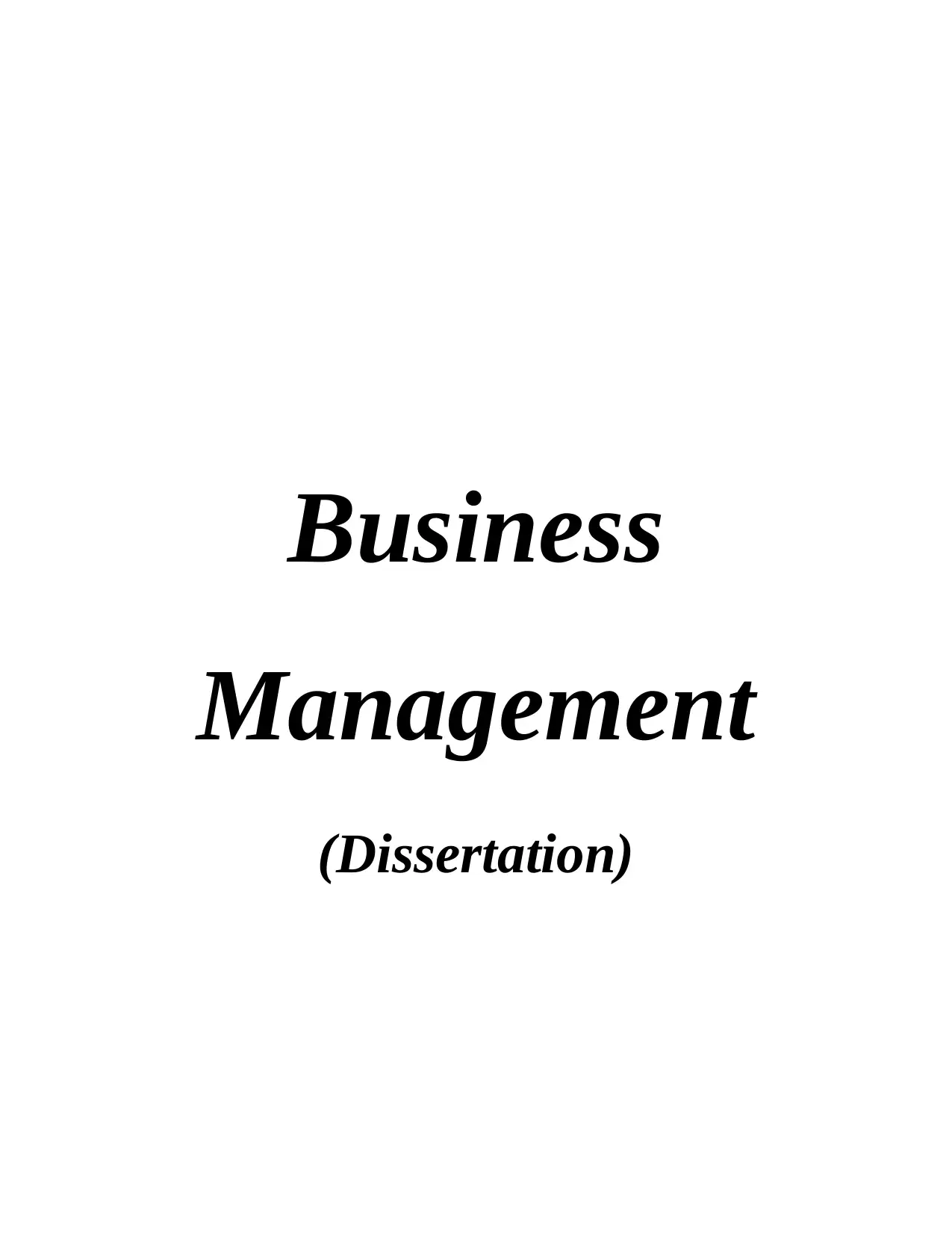
Business
Management
(Dissertation)
Management
(Dissertation)
Secure Best Marks with AI Grader
Need help grading? Try our AI Grader for instant feedback on your assignments.

ABSTRACT
This investigation is based on “The impact of organisational structure and culture over
the growth and success of an organisation”. Its main aim is to determine the actual impact of
organisational structure as well as culture over its success by conducting the qualitative
investigation which support in gathering larger amount of data while making use of theoretical
framework. For performing investigation several methods are being used such as primary data
collection performed with the help of questionnaire and the secondary investigation performed
using literature review where view point of authors are being gathered and critically evaluated to
develop understanding regarding the area of study.
By performing investigation it has been identified that there is a strong relationship
between the organisational culture and its structure as it has been determined that culture develop
the structure in which the operations flow. The investigation is performed in more systematic
manner which reveals each and every aspect of understanding determined from the evaluation. It
also suggested the practices implication of organisational culture and practices in effective
manner toward smooth flow of operations and adjustment of structure in a manner that leads to
maximum profitability and productivity.
This investigation is based on “The impact of organisational structure and culture over
the growth and success of an organisation”. Its main aim is to determine the actual impact of
organisational structure as well as culture over its success by conducting the qualitative
investigation which support in gathering larger amount of data while making use of theoretical
framework. For performing investigation several methods are being used such as primary data
collection performed with the help of questionnaire and the secondary investigation performed
using literature review where view point of authors are being gathered and critically evaluated to
develop understanding regarding the area of study.
By performing investigation it has been identified that there is a strong relationship
between the organisational culture and its structure as it has been determined that culture develop
the structure in which the operations flow. The investigation is performed in more systematic
manner which reveals each and every aspect of understanding determined from the evaluation. It
also suggested the practices implication of organisational culture and practices in effective
manner toward smooth flow of operations and adjustment of structure in a manner that leads to
maximum profitability and productivity.
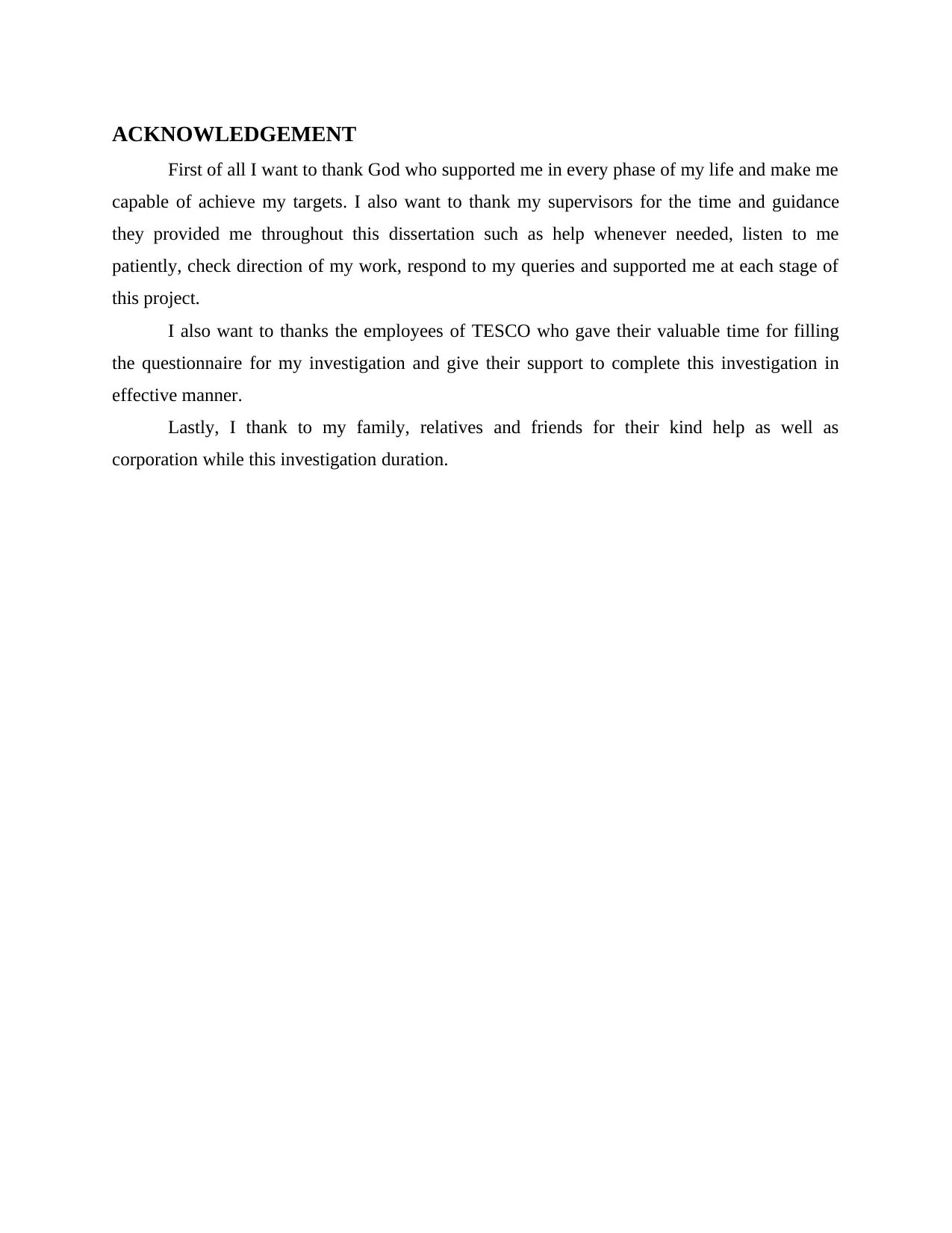
ACKNOWLEDGEMENT
First of all I want to thank God who supported me in every phase of my life and make me
capable of achieve my targets. I also want to thank my supervisors for the time and guidance
they provided me throughout this dissertation such as help whenever needed, listen to me
patiently, check direction of my work, respond to my queries and supported me at each stage of
this project.
I also want to thanks the employees of TESCO who gave their valuable time for filling
the questionnaire for my investigation and give their support to complete this investigation in
effective manner.
Lastly, I thank to my family, relatives and friends for their kind help as well as
corporation while this investigation duration.
First of all I want to thank God who supported me in every phase of my life and make me
capable of achieve my targets. I also want to thank my supervisors for the time and guidance
they provided me throughout this dissertation such as help whenever needed, listen to me
patiently, check direction of my work, respond to my queries and supported me at each stage of
this project.
I also want to thanks the employees of TESCO who gave their valuable time for filling
the questionnaire for my investigation and give their support to complete this investigation in
effective manner.
Lastly, I thank to my family, relatives and friends for their kind help as well as
corporation while this investigation duration.
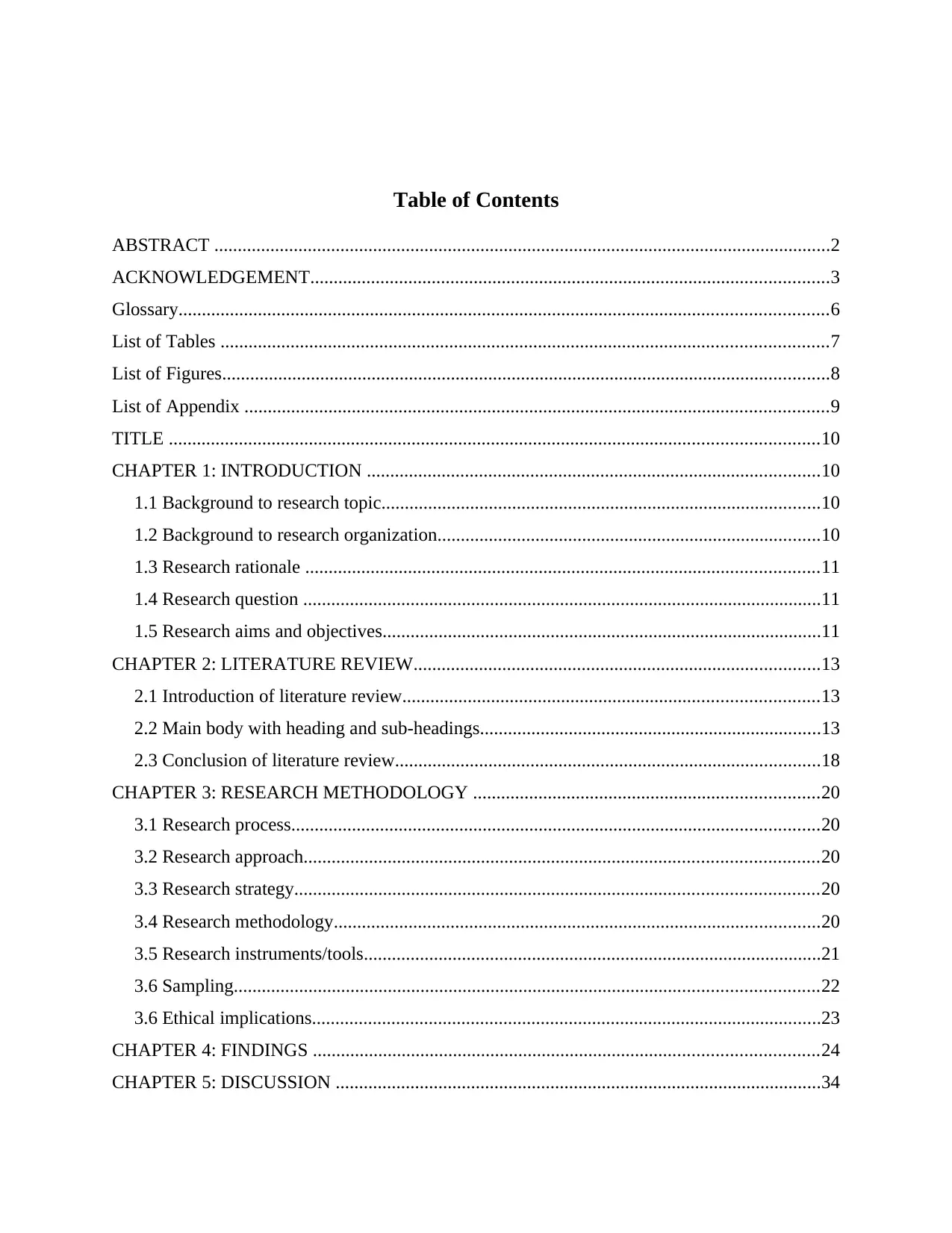
Table of Contents
ABSTRACT ....................................................................................................................................2
ACKNOWLEDGEMENT...............................................................................................................3
Glossary...........................................................................................................................................6
List of Tables ..................................................................................................................................7
List of Figures..................................................................................................................................8
List of Appendix .............................................................................................................................9
TITLE ...........................................................................................................................................10
CHAPTER 1: INTRODUCTION .................................................................................................10
1.1 Background to research topic..............................................................................................10
1.2 Background to research organization..................................................................................10
1.3 Research rationale ..............................................................................................................11
1.4 Research question ...............................................................................................................11
1.5 Research aims and objectives..............................................................................................11
CHAPTER 2: LITERATURE REVIEW.......................................................................................13
2.1 Introduction of literature review.........................................................................................13
2.2 Main body with heading and sub-headings.........................................................................13
2.3 Conclusion of literature review...........................................................................................18
CHAPTER 3: RESEARCH METHODOLOGY ..........................................................................20
3.1 Research process.................................................................................................................20
3.2 Research approach..............................................................................................................20
3.3 Research strategy................................................................................................................20
3.4 Research methodology........................................................................................................20
3.5 Research instruments/tools..................................................................................................21
3.6 Sampling.............................................................................................................................22
3.6 Ethical implications.............................................................................................................23
CHAPTER 4: FINDINGS ............................................................................................................24
CHAPTER 5: DISCUSSION ........................................................................................................34
ABSTRACT ....................................................................................................................................2
ACKNOWLEDGEMENT...............................................................................................................3
Glossary...........................................................................................................................................6
List of Tables ..................................................................................................................................7
List of Figures..................................................................................................................................8
List of Appendix .............................................................................................................................9
TITLE ...........................................................................................................................................10
CHAPTER 1: INTRODUCTION .................................................................................................10
1.1 Background to research topic..............................................................................................10
1.2 Background to research organization..................................................................................10
1.3 Research rationale ..............................................................................................................11
1.4 Research question ...............................................................................................................11
1.5 Research aims and objectives..............................................................................................11
CHAPTER 2: LITERATURE REVIEW.......................................................................................13
2.1 Introduction of literature review.........................................................................................13
2.2 Main body with heading and sub-headings.........................................................................13
2.3 Conclusion of literature review...........................................................................................18
CHAPTER 3: RESEARCH METHODOLOGY ..........................................................................20
3.1 Research process.................................................................................................................20
3.2 Research approach..............................................................................................................20
3.3 Research strategy................................................................................................................20
3.4 Research methodology........................................................................................................20
3.5 Research instruments/tools..................................................................................................21
3.6 Sampling.............................................................................................................................22
3.6 Ethical implications.............................................................................................................23
CHAPTER 4: FINDINGS ............................................................................................................24
CHAPTER 5: DISCUSSION ........................................................................................................34
Secure Best Marks with AI Grader
Need help grading? Try our AI Grader for instant feedback on your assignments.
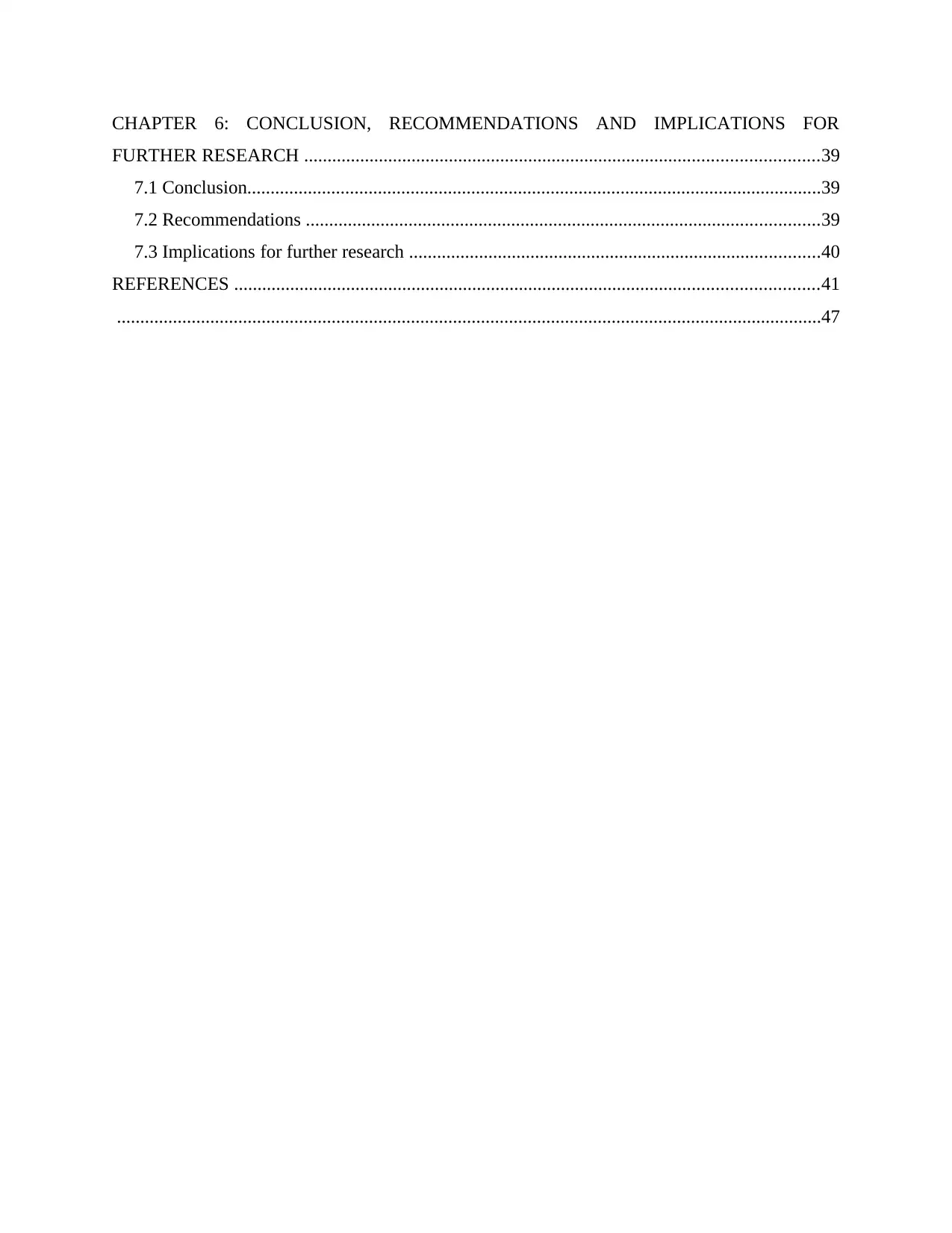
CHAPTER 6: CONCLUSION, RECOMMENDATIONS AND IMPLICATIONS FOR
FURTHER RESEARCH ..............................................................................................................39
7.1 Conclusion...........................................................................................................................39
7.2 Recommendations ..............................................................................................................39
7.3 Implications for further research ........................................................................................40
REFERENCES .............................................................................................................................41
.......................................................................................................................................................47
FURTHER RESEARCH ..............................................................................................................39
7.1 Conclusion...........................................................................................................................39
7.2 Recommendations ..............................................................................................................39
7.3 Implications for further research ........................................................................................40
REFERENCES .............................................................................................................................41
.......................................................................................................................................................47

Glossary
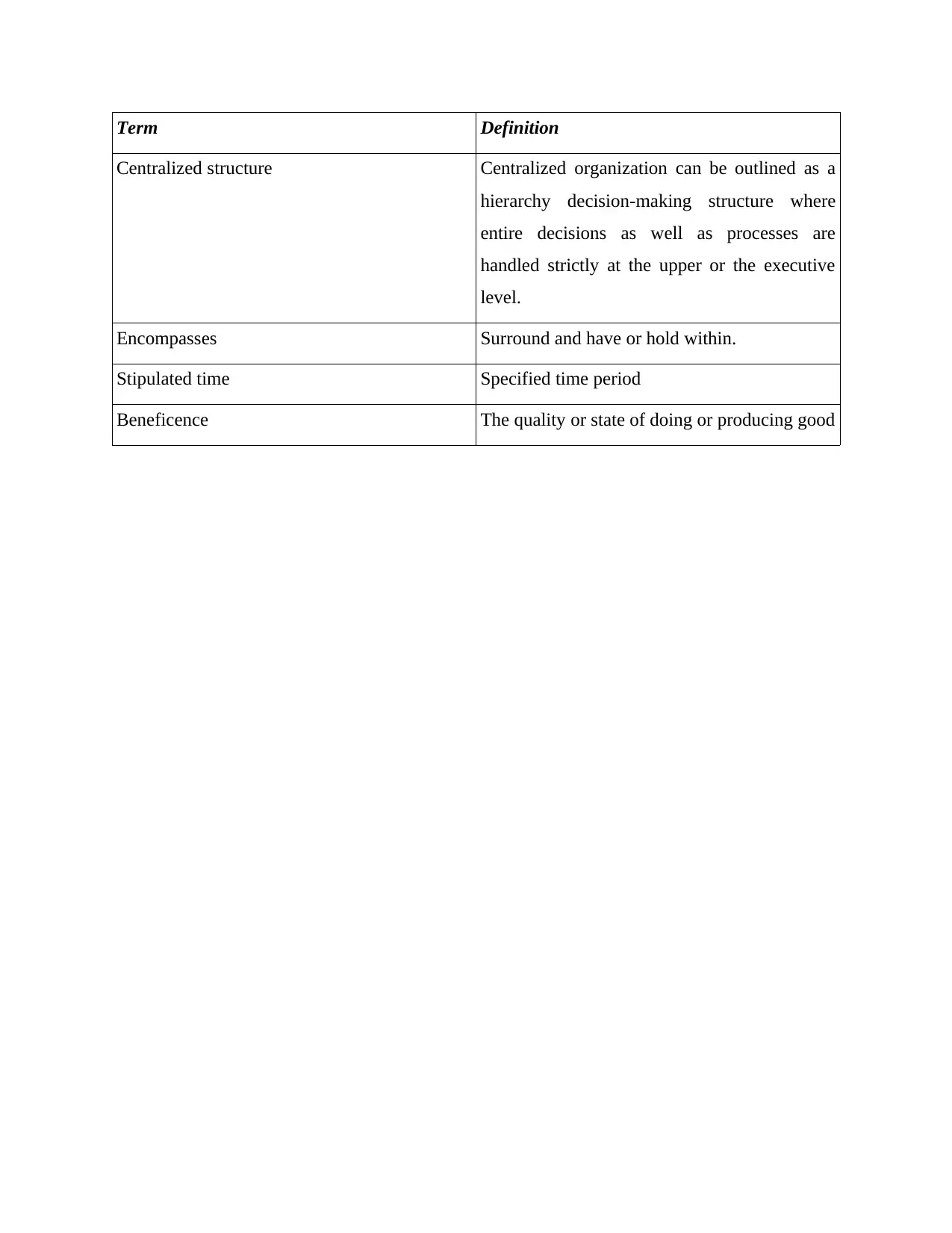
Term Definition
Centralized structure Centralized organization can be outlined as a
hierarchy decision-making structure where
entire decisions as well as processes are
handled strictly at the upper or the executive
level.
Encompasses Surround and have or hold within.
Stipulated time Specified time period
Beneficence The quality or state of doing or producing good
Centralized structure Centralized organization can be outlined as a
hierarchy decision-making structure where
entire decisions as well as processes are
handled strictly at the upper or the executive
level.
Encompasses Surround and have or hold within.
Stipulated time Specified time period
Beneficence The quality or state of doing or producing good
Paraphrase This Document
Need a fresh take? Get an instant paraphrase of this document with our AI Paraphraser
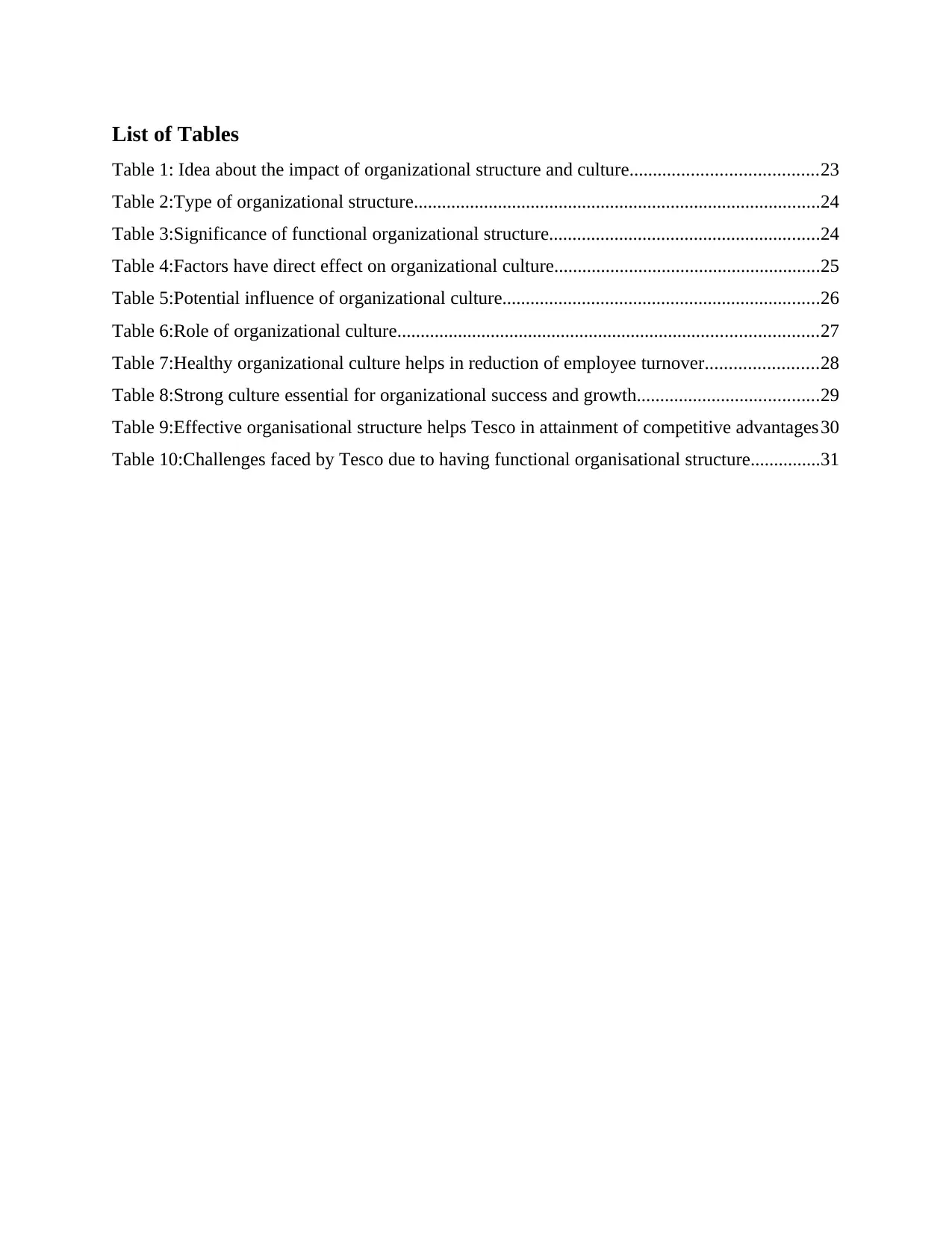
List of Tables
Table 1: Idea about the impact of organizational structure and culture........................................23
Table 2:Type of organizational structure.......................................................................................24
Table 3:Significance of functional organizational structure..........................................................24
Table 4:Factors have direct effect on organizational culture.........................................................25
Table 5:Potential influence of organizational culture....................................................................26
Table 6:Role of organizational culture..........................................................................................27
Table 7:Healthy organizational culture helps in reduction of employee turnover........................28
Table 8:Strong culture essential for organizational success and growth.......................................29
Table 9:Effective organisational structure helps Tesco in attainment of competitive advantages 30
Table 10:Challenges faced by Tesco due to having functional organisational structure...............31
Table 1: Idea about the impact of organizational structure and culture........................................23
Table 2:Type of organizational structure.......................................................................................24
Table 3:Significance of functional organizational structure..........................................................24
Table 4:Factors have direct effect on organizational culture.........................................................25
Table 5:Potential influence of organizational culture....................................................................26
Table 6:Role of organizational culture..........................................................................................27
Table 7:Healthy organizational culture helps in reduction of employee turnover........................28
Table 8:Strong culture essential for organizational success and growth.......................................29
Table 9:Effective organisational structure helps Tesco in attainment of competitive advantages 30
Table 10:Challenges faced by Tesco due to having functional organisational structure...............31

List of Figures
Figure 1: Idea about the impact of organizational structure and culture.......................................23
Figure 2:Type of organizational structure.....................................................................................24
Figure 3:Significance of functional organizational structure........................................................25
Figure 4:Factors have direct effect on organizational culture.......................................................26
Figure 5:Potential influence of organizational culture..................................................................27
Figure 6:Role of organizational culture.........................................................................................28
Figure 7:Healthy organizational culture helps in reduction of employee turnover.......................29
Figure 8:Strong culture essential for organizational success and growth......................................30
Figure 9:Effective organisational structure helps Tesco in attainment of competitive advantages
.......................................................................................................................................................31
Figure 10:Challenges faced by Tesco due to having function.......................................................32
Figure 1: Idea about the impact of organizational structure and culture.......................................23
Figure 2:Type of organizational structure.....................................................................................24
Figure 3:Significance of functional organizational structure........................................................25
Figure 4:Factors have direct effect on organizational culture.......................................................26
Figure 5:Potential influence of organizational culture..................................................................27
Figure 6:Role of organizational culture.........................................................................................28
Figure 7:Healthy organizational culture helps in reduction of employee turnover.......................29
Figure 8:Strong culture essential for organizational success and growth......................................30
Figure 9:Effective organisational structure helps Tesco in attainment of competitive advantages
.......................................................................................................................................................31
Figure 10:Challenges faced by Tesco due to having function.......................................................32
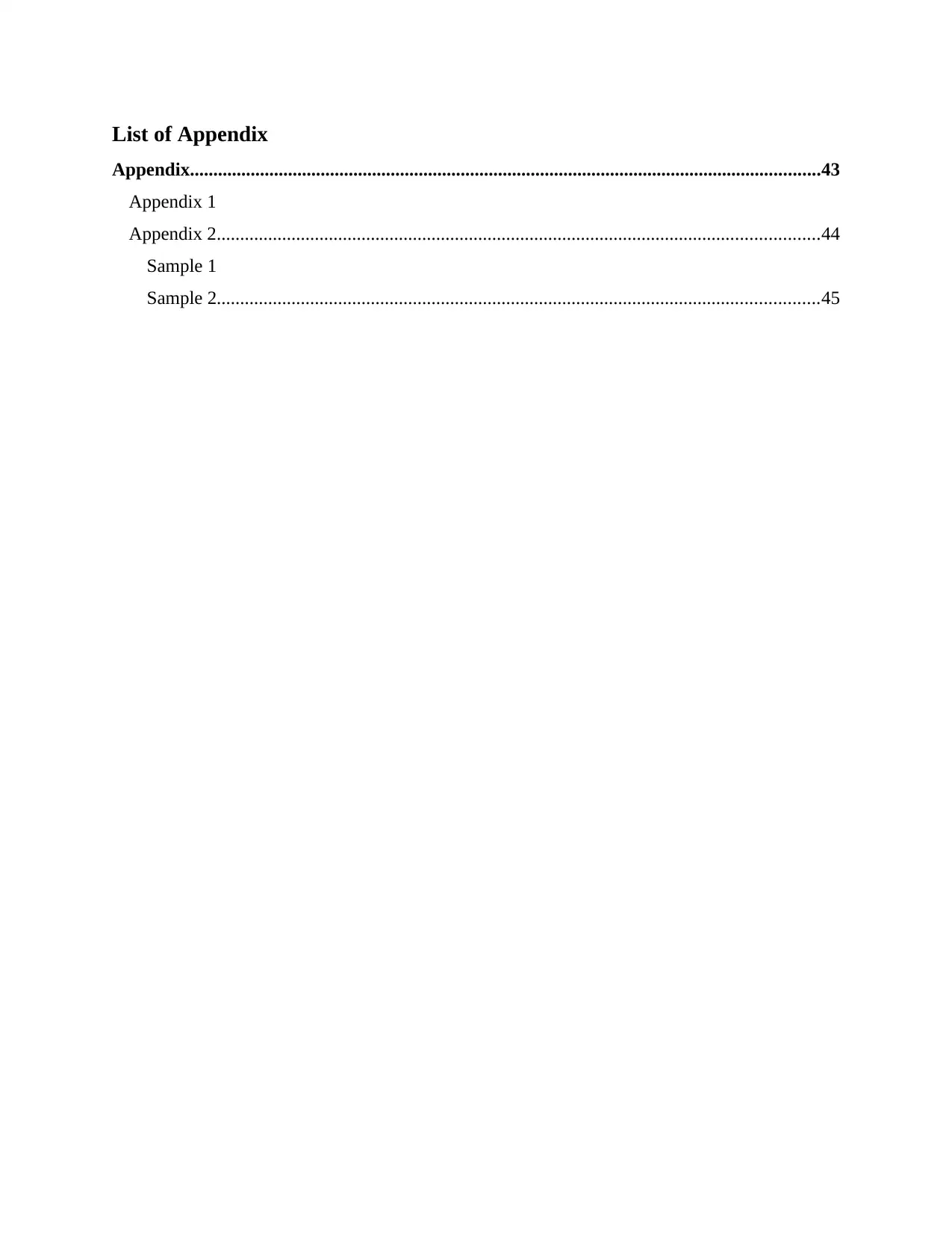
List of Appendix
Appendix.......................................................................................................................................43
Appendix 1
Appendix 2.................................................................................................................................44
Sample 1
Sample 2.................................................................................................................................45
Appendix.......................................................................................................................................43
Appendix 1
Appendix 2.................................................................................................................................44
Sample 1
Sample 2.................................................................................................................................45
Secure Best Marks with AI Grader
Need help grading? Try our AI Grader for instant feedback on your assignments.
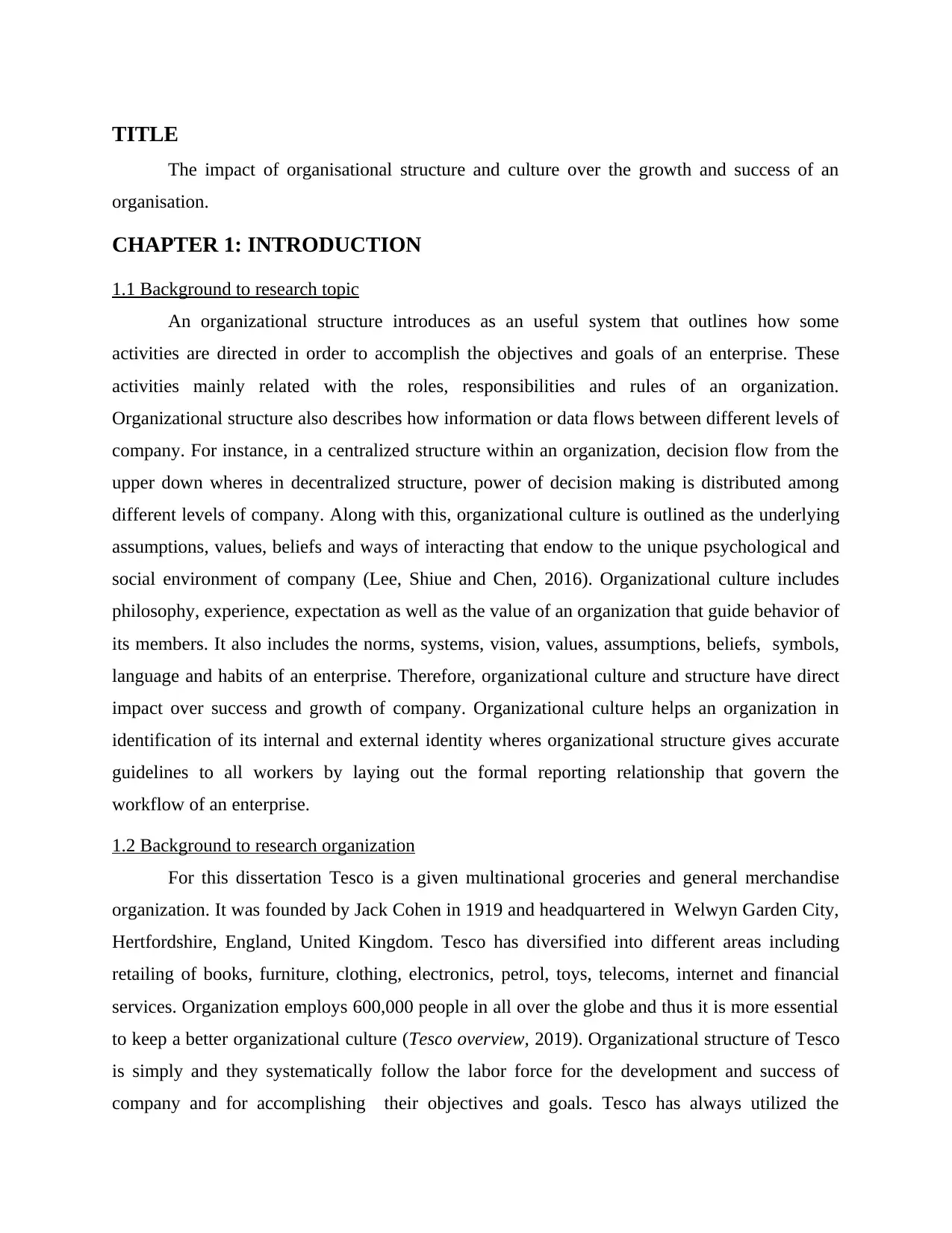
TITLE
The impact of organisational structure and culture over the growth and success of an
organisation.
CHAPTER 1: INTRODUCTION
1.1 Background to research topic
An organizational structure introduces as an useful system that outlines how some
activities are directed in order to accomplish the objectives and goals of an enterprise. These
activities mainly related with the roles, responsibilities and rules of an organization.
Organizational structure also describes how information or data flows between different levels of
company. For instance, in a centralized structure within an organization, decision flow from the
upper down wheres in decentralized structure, power of decision making is distributed among
different levels of company. Along with this, organizational culture is outlined as the underlying
assumptions, values, beliefs and ways of interacting that endow to the unique psychological and
social environment of company (Lee, Shiue and Chen, 2016). Organizational culture includes
philosophy, experience, expectation as well as the value of an organization that guide behavior of
its members. It also includes the norms, systems, vision, values, assumptions, beliefs, symbols,
language and habits of an enterprise. Therefore, organizational culture and structure have direct
impact over success and growth of company. Organizational culture helps an organization in
identification of its internal and external identity wheres organizational structure gives accurate
guidelines to all workers by laying out the formal reporting relationship that govern the
workflow of an enterprise.
1.2 Background to research organization
For this dissertation Tesco is a given multinational groceries and general merchandise
organization. It was founded by Jack Cohen in 1919 and headquartered in Welwyn Garden City,
Hertfordshire, England, United Kingdom. Tesco has diversified into different areas including
retailing of books, furniture, clothing, electronics, petrol, toys, telecoms, internet and financial
services. Organization employs 600,000 people in all over the globe and thus it is more essential
to keep a better organizational culture (Tesco overview, 2019). Organizational structure of Tesco
is simply and they systematically follow the labor force for the development and success of
company and for accomplishing their objectives and goals. Tesco has always utilized the
The impact of organisational structure and culture over the growth and success of an
organisation.
CHAPTER 1: INTRODUCTION
1.1 Background to research topic
An organizational structure introduces as an useful system that outlines how some
activities are directed in order to accomplish the objectives and goals of an enterprise. These
activities mainly related with the roles, responsibilities and rules of an organization.
Organizational structure also describes how information or data flows between different levels of
company. For instance, in a centralized structure within an organization, decision flow from the
upper down wheres in decentralized structure, power of decision making is distributed among
different levels of company. Along with this, organizational culture is outlined as the underlying
assumptions, values, beliefs and ways of interacting that endow to the unique psychological and
social environment of company (Lee, Shiue and Chen, 2016). Organizational culture includes
philosophy, experience, expectation as well as the value of an organization that guide behavior of
its members. It also includes the norms, systems, vision, values, assumptions, beliefs, symbols,
language and habits of an enterprise. Therefore, organizational culture and structure have direct
impact over success and growth of company. Organizational culture helps an organization in
identification of its internal and external identity wheres organizational structure gives accurate
guidelines to all workers by laying out the formal reporting relationship that govern the
workflow of an enterprise.
1.2 Background to research organization
For this dissertation Tesco is a given multinational groceries and general merchandise
organization. It was founded by Jack Cohen in 1919 and headquartered in Welwyn Garden City,
Hertfordshire, England, United Kingdom. Tesco has diversified into different areas including
retailing of books, furniture, clothing, electronics, petrol, toys, telecoms, internet and financial
services. Organization employs 600,000 people in all over the globe and thus it is more essential
to keep a better organizational culture (Tesco overview, 2019). Organizational structure of Tesco
is simply and they systematically follow the labor force for the development and success of
company and for accomplishing their objectives and goals. Tesco has always utilized the

implementation of technological and innovation improvement in the service provision and it has
improved the employee's efficiency in effective manner. In each store of the company, Tesco
managers are provided a better control with the employees and the managers work more
effectively in order to manage their operations as well as keeping a favorable culture with proper
cooperation and communication. There are different features of organizational structure at Tesco
such as employee empowerment is high, decentralized decision making, flexible working
environment, shared friendly culture etc. These features have direct impact over success and
growth of company by increasing loyalty of employee, maximizing adaptability to change and so
on.
1.3 Research rationale
Main rationale behind selecting this topic or dissertation is to identifying impact of
organizational culture and structure on success and growth of company. This research is
important in personal as well as professional manner. In personal way, this investigation helps
researcher by enhancing its skills and capabilities such as data analysis, data collection, literature
review, time management, communication and so on (Fraj, Matute and Melero, 2015). With the
help of this skills researcher become more able to perform research activities in systematic
manner. This investigation will also support in professional or educational way by increasing
understanding of an individual in context of organizational culture and structure, and its impact
over business success and growth of company.
1.4 Research question
What is the concept of organisational structure and culture in the context of business?
What is the significance of functional organisational structure in the context of Tesco?
What is the potential influence of functional organisational structure and culture over the
growth and development of Tesco?
1.5 Research aims and objectives
Research aim
Main aim of this research is "To investigate the effect of organisational structure
(Functional) and culture over the growth and success of an organization". A case study on Tesco.
Research Objectives
To interpret the concept of organisational structure and culture in the context of business.
improved the employee's efficiency in effective manner. In each store of the company, Tesco
managers are provided a better control with the employees and the managers work more
effectively in order to manage their operations as well as keeping a favorable culture with proper
cooperation and communication. There are different features of organizational structure at Tesco
such as employee empowerment is high, decentralized decision making, flexible working
environment, shared friendly culture etc. These features have direct impact over success and
growth of company by increasing loyalty of employee, maximizing adaptability to change and so
on.
1.3 Research rationale
Main rationale behind selecting this topic or dissertation is to identifying impact of
organizational culture and structure on success and growth of company. This research is
important in personal as well as professional manner. In personal way, this investigation helps
researcher by enhancing its skills and capabilities such as data analysis, data collection, literature
review, time management, communication and so on (Fraj, Matute and Melero, 2015). With the
help of this skills researcher become more able to perform research activities in systematic
manner. This investigation will also support in professional or educational way by increasing
understanding of an individual in context of organizational culture and structure, and its impact
over business success and growth of company.
1.4 Research question
What is the concept of organisational structure and culture in the context of business?
What is the significance of functional organisational structure in the context of Tesco?
What is the potential influence of functional organisational structure and culture over the
growth and development of Tesco?
1.5 Research aims and objectives
Research aim
Main aim of this research is "To investigate the effect of organisational structure
(Functional) and culture over the growth and success of an organization". A case study on Tesco.
Research Objectives
To interpret the concept of organisational structure and culture in the context of business.
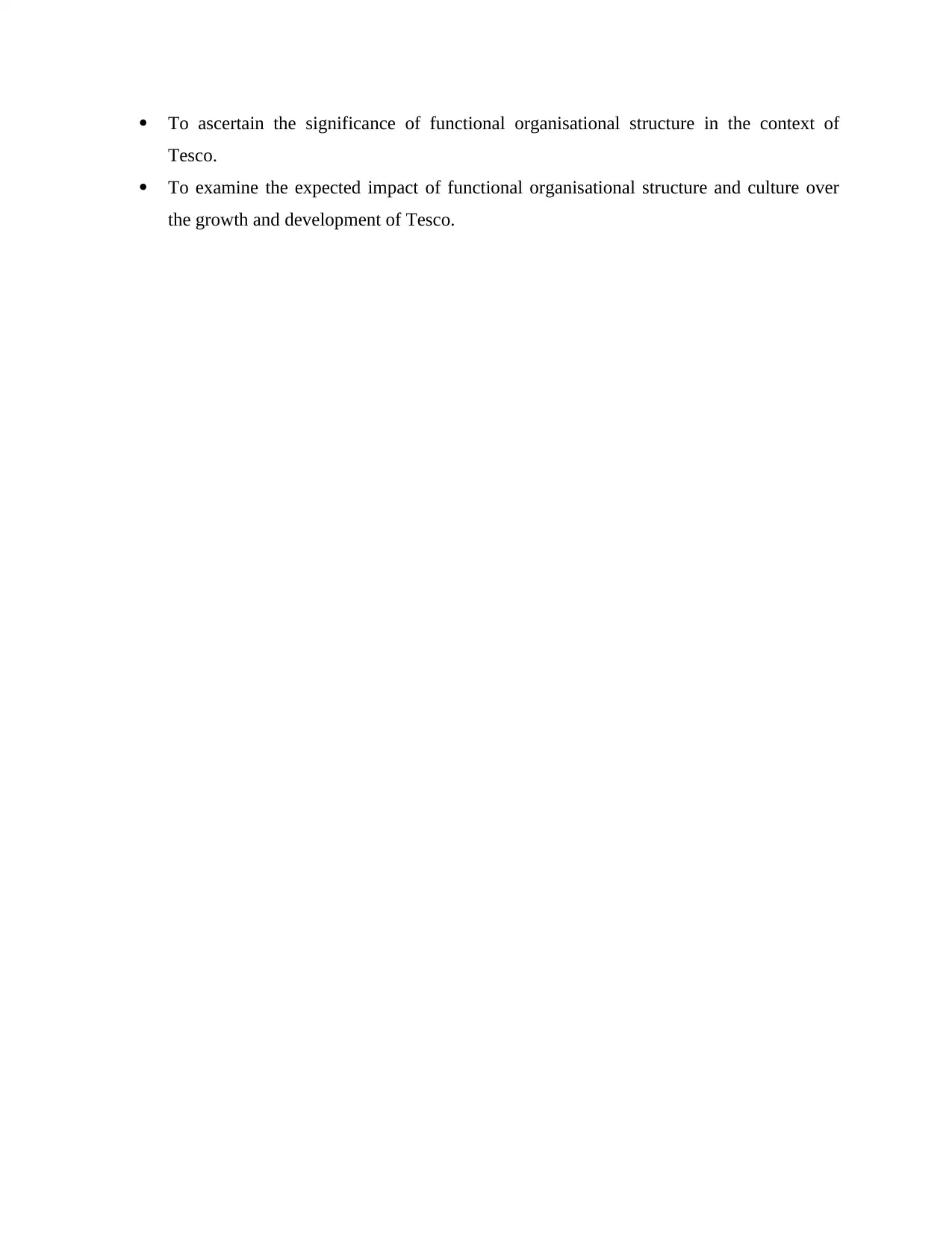
To ascertain the significance of functional organisational structure in the context of
Tesco.
To examine the expected impact of functional organisational structure and culture over
the growth and development of Tesco.
Tesco.
To examine the expected impact of functional organisational structure and culture over
the growth and development of Tesco.
Paraphrase This Document
Need a fresh take? Get an instant paraphrase of this document with our AI Paraphraser
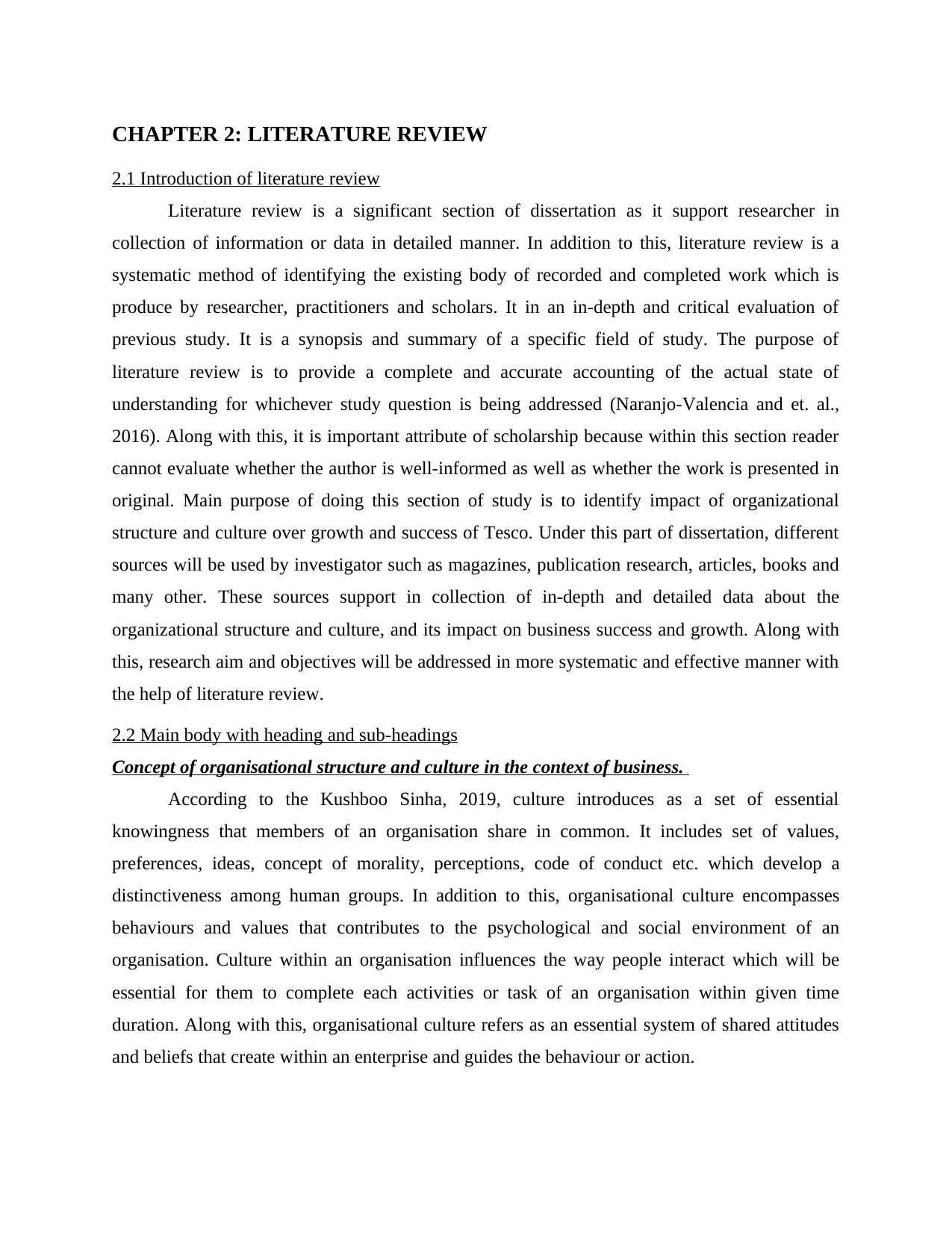
CHAPTER 2: LITERATURE REVIEW
2.1 Introduction of literature review
Literature review is a significant section of dissertation as it support researcher in
collection of information or data in detailed manner. In addition to this, literature review is a
systematic method of identifying the existing body of recorded and completed work which is
produce by researcher, practitioners and scholars. It in an in-depth and critical evaluation of
previous study. It is a synopsis and summary of a specific field of study. The purpose of
literature review is to provide a complete and accurate accounting of the actual state of
understanding for whichever study question is being addressed (Naranjo-Valencia and et. al.,
2016). Along with this, it is important attribute of scholarship because within this section reader
cannot evaluate whether the author is well-informed as well as whether the work is presented in
original. Main purpose of doing this section of study is to identify impact of organizational
structure and culture over growth and success of Tesco. Under this part of dissertation, different
sources will be used by investigator such as magazines, publication research, articles, books and
many other. These sources support in collection of in-depth and detailed data about the
organizational structure and culture, and its impact on business success and growth. Along with
this, research aim and objectives will be addressed in more systematic and effective manner with
the help of literature review.
2.2 Main body with heading and sub-headings
Concept of organisational structure and culture in the context of business.
According to the Kushboo Sinha, 2019, culture introduces as a set of essential
knowingness that members of an organisation share in common. It includes set of values,
preferences, ideas, concept of morality, perceptions, code of conduct etc. which develop a
distinctiveness among human groups. In addition to this, organisational culture encompasses
behaviours and values that contributes to the psychological and social environment of an
organisation. Culture within an organisation influences the way people interact which will be
essential for them to complete each activities or task of an organisation within given time
duration. Along with this, organisational culture refers as an essential system of shared attitudes
and beliefs that create within an enterprise and guides the behaviour or action.
2.1 Introduction of literature review
Literature review is a significant section of dissertation as it support researcher in
collection of information or data in detailed manner. In addition to this, literature review is a
systematic method of identifying the existing body of recorded and completed work which is
produce by researcher, practitioners and scholars. It in an in-depth and critical evaluation of
previous study. It is a synopsis and summary of a specific field of study. The purpose of
literature review is to provide a complete and accurate accounting of the actual state of
understanding for whichever study question is being addressed (Naranjo-Valencia and et. al.,
2016). Along with this, it is important attribute of scholarship because within this section reader
cannot evaluate whether the author is well-informed as well as whether the work is presented in
original. Main purpose of doing this section of study is to identify impact of organizational
structure and culture over growth and success of Tesco. Under this part of dissertation, different
sources will be used by investigator such as magazines, publication research, articles, books and
many other. These sources support in collection of in-depth and detailed data about the
organizational structure and culture, and its impact on business success and growth. Along with
this, research aim and objectives will be addressed in more systematic and effective manner with
the help of literature review.
2.2 Main body with heading and sub-headings
Concept of organisational structure and culture in the context of business.
According to the Kushboo Sinha, 2019, culture introduces as a set of essential
knowingness that members of an organisation share in common. It includes set of values,
preferences, ideas, concept of morality, perceptions, code of conduct etc. which develop a
distinctiveness among human groups. In addition to this, organisational culture encompasses
behaviours and values that contributes to the psychological and social environment of an
organisation. Culture within an organisation influences the way people interact which will be
essential for them to complete each activities or task of an organisation within given time
duration. Along with this, organisational culture refers as an essential system of shared attitudes
and beliefs that create within an enterprise and guides the behaviour or action.

As per the view presented by Carvalho and et. al., 2019, that organisation culture has
major significance on the overall performance of the company as it influences working style of
the employees. There are different types of culture which are followed in the enterprise like
power, role, task etc. Each one of these has their own positives and negatives. The author says
that companies who follow the healthy culture has more employee retention rate. It is because
when a person feels comfortable and is happy with the working style of the firm they do full
capacity utilisation of the resources and like to come office daily. This further reduces the
absenteeism which again has its positive and direct impact on the companies results. from the
organisation culture it can be determined that what is the vision of the company and what is the
mind-set of its management. It is believed that executives who follow culture in which the work
force is given importance are thoughtful for the individual rights and are fulfilling their corporate
responsibility. Culture of the firm is directly associated with the structure.
As per the view presented by Will Kenton, organisational structure introduces as a system
that outlines number of activities that are directed in order to accomplish organisational goals
and objectives easily. These activities mainly related to the rules, roles and responsibilities
within an organisation. Organisational structure also determines or describes how information
will be communicated between different levels of an enterprise. In addition to this, it is a system
that is followed to define hierarchy of an enterprise. This structure is developed to found how an
enterprise operates and supports an enterprise in obtaining its long term goals and objectives to
allow for future success and growth. There are different types of organisational structure such as
functional, divisional, Matrix and Flatarchy. These are main types of organisational structure
which will be beneficial for success and growth of an organisation. In addition, organisation
structure is an effective framework or system in relations on jobs, operating process and group
making efforts to accomplish the goals and objectives. It also introduces to the models and
framework of internal relations of enterprise, power, formal communication channels, relation
and reporting, responsibility, decision making delegation and many other. Effective
organisational structure will be more beneficial and valuable for the growth of company. As it
will support them in retaining employees for long time and also assist them to attract large
number of customers easily.
According to the Pfadenhauer and et. al, 2017, says that if in any organisation the
structure is complex then power culture is followed there as management do not believe in
major significance on the overall performance of the company as it influences working style of
the employees. There are different types of culture which are followed in the enterprise like
power, role, task etc. Each one of these has their own positives and negatives. The author says
that companies who follow the healthy culture has more employee retention rate. It is because
when a person feels comfortable and is happy with the working style of the firm they do full
capacity utilisation of the resources and like to come office daily. This further reduces the
absenteeism which again has its positive and direct impact on the companies results. from the
organisation culture it can be determined that what is the vision of the company and what is the
mind-set of its management. It is believed that executives who follow culture in which the work
force is given importance are thoughtful for the individual rights and are fulfilling their corporate
responsibility. Culture of the firm is directly associated with the structure.
As per the view presented by Will Kenton, organisational structure introduces as a system
that outlines number of activities that are directed in order to accomplish organisational goals
and objectives easily. These activities mainly related to the rules, roles and responsibilities
within an organisation. Organisational structure also determines or describes how information
will be communicated between different levels of an enterprise. In addition to this, it is a system
that is followed to define hierarchy of an enterprise. This structure is developed to found how an
enterprise operates and supports an enterprise in obtaining its long term goals and objectives to
allow for future success and growth. There are different types of organisational structure such as
functional, divisional, Matrix and Flatarchy. These are main types of organisational structure
which will be beneficial for success and growth of an organisation. In addition, organisation
structure is an effective framework or system in relations on jobs, operating process and group
making efforts to accomplish the goals and objectives. It also introduces to the models and
framework of internal relations of enterprise, power, formal communication channels, relation
and reporting, responsibility, decision making delegation and many other. Effective
organisational structure will be more beneficial and valuable for the growth of company. As it
will support them in retaining employees for long time and also assist them to attract large
number of customers easily.
According to the Pfadenhauer and et. al, 2017, says that if in any organisation the
structure is complex then power culture is followed there as management do not believe in
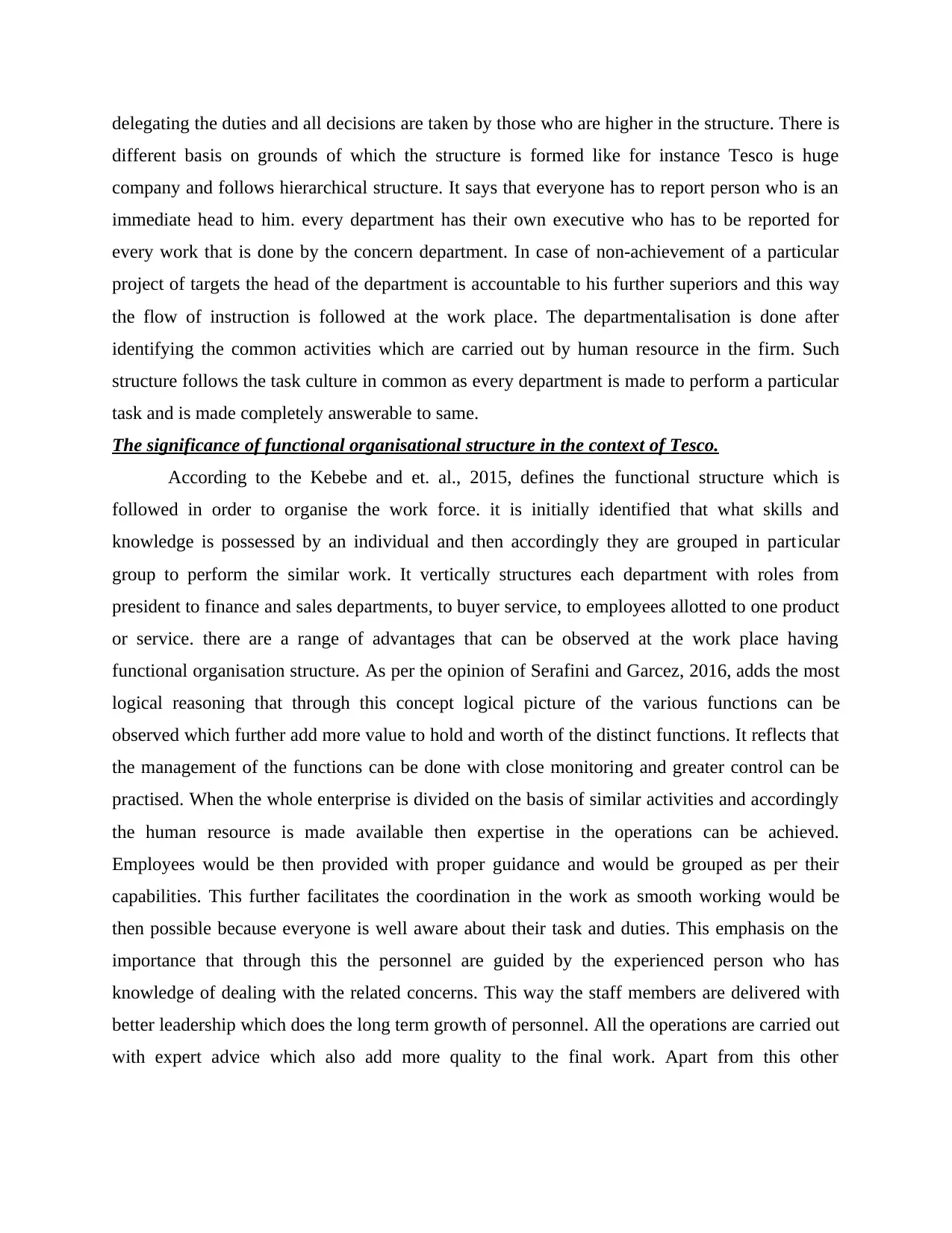
delegating the duties and all decisions are taken by those who are higher in the structure. There is
different basis on grounds of which the structure is formed like for instance Tesco is huge
company and follows hierarchical structure. It says that everyone has to report person who is an
immediate head to him. every department has their own executive who has to be reported for
every work that is done by the concern department. In case of non-achievement of a particular
project of targets the head of the department is accountable to his further superiors and this way
the flow of instruction is followed at the work place. The departmentalisation is done after
identifying the common activities which are carried out by human resource in the firm. Such
structure follows the task culture in common as every department is made to perform a particular
task and is made completely answerable to same.
The significance of functional organisational structure in the context of Tesco.
According to the Kebebe and et. al., 2015, defines the functional structure which is
followed in order to organise the work force. it is initially identified that what skills and
knowledge is possessed by an individual and then accordingly they are grouped in particular
group to perform the similar work. It vertically structures each department with roles from
president to finance and sales departments, to buyer service, to employees allotted to one product
or service. there are a range of advantages that can be observed at the work place having
functional organisation structure. As per the opinion of Serafini and Garcez, 2016, adds the most
logical reasoning that through this concept logical picture of the various functions can be
observed which further add more value to hold and worth of the distinct functions. It reflects that
the management of the functions can be done with close monitoring and greater control can be
practised. When the whole enterprise is divided on the basis of similar activities and accordingly
the human resource is made available then expertise in the operations can be achieved.
Employees would be then provided with proper guidance and would be grouped as per their
capabilities. This further facilitates the coordination in the work as smooth working would be
then possible because everyone is well aware about their task and duties. This emphasis on the
importance that through this the personnel are guided by the experienced person who has
knowledge of dealing with the related concerns. This way the staff members are delivered with
better leadership which does the long term growth of personnel. All the operations are carried out
with expert advice which also add more quality to the final work. Apart from this other
different basis on grounds of which the structure is formed like for instance Tesco is huge
company and follows hierarchical structure. It says that everyone has to report person who is an
immediate head to him. every department has their own executive who has to be reported for
every work that is done by the concern department. In case of non-achievement of a particular
project of targets the head of the department is accountable to his further superiors and this way
the flow of instruction is followed at the work place. The departmentalisation is done after
identifying the common activities which are carried out by human resource in the firm. Such
structure follows the task culture in common as every department is made to perform a particular
task and is made completely answerable to same.
The significance of functional organisational structure in the context of Tesco.
According to the Kebebe and et. al., 2015, defines the functional structure which is
followed in order to organise the work force. it is initially identified that what skills and
knowledge is possessed by an individual and then accordingly they are grouped in particular
group to perform the similar work. It vertically structures each department with roles from
president to finance and sales departments, to buyer service, to employees allotted to one product
or service. there are a range of advantages that can be observed at the work place having
functional organisation structure. As per the opinion of Serafini and Garcez, 2016, adds the most
logical reasoning that through this concept logical picture of the various functions can be
observed which further add more value to hold and worth of the distinct functions. It reflects that
the management of the functions can be done with close monitoring and greater control can be
practised. When the whole enterprise is divided on the basis of similar activities and accordingly
the human resource is made available then expertise in the operations can be achieved.
Employees would be then provided with proper guidance and would be grouped as per their
capabilities. This further facilitates the coordination in the work as smooth working would be
then possible because everyone is well aware about their task and duties. This emphasis on the
importance that through this the personnel are guided by the experienced person who has
knowledge of dealing with the related concerns. This way the staff members are delivered with
better leadership which does the long term growth of personnel. All the operations are carried out
with expert advice which also add more quality to the final work. Apart from this other
Secure Best Marks with AI Grader
Need help grading? Try our AI Grader for instant feedback on your assignments.
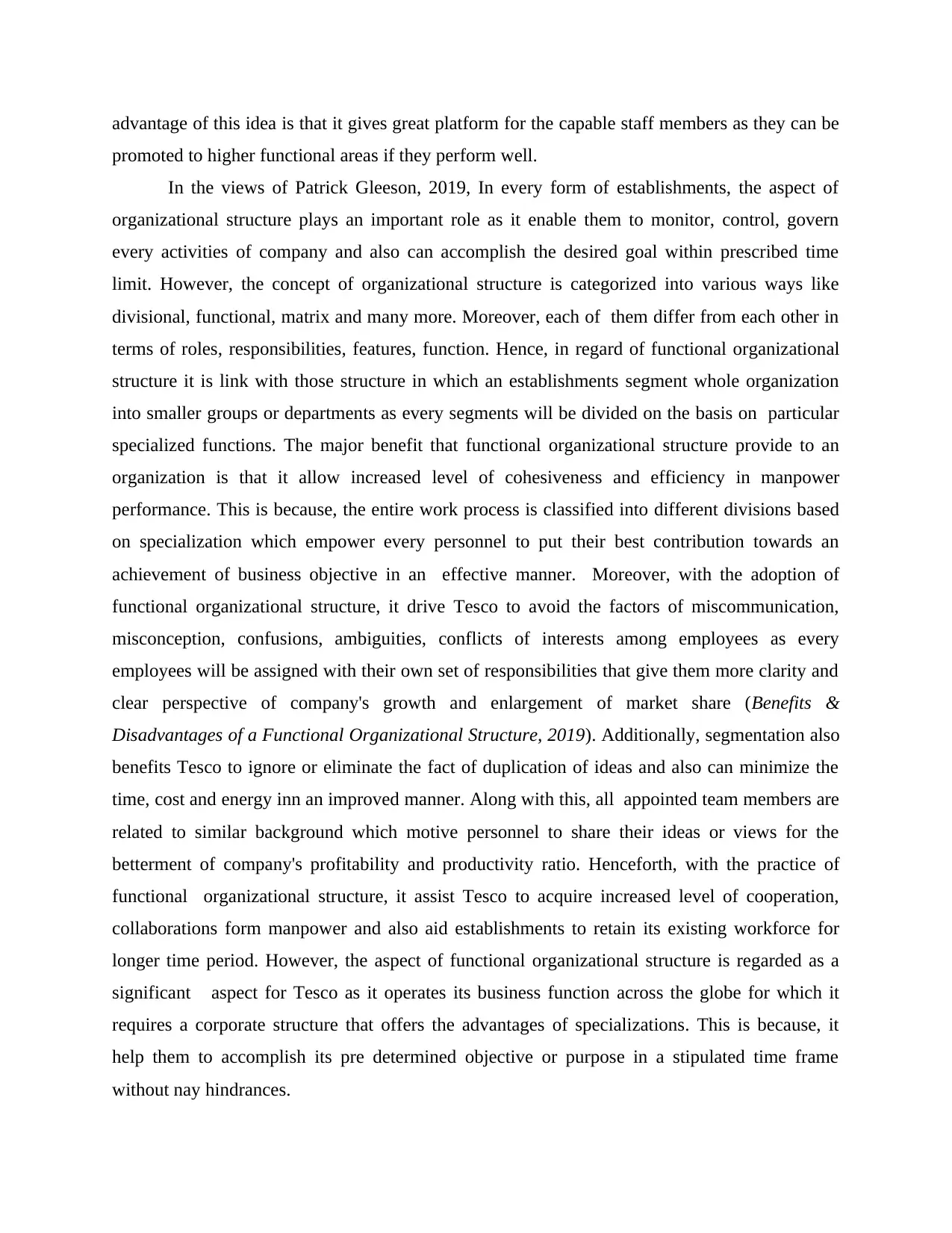
advantage of this idea is that it gives great platform for the capable staff members as they can be
promoted to higher functional areas if they perform well.
In the views of Patrick Gleeson, 2019, In every form of establishments, the aspect of
organizational structure plays an important role as it enable them to monitor, control, govern
every activities of company and also can accomplish the desired goal within prescribed time
limit. However, the concept of organizational structure is categorized into various ways like
divisional, functional, matrix and many more. Moreover, each of them differ from each other in
terms of roles, responsibilities, features, function. Hence, in regard of functional organizational
structure it is link with those structure in which an establishments segment whole organization
into smaller groups or departments as every segments will be divided on the basis on particular
specialized functions. The major benefit that functional organizational structure provide to an
organization is that it allow increased level of cohesiveness and efficiency in manpower
performance. This is because, the entire work process is classified into different divisions based
on specialization which empower every personnel to put their best contribution towards an
achievement of business objective in an effective manner. Moreover, with the adoption of
functional organizational structure, it drive Tesco to avoid the factors of miscommunication,
misconception, confusions, ambiguities, conflicts of interests among employees as every
employees will be assigned with their own set of responsibilities that give them more clarity and
clear perspective of company's growth and enlargement of market share (Benefits &
Disadvantages of a Functional Organizational Structure, 2019). Additionally, segmentation also
benefits Tesco to ignore or eliminate the fact of duplication of ideas and also can minimize the
time, cost and energy inn an improved manner. Along with this, all appointed team members are
related to similar background which motive personnel to share their ideas or views for the
betterment of company's profitability and productivity ratio. Henceforth, with the practice of
functional organizational structure, it assist Tesco to acquire increased level of cooperation,
collaborations form manpower and also aid establishments to retain its existing workforce for
longer time period. However, the aspect of functional organizational structure is regarded as a
significant aspect for Tesco as it operates its business function across the globe for which it
requires a corporate structure that offers the advantages of specializations. This is because, it
help them to accomplish its pre determined objective or purpose in a stipulated time frame
without nay hindrances.
promoted to higher functional areas if they perform well.
In the views of Patrick Gleeson, 2019, In every form of establishments, the aspect of
organizational structure plays an important role as it enable them to monitor, control, govern
every activities of company and also can accomplish the desired goal within prescribed time
limit. However, the concept of organizational structure is categorized into various ways like
divisional, functional, matrix and many more. Moreover, each of them differ from each other in
terms of roles, responsibilities, features, function. Hence, in regard of functional organizational
structure it is link with those structure in which an establishments segment whole organization
into smaller groups or departments as every segments will be divided on the basis on particular
specialized functions. The major benefit that functional organizational structure provide to an
organization is that it allow increased level of cohesiveness and efficiency in manpower
performance. This is because, the entire work process is classified into different divisions based
on specialization which empower every personnel to put their best contribution towards an
achievement of business objective in an effective manner. Moreover, with the adoption of
functional organizational structure, it drive Tesco to avoid the factors of miscommunication,
misconception, confusions, ambiguities, conflicts of interests among employees as every
employees will be assigned with their own set of responsibilities that give them more clarity and
clear perspective of company's growth and enlargement of market share (Benefits &
Disadvantages of a Functional Organizational Structure, 2019). Additionally, segmentation also
benefits Tesco to ignore or eliminate the fact of duplication of ideas and also can minimize the
time, cost and energy inn an improved manner. Along with this, all appointed team members are
related to similar background which motive personnel to share their ideas or views for the
betterment of company's profitability and productivity ratio. Henceforth, with the practice of
functional organizational structure, it assist Tesco to acquire increased level of cooperation,
collaborations form manpower and also aid establishments to retain its existing workforce for
longer time period. However, the aspect of functional organizational structure is regarded as a
significant aspect for Tesco as it operates its business function across the globe for which it
requires a corporate structure that offers the advantages of specializations. This is because, it
help them to accomplish its pre determined objective or purpose in a stipulated time frame
without nay hindrances.
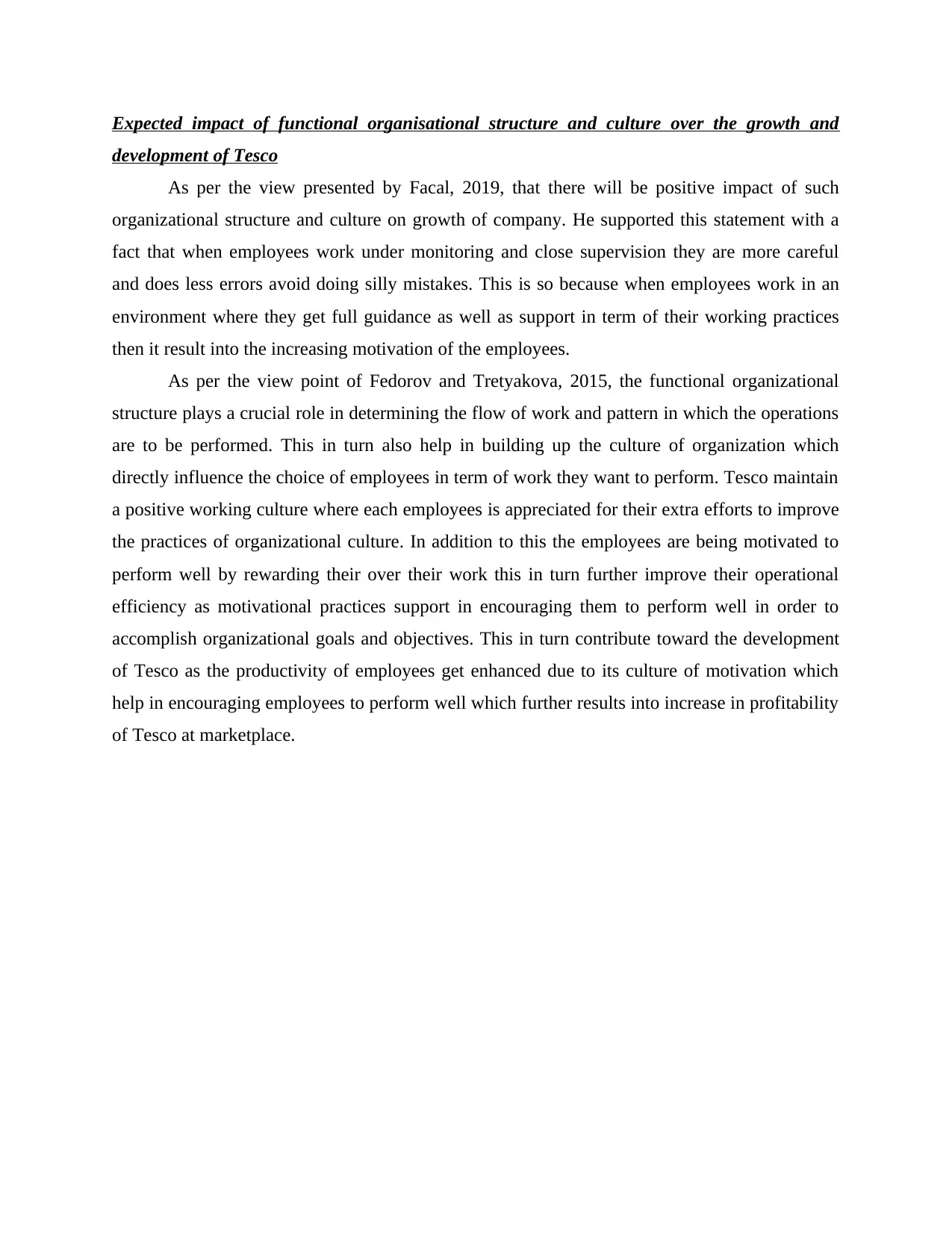
Expected impact of functional organisational structure and culture over the growth and
development of Tesco
As per the view presented by Facal, 2019, that there will be positive impact of such
organizational structure and culture on growth of company. He supported this statement with a
fact that when employees work under monitoring and close supervision they are more careful
and does less errors avoid doing silly mistakes. This is so because when employees work in an
environment where they get full guidance as well as support in term of their working practices
then it result into the increasing motivation of the employees.
As per the view point of Fedorov and Tretyakova, 2015, the functional organizational
structure plays a crucial role in determining the flow of work and pattern in which the operations
are to be performed. This in turn also help in building up the culture of organization which
directly influence the choice of employees in term of work they want to perform. Tesco maintain
a positive working culture where each employees is appreciated for their extra efforts to improve
the practices of organizational culture. In addition to this the employees are being motivated to
perform well by rewarding their over their work this in turn further improve their operational
efficiency as motivational practices support in encouraging them to perform well in order to
accomplish organizational goals and objectives. This in turn contribute toward the development
of Tesco as the productivity of employees get enhanced due to its culture of motivation which
help in encouraging employees to perform well which further results into increase in profitability
of Tesco at marketplace.
development of Tesco
As per the view presented by Facal, 2019, that there will be positive impact of such
organizational structure and culture on growth of company. He supported this statement with a
fact that when employees work under monitoring and close supervision they are more careful
and does less errors avoid doing silly mistakes. This is so because when employees work in an
environment where they get full guidance as well as support in term of their working practices
then it result into the increasing motivation of the employees.
As per the view point of Fedorov and Tretyakova, 2015, the functional organizational
structure plays a crucial role in determining the flow of work and pattern in which the operations
are to be performed. This in turn also help in building up the culture of organization which
directly influence the choice of employees in term of work they want to perform. Tesco maintain
a positive working culture where each employees is appreciated for their extra efforts to improve
the practices of organizational culture. In addition to this the employees are being motivated to
perform well by rewarding their over their work this in turn further improve their operational
efficiency as motivational practices support in encouraging them to perform well in order to
accomplish organizational goals and objectives. This in turn contribute toward the development
of Tesco as the productivity of employees get enhanced due to its culture of motivation which
help in encouraging employees to perform well which further results into increase in profitability
of Tesco at marketplace.

As per Syed Ehtesham Husain, 2015, The concept of functional structure is considered as
an effective style of structure as it mainly focuses over dividing the whole business process into
different smaller groups the enable an organization to delegate the responsibilities as per each
personnel specialization or ability. However, it impact in both aspects i.e. positive and negative
over company's overall performance among competitors. Hence, one of the core elements that
functional structure requires is that proper allocation of resources and assigning the roles in a
equal manner which empower establishments to generate healthy working culture in an amended
mode. Along with this, it also directly influence Tesco's culture in terms of managing
employees performance and contribution towards an accomplishment of business objective. On
the other hand, another determinate which is one of the core factor for organization to manage in
a better manner is that organizational culture. The term organizational culture refers to a
combination of values, behaviors, assumption, ethics, attitudes, norms with an intent of creating
long lasting relationship with employees that enhance company's proficiency ratio in an
improved mode (Organizational Structures and Cultures, 2015). However, as per scholars view,
it has been determined that there is a direct relationship between functional organizational
structure and culture because without a proper and organized structure, Tesco can guide its
manpower and also will not be able to create positive working environment. Hence, if Tesco
takes an initiative to identify personnel capabilities and based on that delegate them roles and
responsibilities, it empower company to acquire high level of employee engagement and also
motive them to sustain within firm for longer duration. Moreover, it also lead organization to
ignore the fact of disputes, miscommunication, discrimination among manpower that assist
Tesco to explore its overall profit margin ration and also can gain competitive advantage among
competitors in an innovative style. Therefore, effective usage and management of functional
organizational structure benefit Tesco to enrich its sales performance and also can place its
brand in an aggressive or competent position in a stipulated time limit without any obstacles.
2.3 Conclusion of literature review
From the above performed investigation it has been identified that organizational
structure plays a crucial role within the growth and development of an organization by directing
the business operations in right manner. In addition to this organizational culture is defined as the
essential system of shared attitude as well as belief which influence the actual performance of
organization by directing and controlling the behavior of employees. TESCO mainly follows the
an effective style of structure as it mainly focuses over dividing the whole business process into
different smaller groups the enable an organization to delegate the responsibilities as per each
personnel specialization or ability. However, it impact in both aspects i.e. positive and negative
over company's overall performance among competitors. Hence, one of the core elements that
functional structure requires is that proper allocation of resources and assigning the roles in a
equal manner which empower establishments to generate healthy working culture in an amended
mode. Along with this, it also directly influence Tesco's culture in terms of managing
employees performance and contribution towards an accomplishment of business objective. On
the other hand, another determinate which is one of the core factor for organization to manage in
a better manner is that organizational culture. The term organizational culture refers to a
combination of values, behaviors, assumption, ethics, attitudes, norms with an intent of creating
long lasting relationship with employees that enhance company's proficiency ratio in an
improved mode (Organizational Structures and Cultures, 2015). However, as per scholars view,
it has been determined that there is a direct relationship between functional organizational
structure and culture because without a proper and organized structure, Tesco can guide its
manpower and also will not be able to create positive working environment. Hence, if Tesco
takes an initiative to identify personnel capabilities and based on that delegate them roles and
responsibilities, it empower company to acquire high level of employee engagement and also
motive them to sustain within firm for longer duration. Moreover, it also lead organization to
ignore the fact of disputes, miscommunication, discrimination among manpower that assist
Tesco to explore its overall profit margin ration and also can gain competitive advantage among
competitors in an innovative style. Therefore, effective usage and management of functional
organizational structure benefit Tesco to enrich its sales performance and also can place its
brand in an aggressive or competent position in a stipulated time limit without any obstacles.
2.3 Conclusion of literature review
From the above performed investigation it has been identified that organizational
structure plays a crucial role within the growth and development of an organization by directing
the business operations in right manner. In addition to this organizational culture is defined as the
essential system of shared attitude as well as belief which influence the actual performance of
organization by directing and controlling the behavior of employees. TESCO mainly follows the
Paraphrase This Document
Need a fresh take? Get an instant paraphrase of this document with our AI Paraphraser
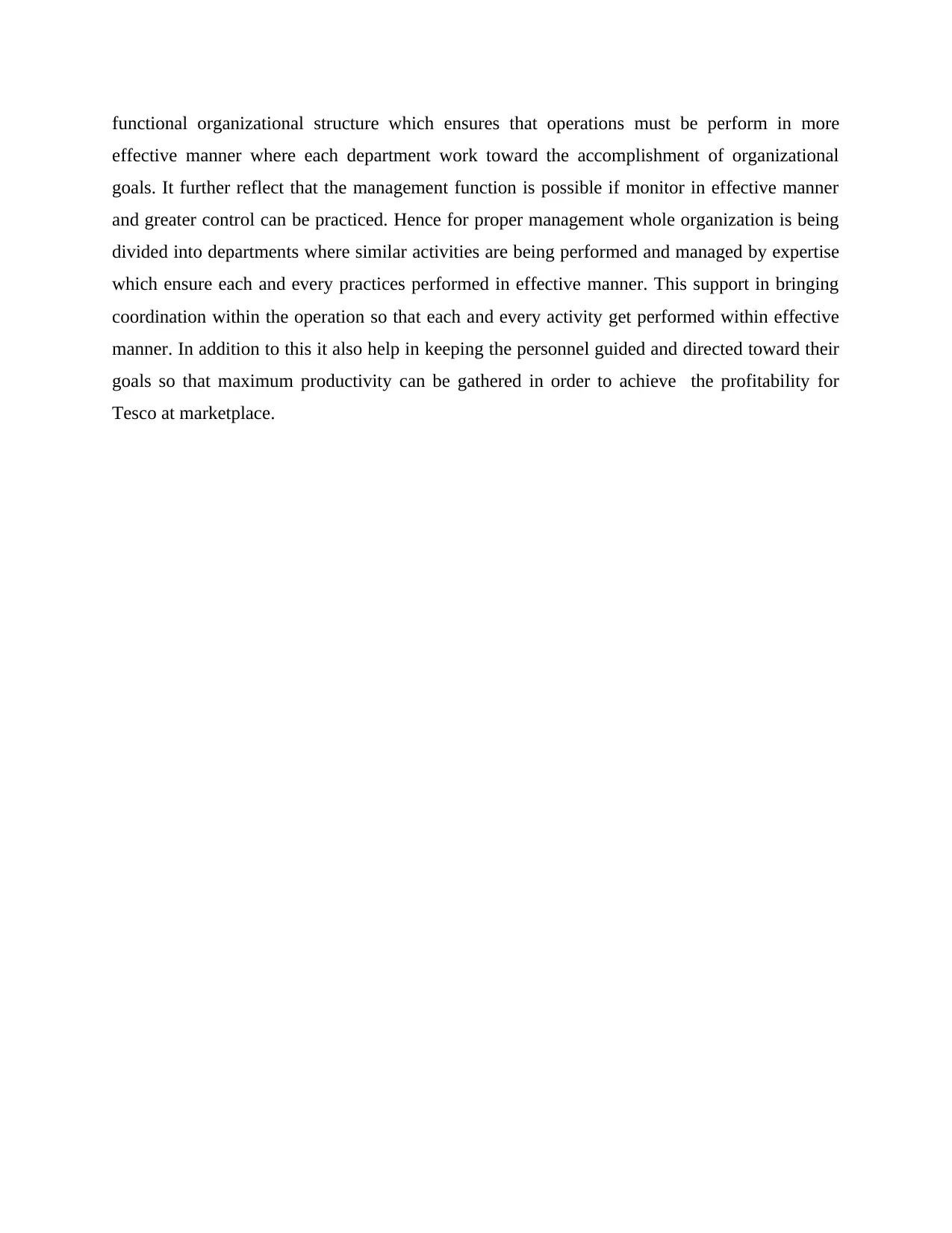
functional organizational structure which ensures that operations must be perform in more
effective manner where each department work toward the accomplishment of organizational
goals. It further reflect that the management function is possible if monitor in effective manner
and greater control can be practiced. Hence for proper management whole organization is being
divided into departments where similar activities are being performed and managed by expertise
which ensure each and every practices performed in effective manner. This support in bringing
coordination within the operation so that each and every activity get performed within effective
manner. In addition to this it also help in keeping the personnel guided and directed toward their
goals so that maximum productivity can be gathered in order to achieve the profitability for
Tesco at marketplace.
effective manner where each department work toward the accomplishment of organizational
goals. It further reflect that the management function is possible if monitor in effective manner
and greater control can be practiced. Hence for proper management whole organization is being
divided into departments where similar activities are being performed and managed by expertise
which ensure each and every practices performed in effective manner. This support in bringing
coordination within the operation so that each and every activity get performed within effective
manner. In addition to this it also help in keeping the personnel guided and directed toward their
goals so that maximum productivity can be gathered in order to achieve the profitability for
Tesco at marketplace.
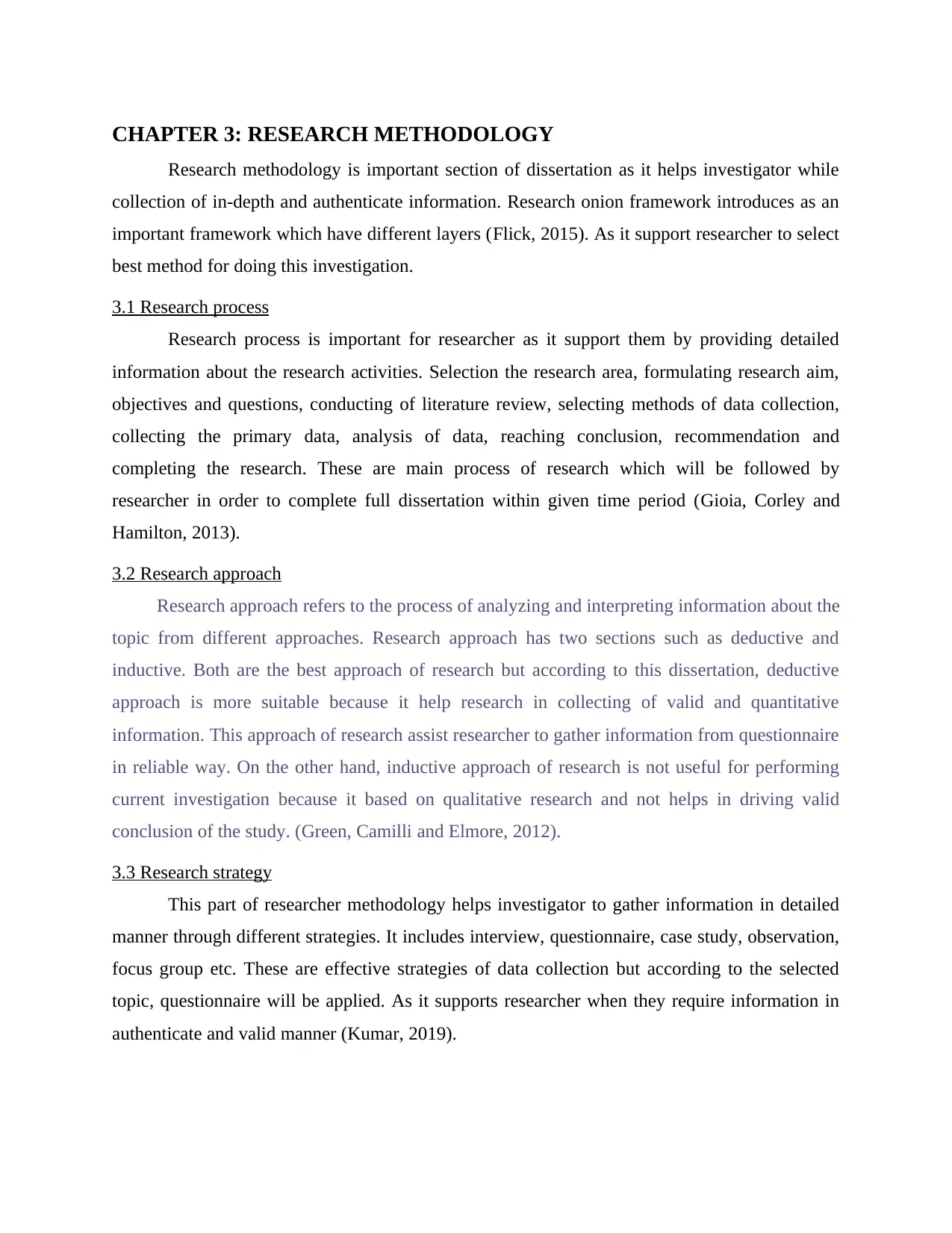
CHAPTER 3: RESEARCH METHODOLOGY
Research methodology is important section of dissertation as it helps investigator while
collection of in-depth and authenticate information. Research onion framework introduces as an
important framework which have different layers (Flick, 2015). As it support researcher to select
best method for doing this investigation.
3.1 Research process
Research process is important for researcher as it support them by providing detailed
information about the research activities. Selection the research area, formulating research aim,
objectives and questions, conducting of literature review, selecting methods of data collection,
collecting the primary data, analysis of data, reaching conclusion, recommendation and
completing the research. These are main process of research which will be followed by
researcher in order to complete full dissertation within given time period (Gioia, Corley and
Hamilton, 2013).
3.2 Research approach
Research approach refers to the process of analyzing and interpreting information about the
topic from different approaches. Research approach has two sections such as deductive and
inductive. Both are the best approach of research but according to this dissertation, deductive
approach is more suitable because it help research in collecting of valid and quantitative
information. This approach of research assist researcher to gather information from questionnaire
in reliable way. On the other hand, inductive approach of research is not useful for performing
current investigation because it based on qualitative research and not helps in driving valid
conclusion of the study. (Green, Camilli and Elmore, 2012).
3.3 Research strategy
This part of researcher methodology helps investigator to gather information in detailed
manner through different strategies. It includes interview, questionnaire, case study, observation,
focus group etc. These are effective strategies of data collection but according to the selected
topic, questionnaire will be applied. As it supports researcher when they require information in
authenticate and valid manner (Kumar, 2019).
Research methodology is important section of dissertation as it helps investigator while
collection of in-depth and authenticate information. Research onion framework introduces as an
important framework which have different layers (Flick, 2015). As it support researcher to select
best method for doing this investigation.
3.1 Research process
Research process is important for researcher as it support them by providing detailed
information about the research activities. Selection the research area, formulating research aim,
objectives and questions, conducting of literature review, selecting methods of data collection,
collecting the primary data, analysis of data, reaching conclusion, recommendation and
completing the research. These are main process of research which will be followed by
researcher in order to complete full dissertation within given time period (Gioia, Corley and
Hamilton, 2013).
3.2 Research approach
Research approach refers to the process of analyzing and interpreting information about the
topic from different approaches. Research approach has two sections such as deductive and
inductive. Both are the best approach of research but according to this dissertation, deductive
approach is more suitable because it help research in collecting of valid and quantitative
information. This approach of research assist researcher to gather information from questionnaire
in reliable way. On the other hand, inductive approach of research is not useful for performing
current investigation because it based on qualitative research and not helps in driving valid
conclusion of the study. (Green, Camilli and Elmore, 2012).
3.3 Research strategy
This part of researcher methodology helps investigator to gather information in detailed
manner through different strategies. It includes interview, questionnaire, case study, observation,
focus group etc. These are effective strategies of data collection but according to the selected
topic, questionnaire will be applied. As it supports researcher when they require information in
authenticate and valid manner (Kumar, 2019).
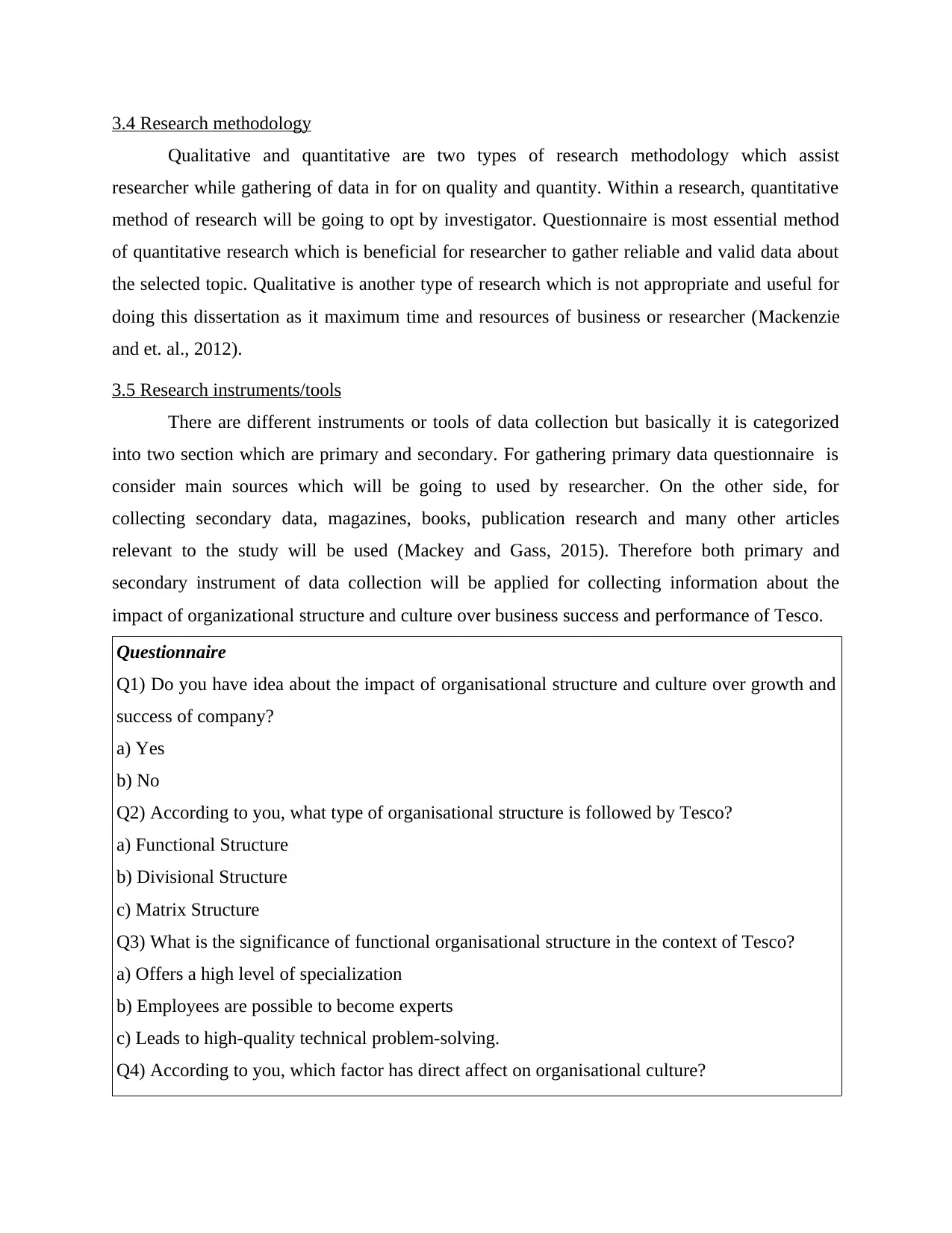
3.4 Research methodology
Qualitative and quantitative are two types of research methodology which assist
researcher while gathering of data in for on quality and quantity. Within a research, quantitative
method of research will be going to opt by investigator. Questionnaire is most essential method
of quantitative research which is beneficial for researcher to gather reliable and valid data about
the selected topic. Qualitative is another type of research which is not appropriate and useful for
doing this dissertation as it maximum time and resources of business or researcher (Mackenzie
and et. al., 2012).
3.5 Research instruments/tools
There are different instruments or tools of data collection but basically it is categorized
into two section which are primary and secondary. For gathering primary data questionnaire is
consider main sources which will be going to used by researcher. On the other side, for
collecting secondary data, magazines, books, publication research and many other articles
relevant to the study will be used (Mackey and Gass, 2015). Therefore both primary and
secondary instrument of data collection will be applied for collecting information about the
impact of organizational structure and culture over business success and performance of Tesco.
Questionnaire
Q1) Do you have idea about the impact of organisational structure and culture over growth and
success of company?
a) Yes
b) No
Q2) According to you, what type of organisational structure is followed by Tesco?
a) Functional Structure
b) Divisional Structure
c) Matrix Structure
Q3) What is the significance of functional organisational structure in the context of Tesco?
a) Offers a high level of specialization
b) Employees are possible to become experts
c) Leads to high-quality technical problem-solving.
Q4) According to you, which factor has direct affect on organisational culture?
Qualitative and quantitative are two types of research methodology which assist
researcher while gathering of data in for on quality and quantity. Within a research, quantitative
method of research will be going to opt by investigator. Questionnaire is most essential method
of quantitative research which is beneficial for researcher to gather reliable and valid data about
the selected topic. Qualitative is another type of research which is not appropriate and useful for
doing this dissertation as it maximum time and resources of business or researcher (Mackenzie
and et. al., 2012).
3.5 Research instruments/tools
There are different instruments or tools of data collection but basically it is categorized
into two section which are primary and secondary. For gathering primary data questionnaire is
consider main sources which will be going to used by researcher. On the other side, for
collecting secondary data, magazines, books, publication research and many other articles
relevant to the study will be used (Mackey and Gass, 2015). Therefore both primary and
secondary instrument of data collection will be applied for collecting information about the
impact of organizational structure and culture over business success and performance of Tesco.
Questionnaire
Q1) Do you have idea about the impact of organisational structure and culture over growth and
success of company?
a) Yes
b) No
Q2) According to you, what type of organisational structure is followed by Tesco?
a) Functional Structure
b) Divisional Structure
c) Matrix Structure
Q3) What is the significance of functional organisational structure in the context of Tesco?
a) Offers a high level of specialization
b) Employees are possible to become experts
c) Leads to high-quality technical problem-solving.
Q4) According to you, which factor has direct affect on organisational culture?
Secure Best Marks with AI Grader
Need help grading? Try our AI Grader for instant feedback on your assignments.
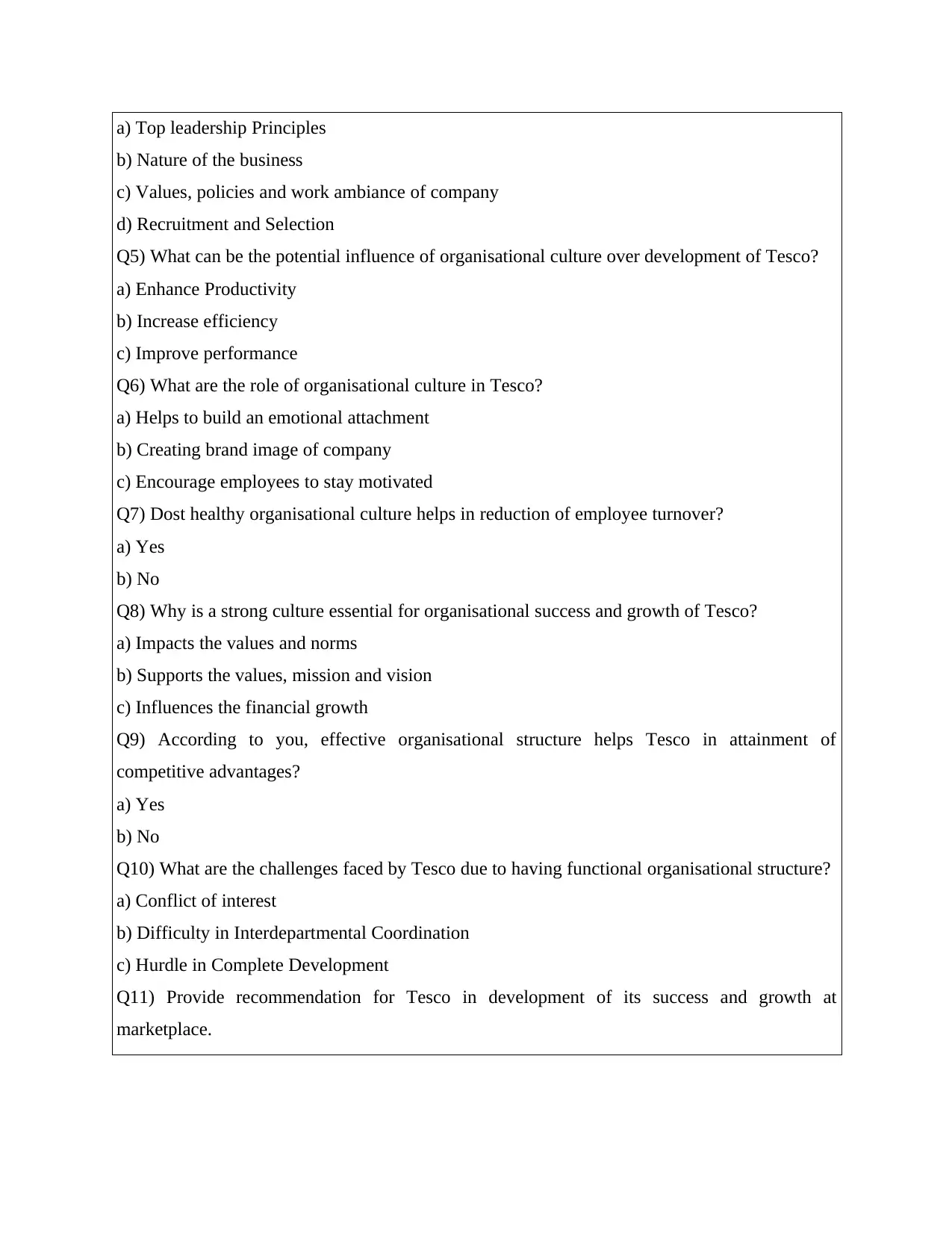
a) Top leadership Principles
b) Nature of the business
c) Values, policies and work ambiance of company
d) Recruitment and Selection
Q5) What can be the potential influence of organisational culture over development of Tesco?
a) Enhance Productivity
b) Increase efficiency
c) Improve performance
Q6) What are the role of organisational culture in Tesco?
a) Helps to build an emotional attachment
b) Creating brand image of company
c) Encourage employees to stay motivated
Q7) Dost healthy organisational culture helps in reduction of employee turnover?
a) Yes
b) No
Q8) Why is a strong culture essential for organisational success and growth of Tesco?
a) Impacts the values and norms
b) Supports the values, mission and vision
c) Influences the financial growth
Q9) According to you, effective organisational structure helps Tesco in attainment of
competitive advantages?
a) Yes
b) No
Q10) What are the challenges faced by Tesco due to having functional organisational structure?
a) Conflict of interest
b) Difficulty in Interdepartmental Coordination
c) Hurdle in Complete Development
Q11) Provide recommendation for Tesco in development of its success and growth at
marketplace.
b) Nature of the business
c) Values, policies and work ambiance of company
d) Recruitment and Selection
Q5) What can be the potential influence of organisational culture over development of Tesco?
a) Enhance Productivity
b) Increase efficiency
c) Improve performance
Q6) What are the role of organisational culture in Tesco?
a) Helps to build an emotional attachment
b) Creating brand image of company
c) Encourage employees to stay motivated
Q7) Dost healthy organisational culture helps in reduction of employee turnover?
a) Yes
b) No
Q8) Why is a strong culture essential for organisational success and growth of Tesco?
a) Impacts the values and norms
b) Supports the values, mission and vision
c) Influences the financial growth
Q9) According to you, effective organisational structure helps Tesco in attainment of
competitive advantages?
a) Yes
b) No
Q10) What are the challenges faced by Tesco due to having functional organisational structure?
a) Conflict of interest
b) Difficulty in Interdepartmental Coordination
c) Hurdle in Complete Development
Q11) Provide recommendation for Tesco in development of its success and growth at
marketplace.
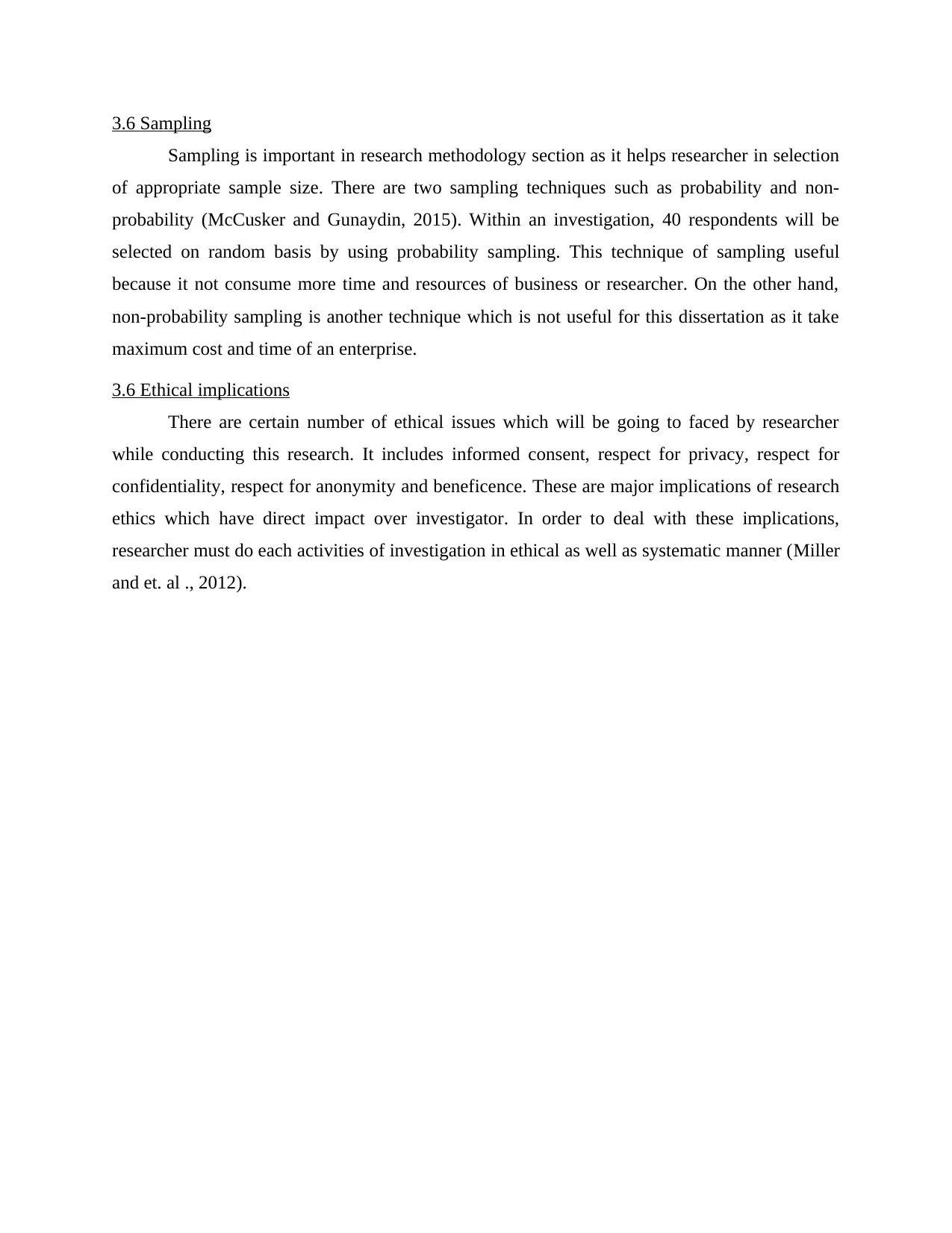
3.6 Sampling
Sampling is important in research methodology section as it helps researcher in selection
of appropriate sample size. There are two sampling techniques such as probability and non-
probability (McCusker and Gunaydin, 2015). Within an investigation, 40 respondents will be
selected on random basis by using probability sampling. This technique of sampling useful
because it not consume more time and resources of business or researcher. On the other hand,
non-probability sampling is another technique which is not useful for this dissertation as it take
maximum cost and time of an enterprise.
3.6 Ethical implications
There are certain number of ethical issues which will be going to faced by researcher
while conducting this research. It includes informed consent, respect for privacy, respect for
confidentiality, respect for anonymity and beneficence. These are major implications of research
ethics which have direct impact over investigator. In order to deal with these implications,
researcher must do each activities of investigation in ethical as well as systematic manner (Miller
and et. al ., 2012).
Sampling is important in research methodology section as it helps researcher in selection
of appropriate sample size. There are two sampling techniques such as probability and non-
probability (McCusker and Gunaydin, 2015). Within an investigation, 40 respondents will be
selected on random basis by using probability sampling. This technique of sampling useful
because it not consume more time and resources of business or researcher. On the other hand,
non-probability sampling is another technique which is not useful for this dissertation as it take
maximum cost and time of an enterprise.
3.6 Ethical implications
There are certain number of ethical issues which will be going to faced by researcher
while conducting this research. It includes informed consent, respect for privacy, respect for
confidentiality, respect for anonymity and beneficence. These are major implications of research
ethics which have direct impact over investigator. In order to deal with these implications,
researcher must do each activities of investigation in ethical as well as systematic manner (Miller
and et. al ., 2012).
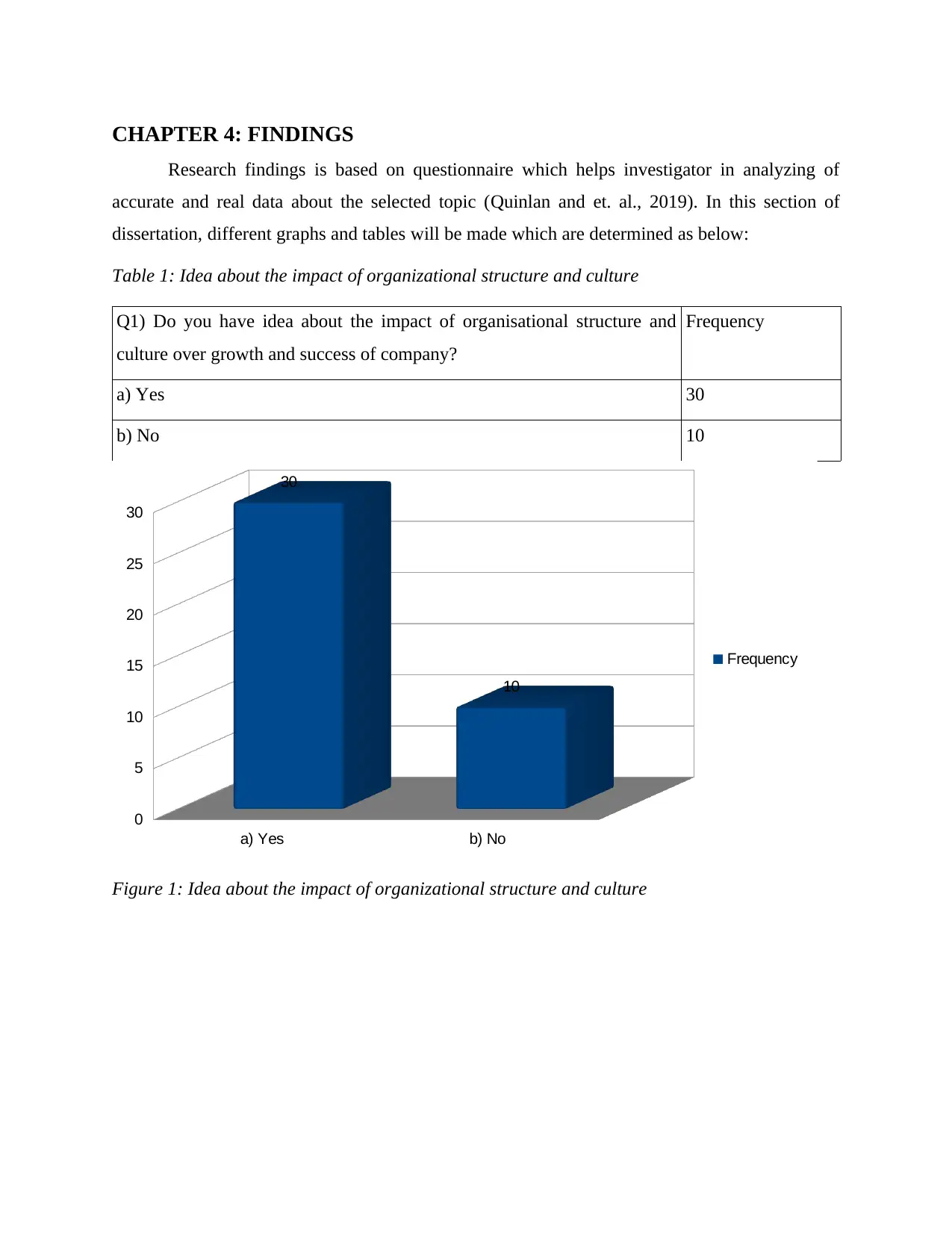
CHAPTER 4: FINDINGS
Research findings is based on questionnaire which helps investigator in analyzing of
accurate and real data about the selected topic (Quinlan and et. al., 2019). In this section of
dissertation, different graphs and tables will be made which are determined as below:
Table 1: Idea about the impact of organizational structure and culture
Q1) Do you have idea about the impact of organisational structure and
culture over growth and success of company?
Frequency
a) Yes 30
b) No 10
a) Yes b) No
0
5
10
15
20
25
30
30
10
Frequency
Figure 1: Idea about the impact of organizational structure and culture
Research findings is based on questionnaire which helps investigator in analyzing of
accurate and real data about the selected topic (Quinlan and et. al., 2019). In this section of
dissertation, different graphs and tables will be made which are determined as below:
Table 1: Idea about the impact of organizational structure and culture
Q1) Do you have idea about the impact of organisational structure and
culture over growth and success of company?
Frequency
a) Yes 30
b) No 10
a) Yes b) No
0
5
10
15
20
25
30
30
10
Frequency
Figure 1: Idea about the impact of organizational structure and culture
Paraphrase This Document
Need a fresh take? Get an instant paraphrase of this document with our AI Paraphraser
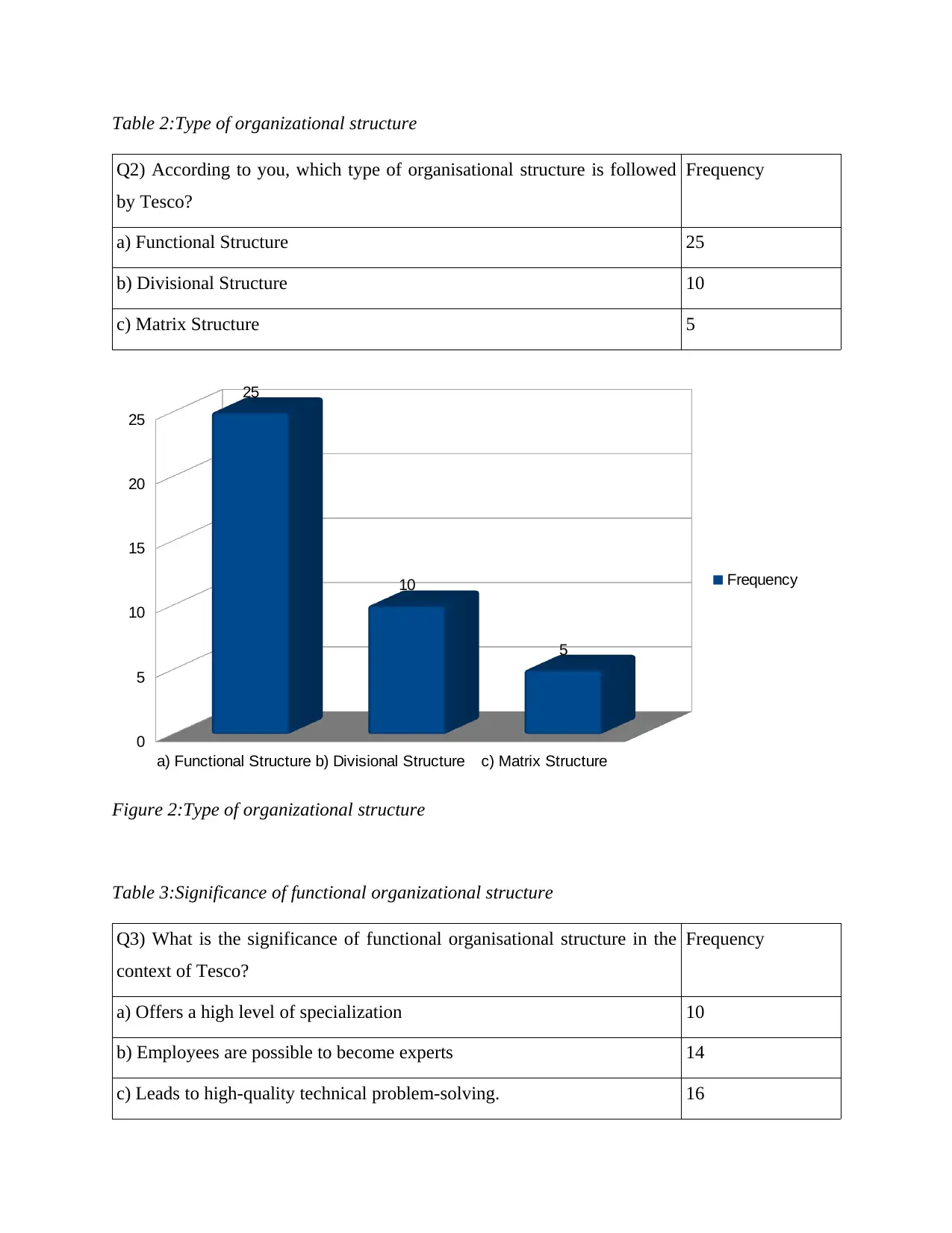
Table 2:Type of organizational structure
Q2) According to you, which type of organisational structure is followed
by Tesco?
Frequency
a) Functional Structure 25
b) Divisional Structure 10
c) Matrix Structure 5
a) Functional Structure b) Divisional Structure c) Matrix Structure
0
5
10
15
20
25
25
10
5
Frequency
Figure 2:Type of organizational structure
Table 3:Significance of functional organizational structure
Q3) What is the significance of functional organisational structure in the
context of Tesco?
Frequency
a) Offers a high level of specialization 10
b) Employees are possible to become experts 14
c) Leads to high-quality technical problem-solving. 16
Q2) According to you, which type of organisational structure is followed
by Tesco?
Frequency
a) Functional Structure 25
b) Divisional Structure 10
c) Matrix Structure 5
a) Functional Structure b) Divisional Structure c) Matrix Structure
0
5
10
15
20
25
25
10
5
Frequency
Figure 2:Type of organizational structure
Table 3:Significance of functional organizational structure
Q3) What is the significance of functional organisational structure in the
context of Tesco?
Frequency
a) Offers a high level of specialization 10
b) Employees are possible to become experts 14
c) Leads to high-quality technical problem-solving. 16
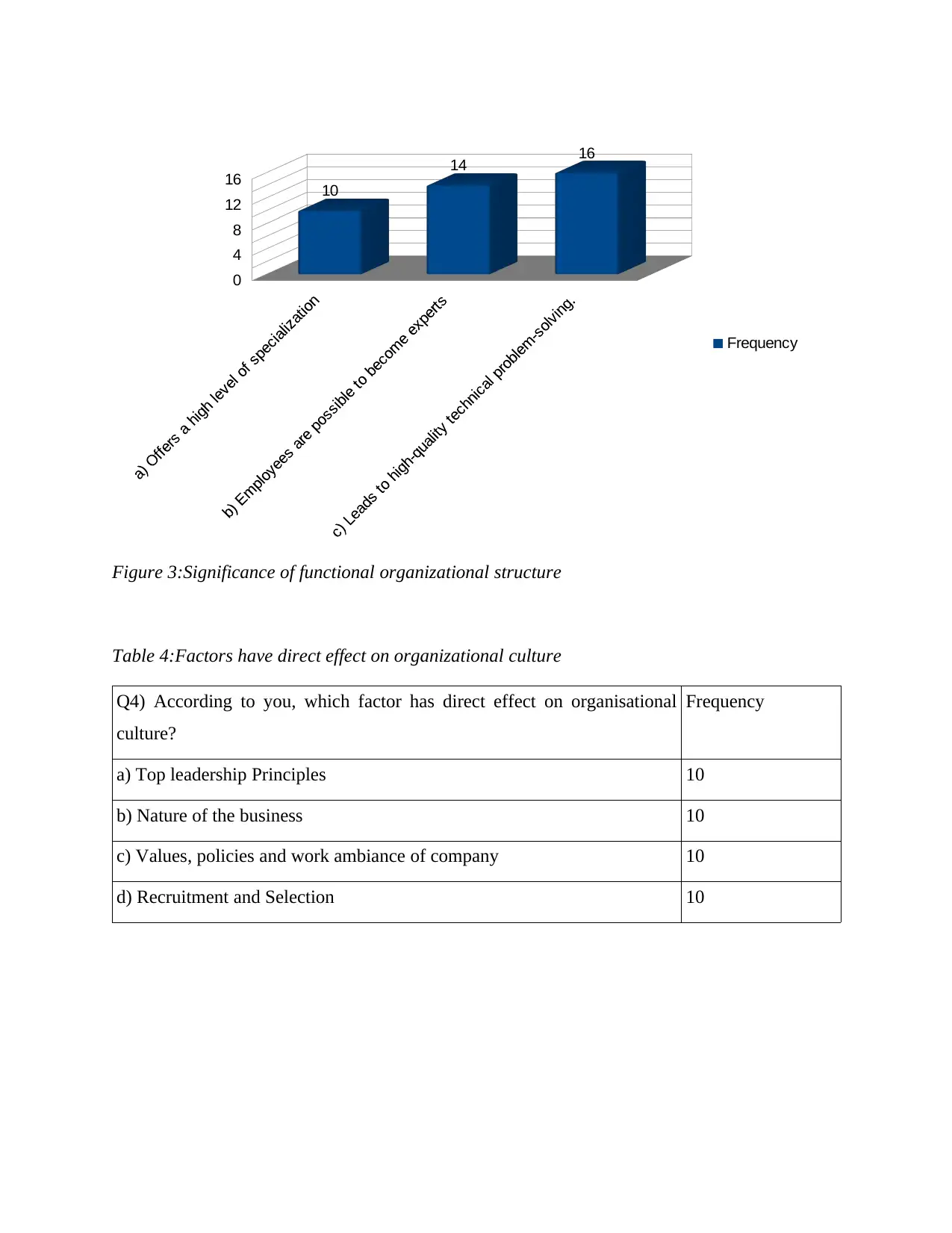
0
4
8
12
16 10
14 16
Frequency
Figure 3:Significance of functional organizational structure
Table 4:Factors have direct effect on organizational culture
Q4) According to you, which factor has direct effect on organisational
culture?
Frequency
a) Top leadership Principles 10
b) Nature of the business 10
c) Values, policies and work ambiance of company 10
d) Recruitment and Selection 10
4
8
12
16 10
14 16
Frequency
Figure 3:Significance of functional organizational structure
Table 4:Factors have direct effect on organizational culture
Q4) According to you, which factor has direct effect on organisational
culture?
Frequency
a) Top leadership Principles 10
b) Nature of the business 10
c) Values, policies and work ambiance of company 10
d) Recruitment and Selection 10
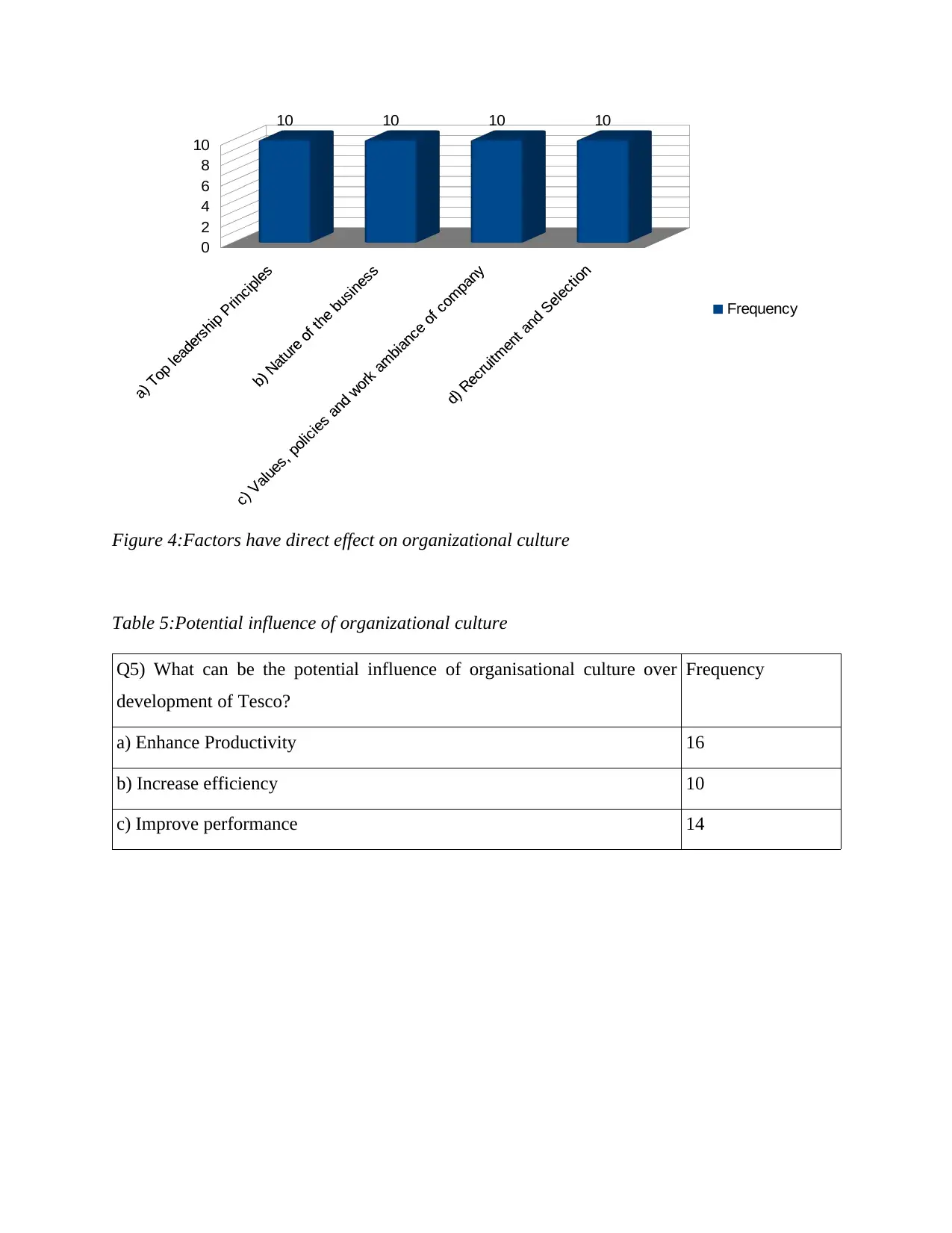
0
2
4
6
8
10
10 10 10 10
Frequency
Figure 4:Factors have direct effect on organizational culture
Table 5:Potential influence of organizational culture
Q5) What can be the potential influence of organisational culture over
development of Tesco?
Frequency
a) Enhance Productivity 16
b) Increase efficiency 10
c) Improve performance 14
2
4
6
8
10
10 10 10 10
Frequency
Figure 4:Factors have direct effect on organizational culture
Table 5:Potential influence of organizational culture
Q5) What can be the potential influence of organisational culture over
development of Tesco?
Frequency
a) Enhance Productivity 16
b) Increase efficiency 10
c) Improve performance 14
Secure Best Marks with AI Grader
Need help grading? Try our AI Grader for instant feedback on your assignments.

a) Enhance Productivity
b) Increase efficiency
c) Improve performance
0
2
4
6
8
10
12
14
16
16
10
14
Frequency
Figure 5:Potential influence of organizational culture
Table 6:Role of organizational culture
Q6) What are the role of organisational culture in Tesco? Frequency
a) Helps to build an emotional attachment 14
b) Creating brand image of company 16
c) Encourage employees to stay motivated 10
b) Increase efficiency
c) Improve performance
0
2
4
6
8
10
12
14
16
16
10
14
Frequency
Figure 5:Potential influence of organizational culture
Table 6:Role of organizational culture
Q6) What are the role of organisational culture in Tesco? Frequency
a) Helps to build an emotional attachment 14
b) Creating brand image of company 16
c) Encourage employees to stay motivated 10

0
4
8
12
16 14
16
10
Frequency
Figure 6:Role of organizational culture
Table 7:Healthy organizational culture helps in reduction of employee turnover
Q7) Dost healthy organisational culture helps in reduction of employee
turnover?
Frequency
a) Yes 30
b) No 10
4
8
12
16 14
16
10
Frequency
Figure 6:Role of organizational culture
Table 7:Healthy organizational culture helps in reduction of employee turnover
Q7) Dost healthy organisational culture helps in reduction of employee
turnover?
Frequency
a) Yes 30
b) No 10
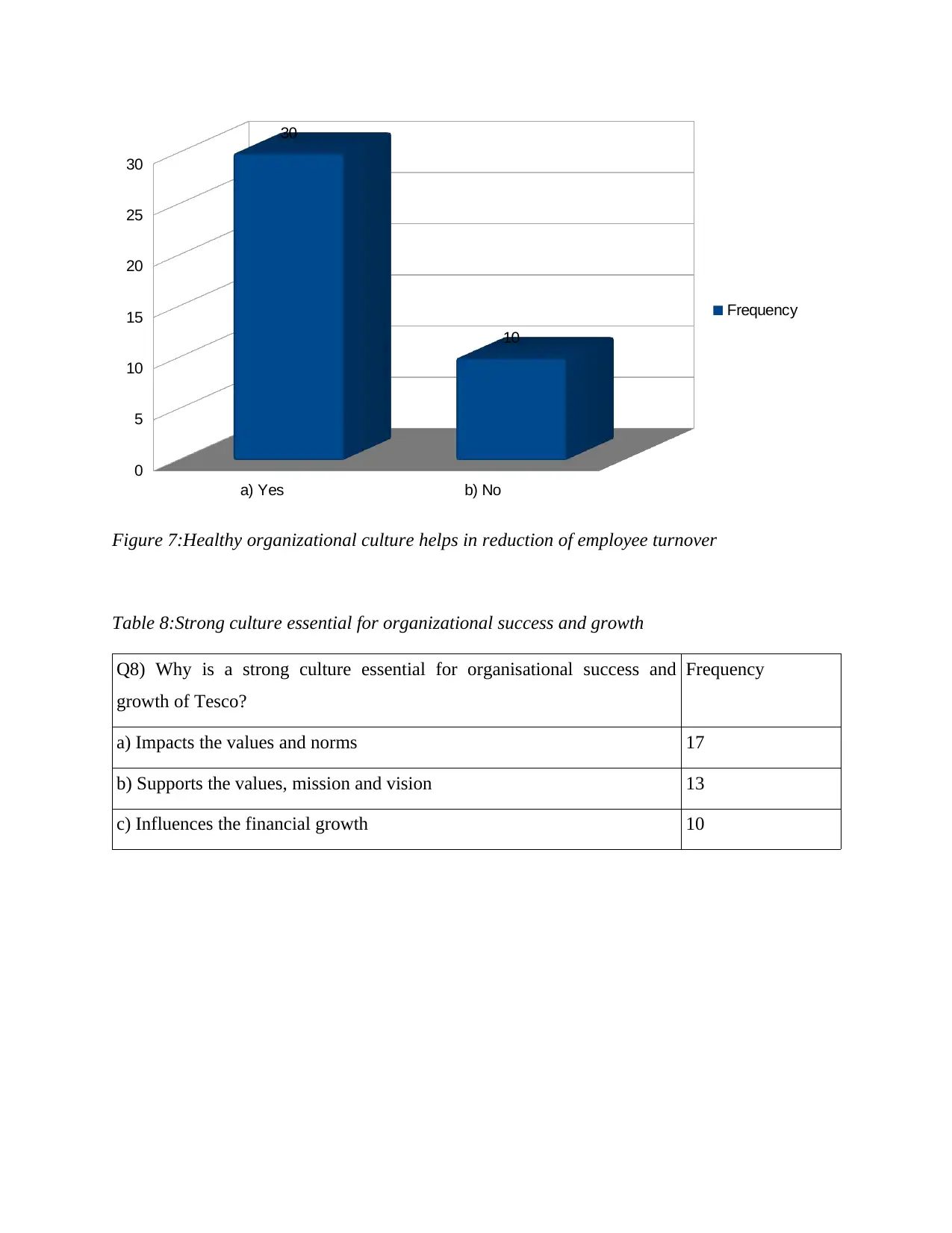
a) Yes b) No
0
5
10
15
20
25
30
30
10
Frequency
Figure 7:Healthy organizational culture helps in reduction of employee turnover
Table 8:Strong culture essential for organizational success and growth
Q8) Why is a strong culture essential for organisational success and
growth of Tesco?
Frequency
a) Impacts the values and norms 17
b) Supports the values, mission and vision 13
c) Influences the financial growth 10
0
5
10
15
20
25
30
30
10
Frequency
Figure 7:Healthy organizational culture helps in reduction of employee turnover
Table 8:Strong culture essential for organizational success and growth
Q8) Why is a strong culture essential for organisational success and
growth of Tesco?
Frequency
a) Impacts the values and norms 17
b) Supports the values, mission and vision 13
c) Influences the financial growth 10
Paraphrase This Document
Need a fresh take? Get an instant paraphrase of this document with our AI Paraphraser
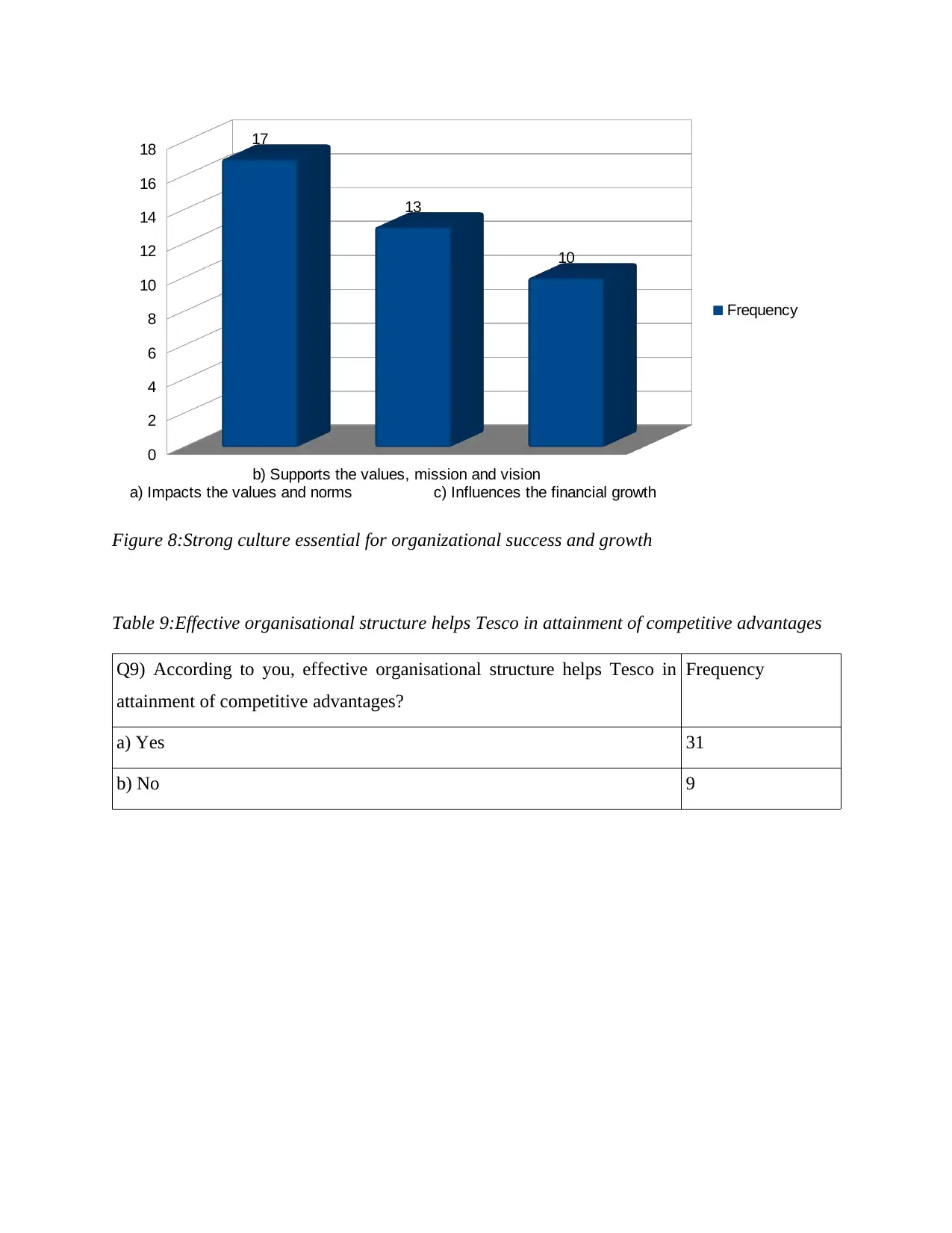
a) Impacts the values and norms
b) Supports the values, mission and vision
c) Influences the financial growth
0
2
4
6
8
10
12
14
16
18 17
13
10
Frequency
Figure 8:Strong culture essential for organizational success and growth
Table 9:Effective organisational structure helps Tesco in attainment of competitive advantages
Q9) According to you, effective organisational structure helps Tesco in
attainment of competitive advantages?
Frequency
a) Yes 31
b) No 9
b) Supports the values, mission and vision
c) Influences the financial growth
0
2
4
6
8
10
12
14
16
18 17
13
10
Frequency
Figure 8:Strong culture essential for organizational success and growth
Table 9:Effective organisational structure helps Tesco in attainment of competitive advantages
Q9) According to you, effective organisational structure helps Tesco in
attainment of competitive advantages?
Frequency
a) Yes 31
b) No 9
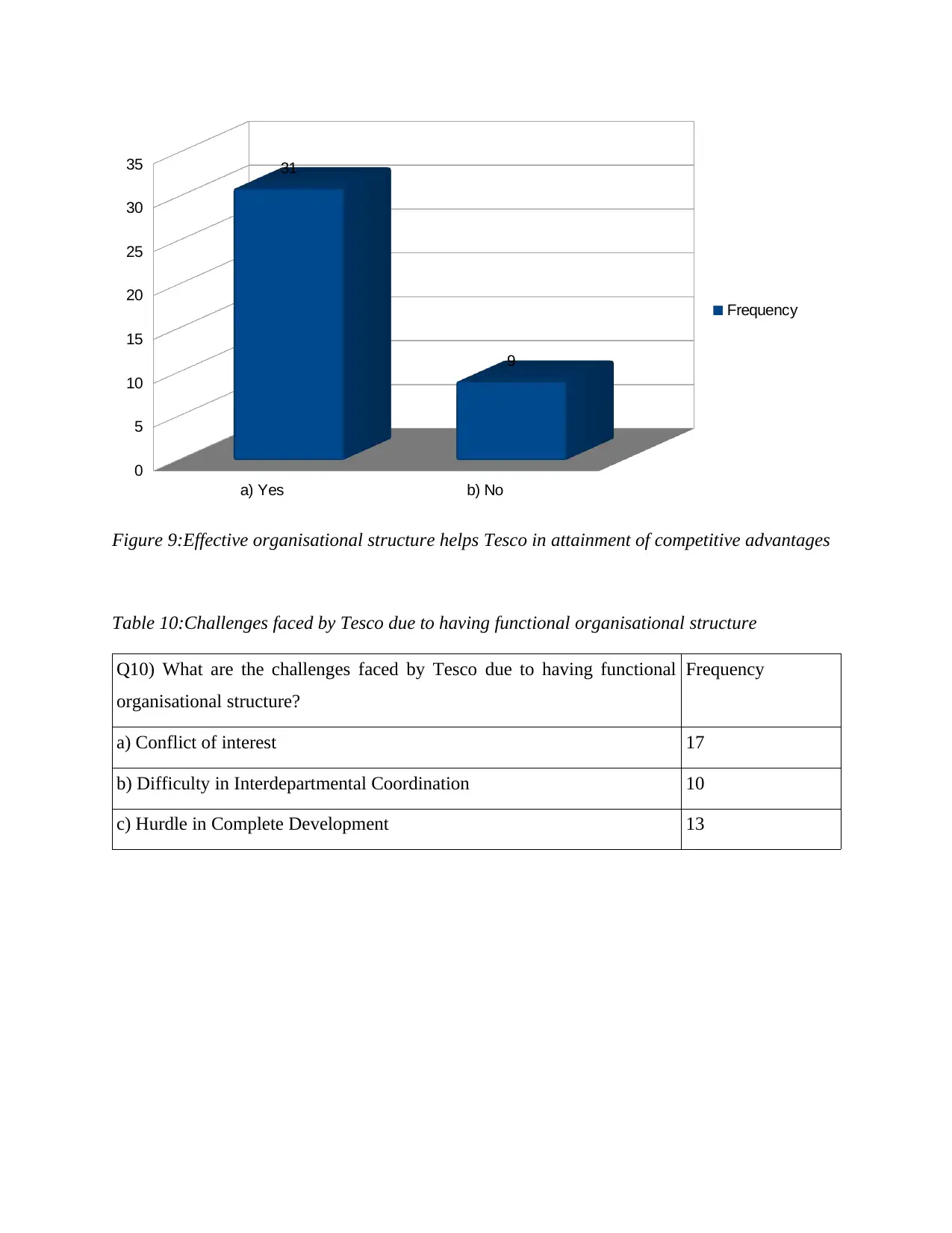
a) Yes b) No
0
5
10
15
20
25
30
35 31
9
Frequency
Figure 9:Effective organisational structure helps Tesco in attainment of competitive advantages
Table 10:Challenges faced by Tesco due to having functional organisational structure
Q10) What are the challenges faced by Tesco due to having functional
organisational structure?
Frequency
a) Conflict of interest 17
b) Difficulty in Interdepartmental Coordination 10
c) Hurdle in Complete Development 13
0
5
10
15
20
25
30
35 31
9
Frequency
Figure 9:Effective organisational structure helps Tesco in attainment of competitive advantages
Table 10:Challenges faced by Tesco due to having functional organisational structure
Q10) What are the challenges faced by Tesco due to having functional
organisational structure?
Frequency
a) Conflict of interest 17
b) Difficulty in Interdepartmental Coordination 10
c) Hurdle in Complete Development 13
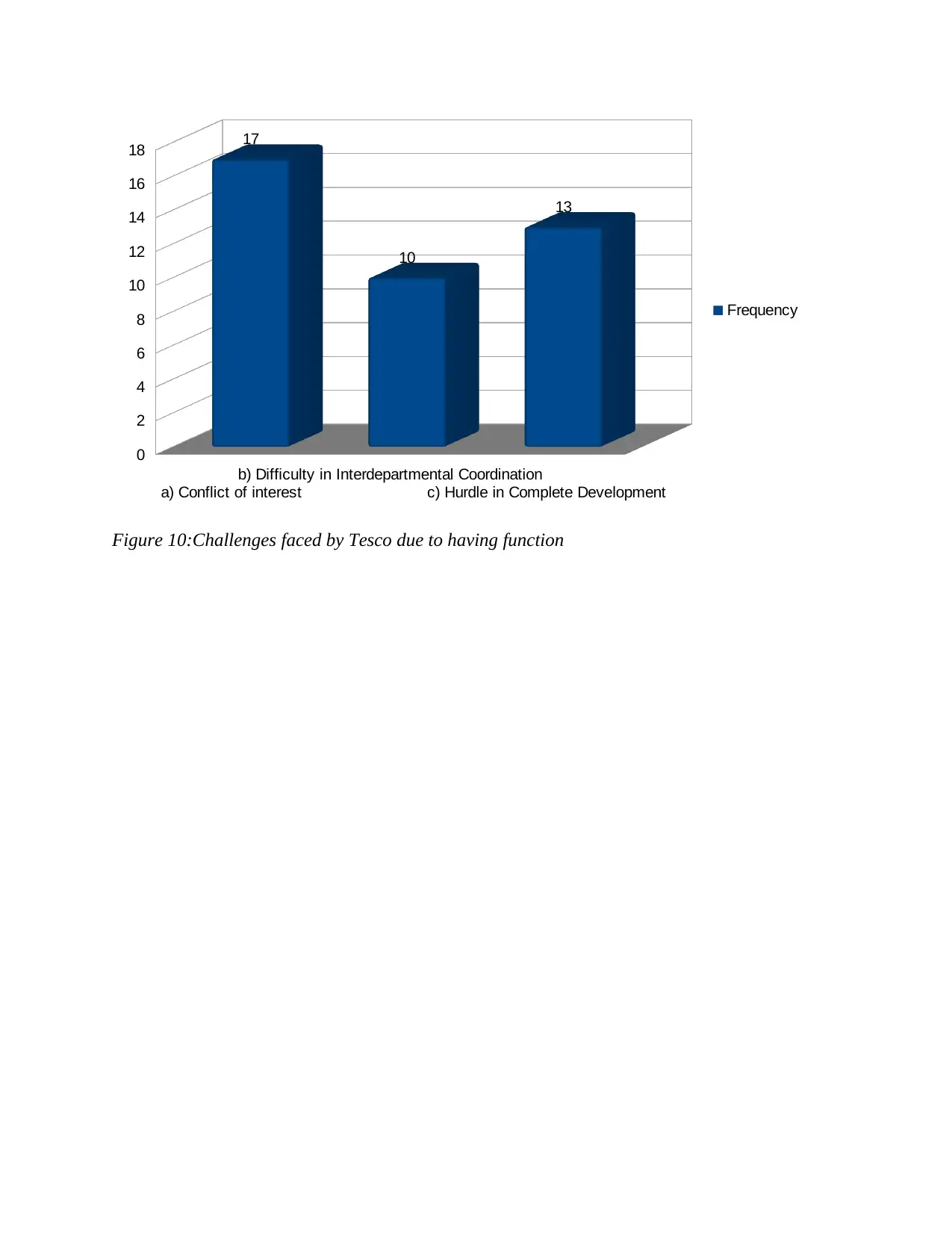
a) Conflict of interest
b) Difficulty in Interdepartmental Coordination
c) Hurdle in Complete Development
0
2
4
6
8
10
12
14
16
18 17
10
13
Frequency
Figure 10:Challenges faced by Tesco due to having function
b) Difficulty in Interdepartmental Coordination
c) Hurdle in Complete Development
0
2
4
6
8
10
12
14
16
18 17
10
13
Frequency
Figure 10:Challenges faced by Tesco due to having function
Secure Best Marks with AI Grader
Need help grading? Try our AI Grader for instant feedback on your assignments.
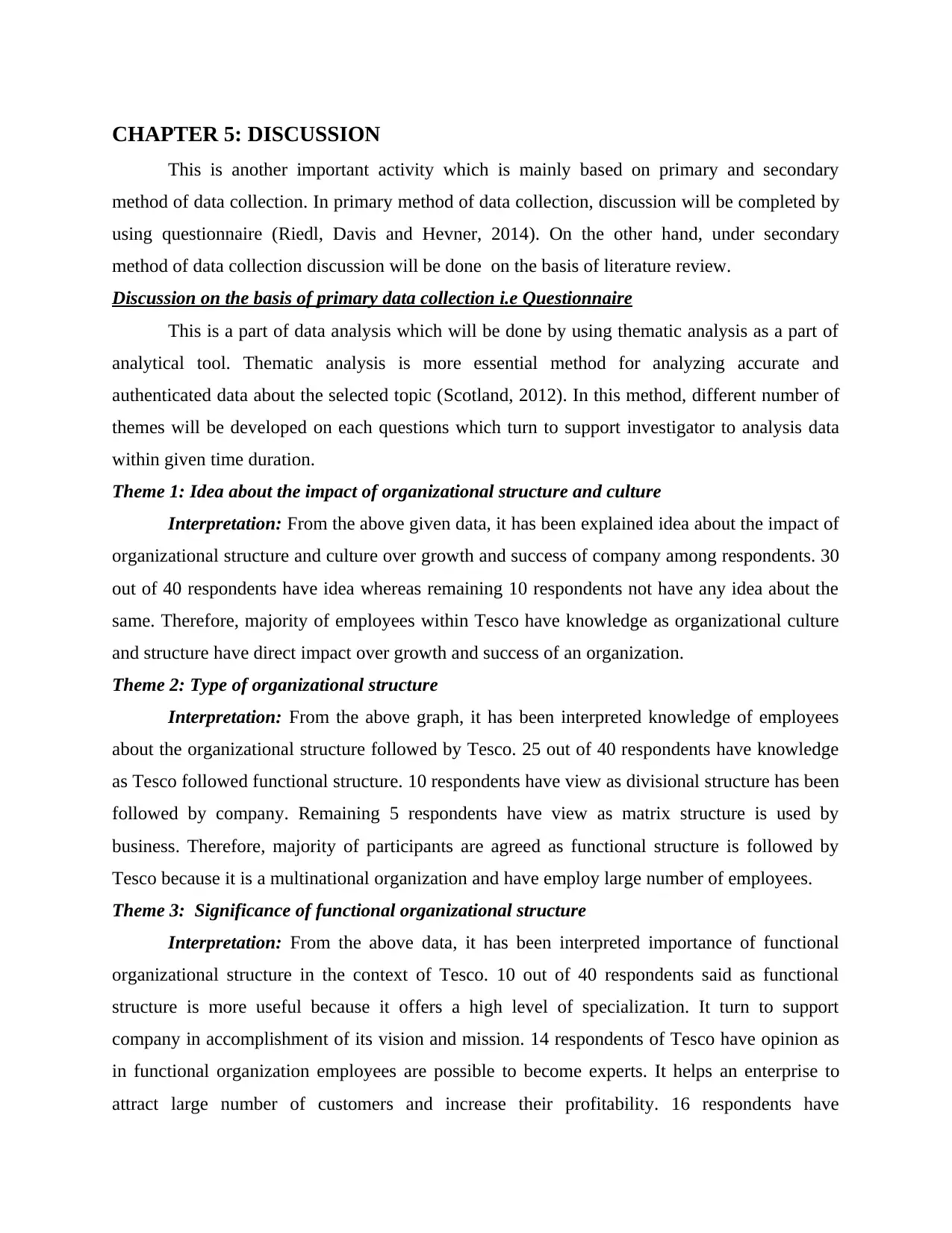
CHAPTER 5: DISCUSSION
This is another important activity which is mainly based on primary and secondary
method of data collection. In primary method of data collection, discussion will be completed by
using questionnaire (Riedl, Davis and Hevner, 2014). On the other hand, under secondary
method of data collection discussion will be done on the basis of literature review.
Discussion on the basis of primary data collection i.e Questionnaire
This is a part of data analysis which will be done by using thematic analysis as a part of
analytical tool. Thematic analysis is more essential method for analyzing accurate and
authenticated data about the selected topic (Scotland, 2012). In this method, different number of
themes will be developed on each questions which turn to support investigator to analysis data
within given time duration.
Theme 1: Idea about the impact of organizational structure and culture
Interpretation: From the above given data, it has been explained idea about the impact of
organizational structure and culture over growth and success of company among respondents. 30
out of 40 respondents have idea whereas remaining 10 respondents not have any idea about the
same. Therefore, majority of employees within Tesco have knowledge as organizational culture
and structure have direct impact over growth and success of an organization.
Theme 2: Type of organizational structure
Interpretation: From the above graph, it has been interpreted knowledge of employees
about the organizational structure followed by Tesco. 25 out of 40 respondents have knowledge
as Tesco followed functional structure. 10 respondents have view as divisional structure has been
followed by company. Remaining 5 respondents have view as matrix structure is used by
business. Therefore, majority of participants are agreed as functional structure is followed by
Tesco because it is a multinational organization and have employ large number of employees.
Theme 3: Significance of functional organizational structure
Interpretation: From the above data, it has been interpreted importance of functional
organizational structure in the context of Tesco. 10 out of 40 respondents said as functional
structure is more useful because it offers a high level of specialization. It turn to support
company in accomplishment of its vision and mission. 14 respondents of Tesco have opinion as
in functional organization employees are possible to become experts. It helps an enterprise to
attract large number of customers and increase their profitability. 16 respondents have
This is another important activity which is mainly based on primary and secondary
method of data collection. In primary method of data collection, discussion will be completed by
using questionnaire (Riedl, Davis and Hevner, 2014). On the other hand, under secondary
method of data collection discussion will be done on the basis of literature review.
Discussion on the basis of primary data collection i.e Questionnaire
This is a part of data analysis which will be done by using thematic analysis as a part of
analytical tool. Thematic analysis is more essential method for analyzing accurate and
authenticated data about the selected topic (Scotland, 2012). In this method, different number of
themes will be developed on each questions which turn to support investigator to analysis data
within given time duration.
Theme 1: Idea about the impact of organizational structure and culture
Interpretation: From the above given data, it has been explained idea about the impact of
organizational structure and culture over growth and success of company among respondents. 30
out of 40 respondents have idea whereas remaining 10 respondents not have any idea about the
same. Therefore, majority of employees within Tesco have knowledge as organizational culture
and structure have direct impact over growth and success of an organization.
Theme 2: Type of organizational structure
Interpretation: From the above graph, it has been interpreted knowledge of employees
about the organizational structure followed by Tesco. 25 out of 40 respondents have knowledge
as Tesco followed functional structure. 10 respondents have view as divisional structure has been
followed by company. Remaining 5 respondents have view as matrix structure is used by
business. Therefore, majority of participants are agreed as functional structure is followed by
Tesco because it is a multinational organization and have employ large number of employees.
Theme 3: Significance of functional organizational structure
Interpretation: From the above data, it has been interpreted importance of functional
organizational structure in the context of Tesco. 10 out of 40 respondents said as functional
structure is more useful because it offers a high level of specialization. It turn to support
company in accomplishment of its vision and mission. 14 respondents of Tesco have opinion as
in functional organization employees are possible to become experts. It helps an enterprise to
attract large number of customers and increase their profitability. 16 respondents have
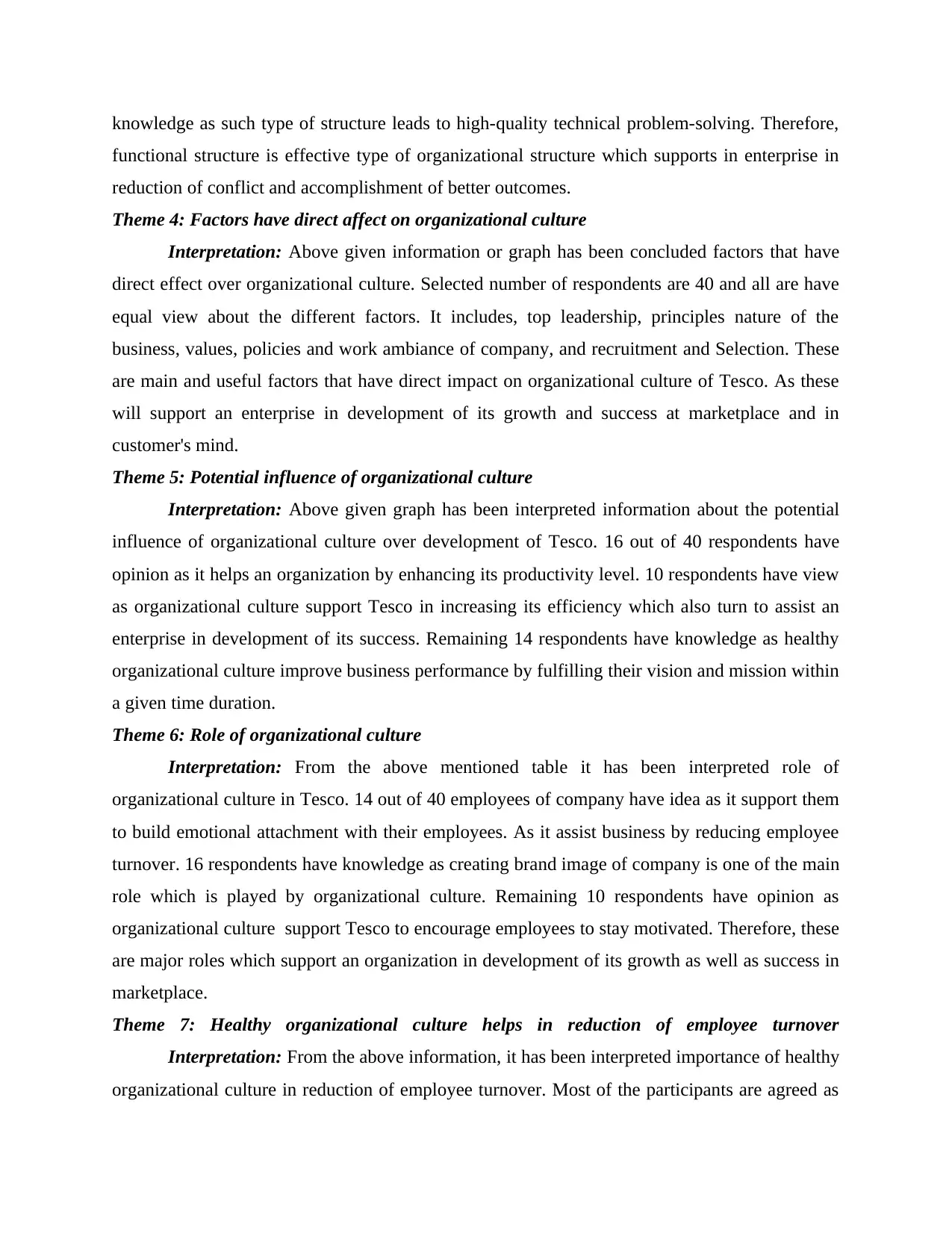
knowledge as such type of structure leads to high-quality technical problem-solving. Therefore,
functional structure is effective type of organizational structure which supports in enterprise in
reduction of conflict and accomplishment of better outcomes.
Theme 4: Factors have direct affect on organizational culture
Interpretation: Above given information or graph has been concluded factors that have
direct effect over organizational culture. Selected number of respondents are 40 and all are have
equal view about the different factors. It includes, top leadership, principles nature of the
business, values, policies and work ambiance of company, and recruitment and Selection. These
are main and useful factors that have direct impact on organizational culture of Tesco. As these
will support an enterprise in development of its growth and success at marketplace and in
customer's mind.
Theme 5: Potential influence of organizational culture
Interpretation: Above given graph has been interpreted information about the potential
influence of organizational culture over development of Tesco. 16 out of 40 respondents have
opinion as it helps an organization by enhancing its productivity level. 10 respondents have view
as organizational culture support Tesco in increasing its efficiency which also turn to assist an
enterprise in development of its success. Remaining 14 respondents have knowledge as healthy
organizational culture improve business performance by fulfilling their vision and mission within
a given time duration.
Theme 6: Role of organizational culture
Interpretation: From the above mentioned table it has been interpreted role of
organizational culture in Tesco. 14 out of 40 employees of company have idea as it support them
to build emotional attachment with their employees. As it assist business by reducing employee
turnover. 16 respondents have knowledge as creating brand image of company is one of the main
role which is played by organizational culture. Remaining 10 respondents have opinion as
organizational culture support Tesco to encourage employees to stay motivated. Therefore, these
are major roles which support an organization in development of its growth as well as success in
marketplace.
Theme 7: Healthy organizational culture helps in reduction of employee turnover
Interpretation: From the above information, it has been interpreted importance of healthy
organizational culture in reduction of employee turnover. Most of the participants are agreed as
functional structure is effective type of organizational structure which supports in enterprise in
reduction of conflict and accomplishment of better outcomes.
Theme 4: Factors have direct affect on organizational culture
Interpretation: Above given information or graph has been concluded factors that have
direct effect over organizational culture. Selected number of respondents are 40 and all are have
equal view about the different factors. It includes, top leadership, principles nature of the
business, values, policies and work ambiance of company, and recruitment and Selection. These
are main and useful factors that have direct impact on organizational culture of Tesco. As these
will support an enterprise in development of its growth and success at marketplace and in
customer's mind.
Theme 5: Potential influence of organizational culture
Interpretation: Above given graph has been interpreted information about the potential
influence of organizational culture over development of Tesco. 16 out of 40 respondents have
opinion as it helps an organization by enhancing its productivity level. 10 respondents have view
as organizational culture support Tesco in increasing its efficiency which also turn to assist an
enterprise in development of its success. Remaining 14 respondents have knowledge as healthy
organizational culture improve business performance by fulfilling their vision and mission within
a given time duration.
Theme 6: Role of organizational culture
Interpretation: From the above mentioned table it has been interpreted role of
organizational culture in Tesco. 14 out of 40 employees of company have idea as it support them
to build emotional attachment with their employees. As it assist business by reducing employee
turnover. 16 respondents have knowledge as creating brand image of company is one of the main
role which is played by organizational culture. Remaining 10 respondents have opinion as
organizational culture support Tesco to encourage employees to stay motivated. Therefore, these
are major roles which support an organization in development of its growth as well as success in
marketplace.
Theme 7: Healthy organizational culture helps in reduction of employee turnover
Interpretation: From the above information, it has been interpreted importance of healthy
organizational culture in reduction of employee turnover. Most of the participants are agreed as

healthy organizational culture is important for an organization by reducing impact of high
employee turnover and also support them in development of its growth and success. Remaining
10 respondents not have any idea about the same.
Theme 8: Strong culture essential for organizational success and growth
Interpretation: From the above given data, it has been concluded importance and
requirement of strong culture for Tesco. 17 out of 40 respondents have opinion as strong culture
is essential for business because it impacts the values and norms. 13 respondents have
knowledge as strong culture is most important and necessary for an organisation because it
supports to accomplish their values, mission and vision within given time duration. Remaining
10 respondents have knowledge as strong organisational culture supports Tesco in increasings its
financial growth and success. Therefore, strong organisational culture is more beneficial for
success and growth of an enterprise.
Theme 9: Effective organisational structure helps Tesco in attainment of competitive
advantages
Interpretation: The organisational structure within an organisation plays a crucial role in
improving the operational efficiency of an organisation by directing the role of particular action
within operation. By performing investigation over this it has been identified that 31 out of 40
area agreed with the fact that effective organisational structure help TESCO in achieving
competitive advantage. But on the other hand 9 respondents are not agree as per their view
competitive advantage is to achieve by the operational efficiency and strategies. From this it has
been found that majority of people are in favour as the organisational structure ensure right flow
of authority and operations which brings up higher quality of operations which yield positive
outcome and thus help in achieving competitive edge.
Theme 10: Challenges faced by Tesco due to having functional organizational structure
Interpretation: As per above mentioned information it has been identified that there are
number of challenges which TESCO has faced while implementing the functional structure in
organization. From this it has been identified that 17 out of 14 respondents said that conflict of
interest is major issue, but 10 respondents said that difficulty in interdepartmental coordination is
an issue but remaining 13 respondent said that hurdle in complete development is major issue
that TESCO may face. From this it has been identified that majority of people agree with conflict
employee turnover and also support them in development of its growth and success. Remaining
10 respondents not have any idea about the same.
Theme 8: Strong culture essential for organizational success and growth
Interpretation: From the above given data, it has been concluded importance and
requirement of strong culture for Tesco. 17 out of 40 respondents have opinion as strong culture
is essential for business because it impacts the values and norms. 13 respondents have
knowledge as strong culture is most important and necessary for an organisation because it
supports to accomplish their values, mission and vision within given time duration. Remaining
10 respondents have knowledge as strong organisational culture supports Tesco in increasings its
financial growth and success. Therefore, strong organisational culture is more beneficial for
success and growth of an enterprise.
Theme 9: Effective organisational structure helps Tesco in attainment of competitive
advantages
Interpretation: The organisational structure within an organisation plays a crucial role in
improving the operational efficiency of an organisation by directing the role of particular action
within operation. By performing investigation over this it has been identified that 31 out of 40
area agreed with the fact that effective organisational structure help TESCO in achieving
competitive advantage. But on the other hand 9 respondents are not agree as per their view
competitive advantage is to achieve by the operational efficiency and strategies. From this it has
been found that majority of people are in favour as the organisational structure ensure right flow
of authority and operations which brings up higher quality of operations which yield positive
outcome and thus help in achieving competitive edge.
Theme 10: Challenges faced by Tesco due to having functional organizational structure
Interpretation: As per above mentioned information it has been identified that there are
number of challenges which TESCO has faced while implementing the functional structure in
organization. From this it has been identified that 17 out of 14 respondents said that conflict of
interest is major issue, but 10 respondents said that difficulty in interdepartmental coordination is
an issue but remaining 13 respondent said that hurdle in complete development is major issue
that TESCO may face. From this it has been identified that majority of people agree with conflict
Paraphrase This Document
Need a fresh take? Get an instant paraphrase of this document with our AI Paraphraser
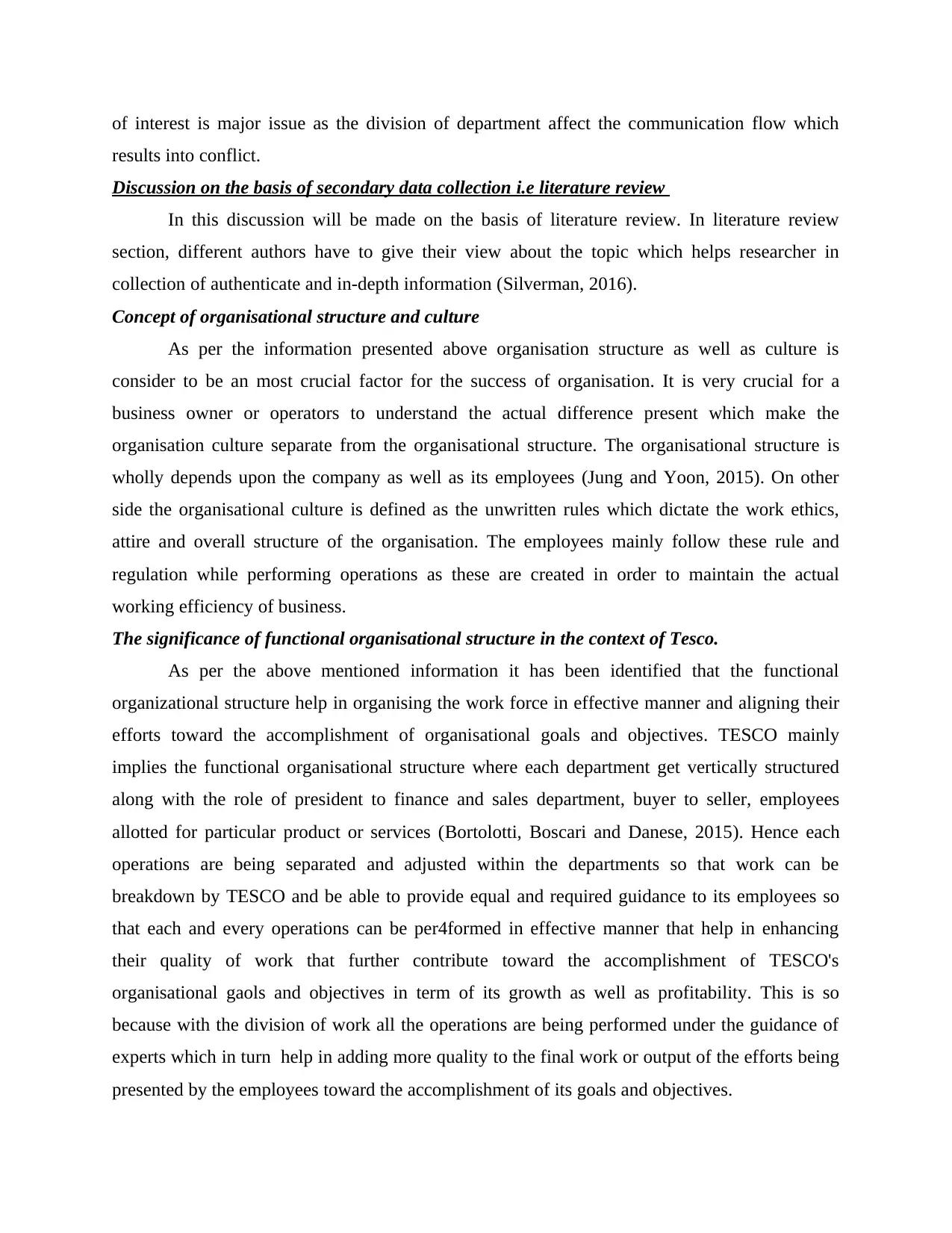
of interest is major issue as the division of department affect the communication flow which
results into conflict.
Discussion on the basis of secondary data collection i.e literature review
In this discussion will be made on the basis of literature review. In literature review
section, different authors have to give their view about the topic which helps researcher in
collection of authenticate and in-depth information (Silverman, 2016).
Concept of organisational structure and culture
As per the information presented above organisation structure as well as culture is
consider to be an most crucial factor for the success of organisation. It is very crucial for a
business owner or operators to understand the actual difference present which make the
organisation culture separate from the organisational structure. The organisational structure is
wholly depends upon the company as well as its employees (Jung and Yoon, 2015). On other
side the organisational culture is defined as the unwritten rules which dictate the work ethics,
attire and overall structure of the organisation. The employees mainly follow these rule and
regulation while performing operations as these are created in order to maintain the actual
working efficiency of business.
The significance of functional organisational structure in the context of Tesco.
As per the above mentioned information it has been identified that the functional
organizational structure help in organising the work force in effective manner and aligning their
efforts toward the accomplishment of organisational goals and objectives. TESCO mainly
implies the functional organisational structure where each department get vertically structured
along with the role of president to finance and sales department, buyer to seller, employees
allotted for particular product or services (Bortolotti, Boscari and Danese, 2015). Hence each
operations are being separated and adjusted within the departments so that work can be
breakdown by TESCO and be able to provide equal and required guidance to its employees so
that each and every operations can be per4formed in effective manner that help in enhancing
their quality of work that further contribute toward the accomplishment of TESCO's
organisational gaols and objectives in term of its growth as well as profitability. This is so
because with the division of work all the operations are being performed under the guidance of
experts which in turn help in adding more quality to the final work or output of the efforts being
presented by the employees toward the accomplishment of its goals and objectives.
results into conflict.
Discussion on the basis of secondary data collection i.e literature review
In this discussion will be made on the basis of literature review. In literature review
section, different authors have to give their view about the topic which helps researcher in
collection of authenticate and in-depth information (Silverman, 2016).
Concept of organisational structure and culture
As per the information presented above organisation structure as well as culture is
consider to be an most crucial factor for the success of organisation. It is very crucial for a
business owner or operators to understand the actual difference present which make the
organisation culture separate from the organisational structure. The organisational structure is
wholly depends upon the company as well as its employees (Jung and Yoon, 2015). On other
side the organisational culture is defined as the unwritten rules which dictate the work ethics,
attire and overall structure of the organisation. The employees mainly follow these rule and
regulation while performing operations as these are created in order to maintain the actual
working efficiency of business.
The significance of functional organisational structure in the context of Tesco.
As per the above mentioned information it has been identified that the functional
organizational structure help in organising the work force in effective manner and aligning their
efforts toward the accomplishment of organisational goals and objectives. TESCO mainly
implies the functional organisational structure where each department get vertically structured
along with the role of president to finance and sales department, buyer to seller, employees
allotted for particular product or services (Bortolotti, Boscari and Danese, 2015). Hence each
operations are being separated and adjusted within the departments so that work can be
breakdown by TESCO and be able to provide equal and required guidance to its employees so
that each and every operations can be per4formed in effective manner that help in enhancing
their quality of work that further contribute toward the accomplishment of TESCO's
organisational gaols and objectives in term of its growth as well as profitability. This is so
because with the division of work all the operations are being performed under the guidance of
experts which in turn help in adding more quality to the final work or output of the efforts being
presented by the employees toward the accomplishment of its goals and objectives.
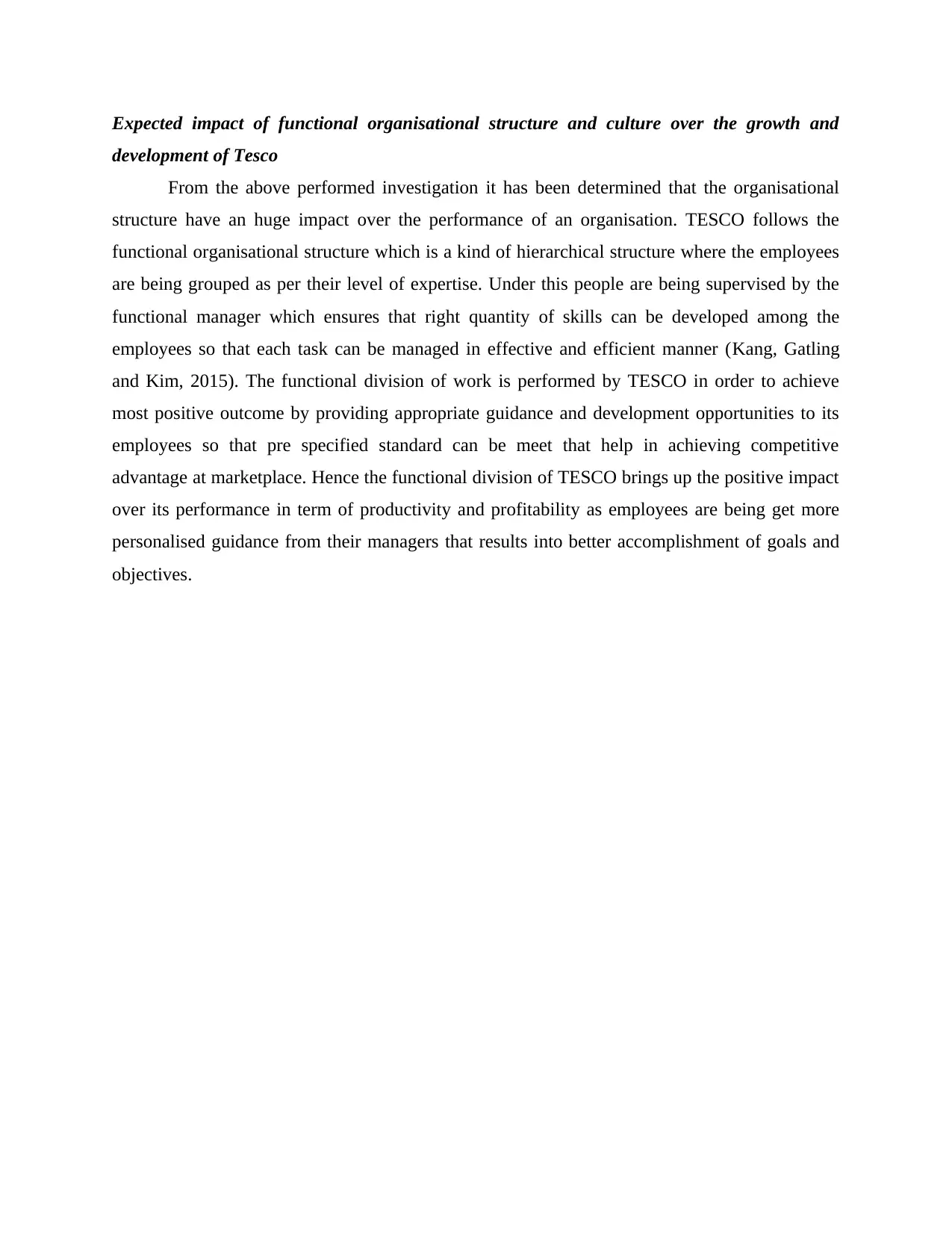
Expected impact of functional organisational structure and culture over the growth and
development of Tesco
From the above performed investigation it has been determined that the organisational
structure have an huge impact over the performance of an organisation. TESCO follows the
functional organisational structure which is a kind of hierarchical structure where the employees
are being grouped as per their level of expertise. Under this people are being supervised by the
functional manager which ensures that right quantity of skills can be developed among the
employees so that each task can be managed in effective and efficient manner (Kang, Gatling
and Kim, 2015). The functional division of work is performed by TESCO in order to achieve
most positive outcome by providing appropriate guidance and development opportunities to its
employees so that pre specified standard can be meet that help in achieving competitive
advantage at marketplace. Hence the functional division of TESCO brings up the positive impact
over its performance in term of productivity and profitability as employees are being get more
personalised guidance from their managers that results into better accomplishment of goals and
objectives.
development of Tesco
From the above performed investigation it has been determined that the organisational
structure have an huge impact over the performance of an organisation. TESCO follows the
functional organisational structure which is a kind of hierarchical structure where the employees
are being grouped as per their level of expertise. Under this people are being supervised by the
functional manager which ensures that right quantity of skills can be developed among the
employees so that each task can be managed in effective and efficient manner (Kang, Gatling
and Kim, 2015). The functional division of work is performed by TESCO in order to achieve
most positive outcome by providing appropriate guidance and development opportunities to its
employees so that pre specified standard can be meet that help in achieving competitive
advantage at marketplace. Hence the functional division of TESCO brings up the positive impact
over its performance in term of productivity and profitability as employees are being get more
personalised guidance from their managers that results into better accomplishment of goals and
objectives.
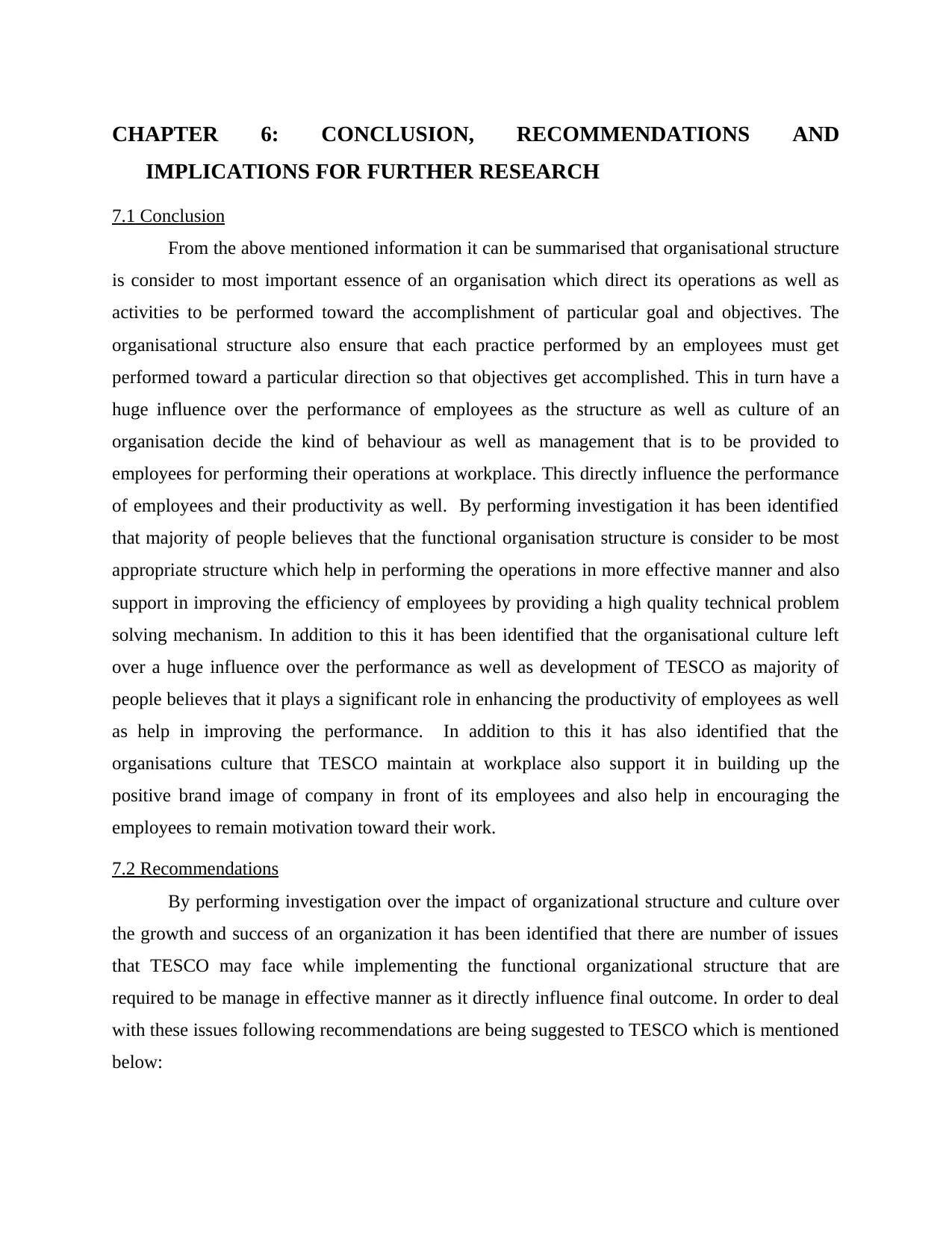
CHAPTER 6: CONCLUSION, RECOMMENDATIONS AND
IMPLICATIONS FOR FURTHER RESEARCH
7.1 Conclusion
From the above mentioned information it can be summarised that organisational structure
is consider to most important essence of an organisation which direct its operations as well as
activities to be performed toward the accomplishment of particular goal and objectives. The
organisational structure also ensure that each practice performed by an employees must get
performed toward a particular direction so that objectives get accomplished. This in turn have a
huge influence over the performance of employees as the structure as well as culture of an
organisation decide the kind of behaviour as well as management that is to be provided to
employees for performing their operations at workplace. This directly influence the performance
of employees and their productivity as well. By performing investigation it has been identified
that majority of people believes that the functional organisation structure is consider to be most
appropriate structure which help in performing the operations in more effective manner and also
support in improving the efficiency of employees by providing a high quality technical problem
solving mechanism. In addition to this it has been identified that the organisational culture left
over a huge influence over the performance as well as development of TESCO as majority of
people believes that it plays a significant role in enhancing the productivity of employees as well
as help in improving the performance. In addition to this it has also identified that the
organisations culture that TESCO maintain at workplace also support it in building up the
positive brand image of company in front of its employees and also help in encouraging the
employees to remain motivation toward their work.
7.2 Recommendations
By performing investigation over the impact of organizational structure and culture over
the growth and success of an organization it has been identified that there are number of issues
that TESCO may face while implementing the functional organizational structure that are
required to be manage in effective manner as it directly influence final outcome. In order to deal
with these issues following recommendations are being suggested to TESCO which is mentioned
below:
IMPLICATIONS FOR FURTHER RESEARCH
7.1 Conclusion
From the above mentioned information it can be summarised that organisational structure
is consider to most important essence of an organisation which direct its operations as well as
activities to be performed toward the accomplishment of particular goal and objectives. The
organisational structure also ensure that each practice performed by an employees must get
performed toward a particular direction so that objectives get accomplished. This in turn have a
huge influence over the performance of employees as the structure as well as culture of an
organisation decide the kind of behaviour as well as management that is to be provided to
employees for performing their operations at workplace. This directly influence the performance
of employees and their productivity as well. By performing investigation it has been identified
that majority of people believes that the functional organisation structure is consider to be most
appropriate structure which help in performing the operations in more effective manner and also
support in improving the efficiency of employees by providing a high quality technical problem
solving mechanism. In addition to this it has been identified that the organisational culture left
over a huge influence over the performance as well as development of TESCO as majority of
people believes that it plays a significant role in enhancing the productivity of employees as well
as help in improving the performance. In addition to this it has also identified that the
organisations culture that TESCO maintain at workplace also support it in building up the
positive brand image of company in front of its employees and also help in encouraging the
employees to remain motivation toward their work.
7.2 Recommendations
By performing investigation over the impact of organizational structure and culture over
the growth and success of an organization it has been identified that there are number of issues
that TESCO may face while implementing the functional organizational structure that are
required to be manage in effective manner as it directly influence final outcome. In order to deal
with these issues following recommendations are being suggested to TESCO which is mentioned
below:
Secure Best Marks with AI Grader
Need help grading? Try our AI Grader for instant feedback on your assignments.
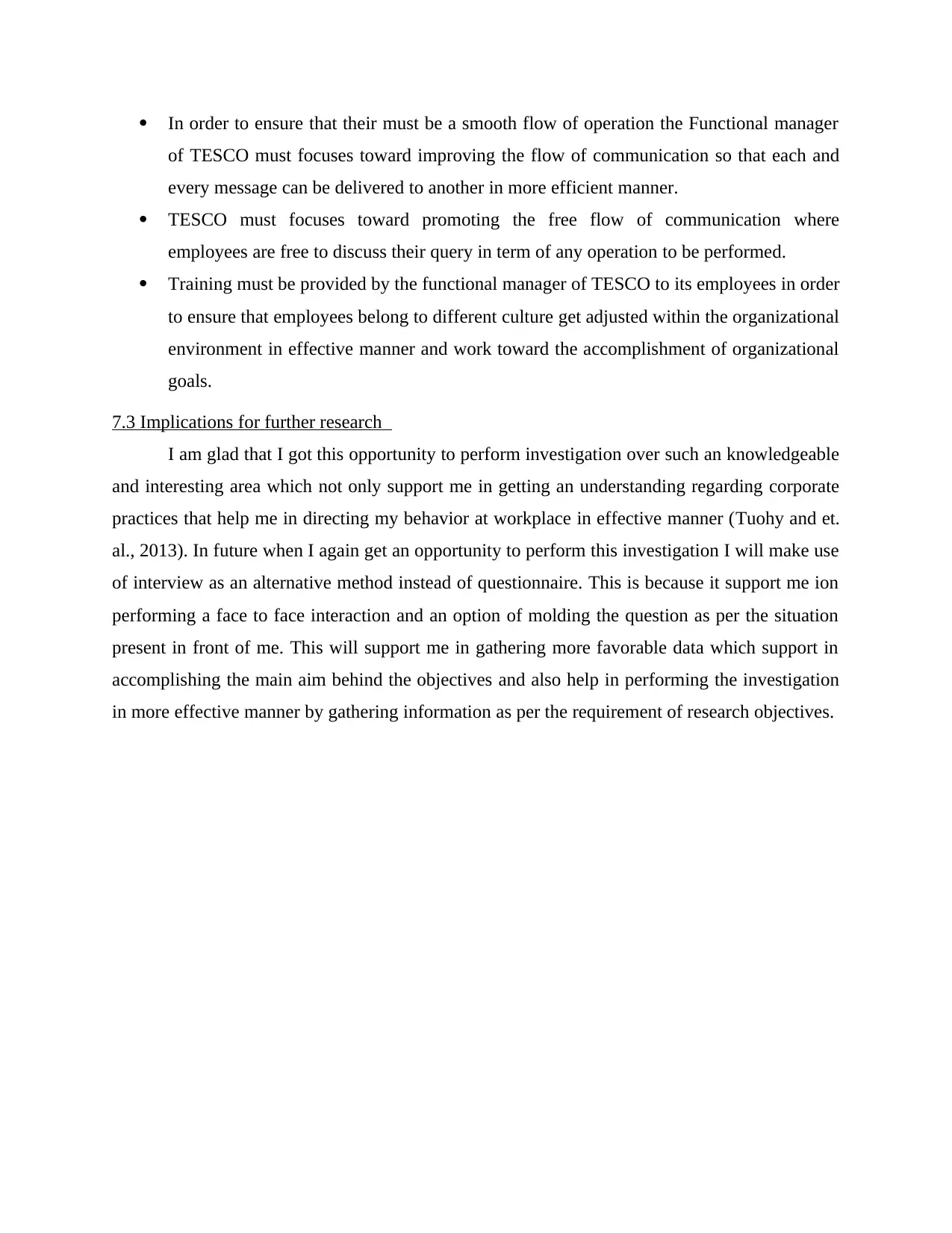
In order to ensure that their must be a smooth flow of operation the Functional manager
of TESCO must focuses toward improving the flow of communication so that each and
every message can be delivered to another in more efficient manner.
TESCO must focuses toward promoting the free flow of communication where
employees are free to discuss their query in term of any operation to be performed.
Training must be provided by the functional manager of TESCO to its employees in order
to ensure that employees belong to different culture get adjusted within the organizational
environment in effective manner and work toward the accomplishment of organizational
goals.
7.3 Implications for further research
I am glad that I got this opportunity to perform investigation over such an knowledgeable
and interesting area which not only support me in getting an understanding regarding corporate
practices that help me in directing my behavior at workplace in effective manner (Tuohy and et.
al., 2013). In future when I again get an opportunity to perform this investigation I will make use
of interview as an alternative method instead of questionnaire. This is because it support me ion
performing a face to face interaction and an option of molding the question as per the situation
present in front of me. This will support me in gathering more favorable data which support in
accomplishing the main aim behind the objectives and also help in performing the investigation
in more effective manner by gathering information as per the requirement of research objectives.
of TESCO must focuses toward improving the flow of communication so that each and
every message can be delivered to another in more efficient manner.
TESCO must focuses toward promoting the free flow of communication where
employees are free to discuss their query in term of any operation to be performed.
Training must be provided by the functional manager of TESCO to its employees in order
to ensure that employees belong to different culture get adjusted within the organizational
environment in effective manner and work toward the accomplishment of organizational
goals.
7.3 Implications for further research
I am glad that I got this opportunity to perform investigation over such an knowledgeable
and interesting area which not only support me in getting an understanding regarding corporate
practices that help me in directing my behavior at workplace in effective manner (Tuohy and et.
al., 2013). In future when I again get an opportunity to perform this investigation I will make use
of interview as an alternative method instead of questionnaire. This is because it support me ion
performing a face to face interaction and an option of molding the question as per the situation
present in front of me. This will support me in gathering more favorable data which support in
accomplishing the main aim behind the objectives and also help in performing the investigation
in more effective manner by gathering information as per the requirement of research objectives.
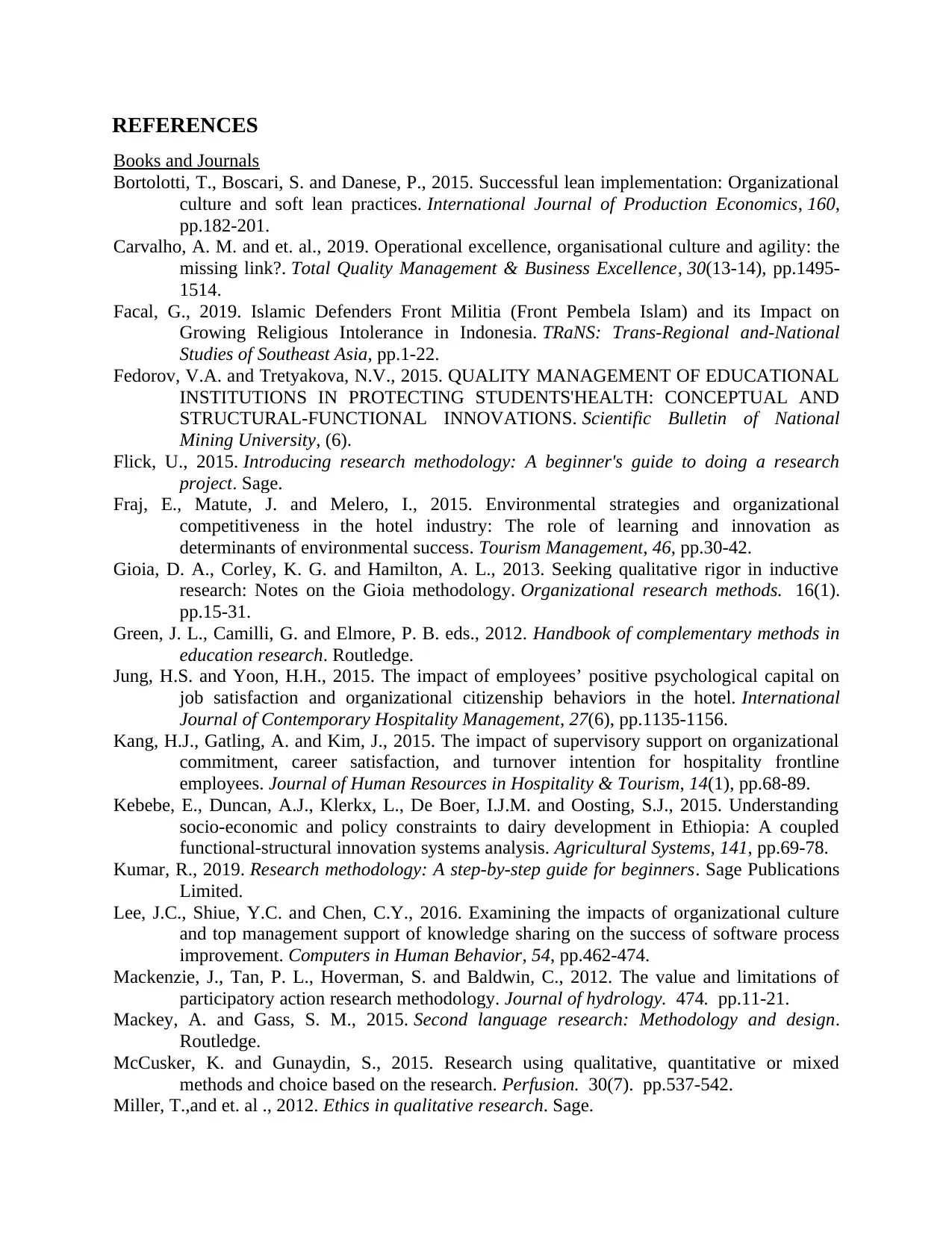
REFERENCES
Books and Journals
Bortolotti, T., Boscari, S. and Danese, P., 2015. Successful lean implementation: Organizational
culture and soft lean practices. International Journal of Production Economics, 160,
pp.182-201.
Carvalho, A. M. and et. al., 2019. Operational excellence, organisational culture and agility: the
missing link?. Total Quality Management & Business Excellence, 30(13-14), pp.1495-
1514.
Facal, G., 2019. Islamic Defenders Front Militia (Front Pembela Islam) and its Impact on
Growing Religious Intolerance in Indonesia. TRaNS: Trans-Regional and-National
Studies of Southeast Asia, pp.1-22.
Fedorov, V.A. and Tretyakova, N.V., 2015. QUALITY MANAGEMENT OF EDUCATIONAL
INSTITUTIONS IN PROTECTING STUDENTS'HEALTH: CONCEPTUAL AND
STRUCTURAL-FUNCTIONAL INNOVATIONS. Scientific Bulletin of National
Mining University, (6).
Flick, U., 2015. Introducing research methodology: A beginner's guide to doing a research
project. Sage.
Fraj, E., Matute, J. and Melero, I., 2015. Environmental strategies and organizational
competitiveness in the hotel industry: The role of learning and innovation as
determinants of environmental success. Tourism Management, 46, pp.30-42.
Gioia, D. A., Corley, K. G. and Hamilton, A. L., 2013. Seeking qualitative rigor in inductive
research: Notes on the Gioia methodology. Organizational research methods. 16(1).
pp.15-31.
Green, J. L., Camilli, G. and Elmore, P. B. eds., 2012. Handbook of complementary methods in
education research. Routledge.
Jung, H.S. and Yoon, H.H., 2015. The impact of employees’ positive psychological capital on
job satisfaction and organizational citizenship behaviors in the hotel. International
Journal of Contemporary Hospitality Management, 27(6), pp.1135-1156.
Kang, H.J., Gatling, A. and Kim, J., 2015. The impact of supervisory support on organizational
commitment, career satisfaction, and turnover intention for hospitality frontline
employees. Journal of Human Resources in Hospitality & Tourism, 14(1), pp.68-89.
Kebebe, E., Duncan, A.J., Klerkx, L., De Boer, I.J.M. and Oosting, S.J., 2015. Understanding
socio-economic and policy constraints to dairy development in Ethiopia: A coupled
functional-structural innovation systems analysis. Agricultural Systems, 141, pp.69-78.
Kumar, R., 2019. Research methodology: A step-by-step guide for beginners. Sage Publications
Limited.
Lee, J.C., Shiue, Y.C. and Chen, C.Y., 2016. Examining the impacts of organizational culture
and top management support of knowledge sharing on the success of software process
improvement. Computers in Human Behavior, 54, pp.462-474.
Mackenzie, J., Tan, P. L., Hoverman, S. and Baldwin, C., 2012. The value and limitations of
participatory action research methodology. Journal of hydrology. 474. pp.11-21.
Mackey, A. and Gass, S. M., 2015. Second language research: Methodology and design.
Routledge.
McCusker, K. and Gunaydin, S., 2015. Research using qualitative, quantitative or mixed
methods and choice based on the research. Perfusion. 30(7). pp.537-542.
Miller, T.,and et. al ., 2012. Ethics in qualitative research. Sage.
Books and Journals
Bortolotti, T., Boscari, S. and Danese, P., 2015. Successful lean implementation: Organizational
culture and soft lean practices. International Journal of Production Economics, 160,
pp.182-201.
Carvalho, A. M. and et. al., 2019. Operational excellence, organisational culture and agility: the
missing link?. Total Quality Management & Business Excellence, 30(13-14), pp.1495-
1514.
Facal, G., 2019. Islamic Defenders Front Militia (Front Pembela Islam) and its Impact on
Growing Religious Intolerance in Indonesia. TRaNS: Trans-Regional and-National
Studies of Southeast Asia, pp.1-22.
Fedorov, V.A. and Tretyakova, N.V., 2015. QUALITY MANAGEMENT OF EDUCATIONAL
INSTITUTIONS IN PROTECTING STUDENTS'HEALTH: CONCEPTUAL AND
STRUCTURAL-FUNCTIONAL INNOVATIONS. Scientific Bulletin of National
Mining University, (6).
Flick, U., 2015. Introducing research methodology: A beginner's guide to doing a research
project. Sage.
Fraj, E., Matute, J. and Melero, I., 2015. Environmental strategies and organizational
competitiveness in the hotel industry: The role of learning and innovation as
determinants of environmental success. Tourism Management, 46, pp.30-42.
Gioia, D. A., Corley, K. G. and Hamilton, A. L., 2013. Seeking qualitative rigor in inductive
research: Notes on the Gioia methodology. Organizational research methods. 16(1).
pp.15-31.
Green, J. L., Camilli, G. and Elmore, P. B. eds., 2012. Handbook of complementary methods in
education research. Routledge.
Jung, H.S. and Yoon, H.H., 2015. The impact of employees’ positive psychological capital on
job satisfaction and organizational citizenship behaviors in the hotel. International
Journal of Contemporary Hospitality Management, 27(6), pp.1135-1156.
Kang, H.J., Gatling, A. and Kim, J., 2015. The impact of supervisory support on organizational
commitment, career satisfaction, and turnover intention for hospitality frontline
employees. Journal of Human Resources in Hospitality & Tourism, 14(1), pp.68-89.
Kebebe, E., Duncan, A.J., Klerkx, L., De Boer, I.J.M. and Oosting, S.J., 2015. Understanding
socio-economic and policy constraints to dairy development in Ethiopia: A coupled
functional-structural innovation systems analysis. Agricultural Systems, 141, pp.69-78.
Kumar, R., 2019. Research methodology: A step-by-step guide for beginners. Sage Publications
Limited.
Lee, J.C., Shiue, Y.C. and Chen, C.Y., 2016. Examining the impacts of organizational culture
and top management support of knowledge sharing on the success of software process
improvement. Computers in Human Behavior, 54, pp.462-474.
Mackenzie, J., Tan, P. L., Hoverman, S. and Baldwin, C., 2012. The value and limitations of
participatory action research methodology. Journal of hydrology. 474. pp.11-21.
Mackey, A. and Gass, S. M., 2015. Second language research: Methodology and design.
Routledge.
McCusker, K. and Gunaydin, S., 2015. Research using qualitative, quantitative or mixed
methods and choice based on the research. Perfusion. 30(7). pp.537-542.
Miller, T.,and et. al ., 2012. Ethics in qualitative research. Sage.
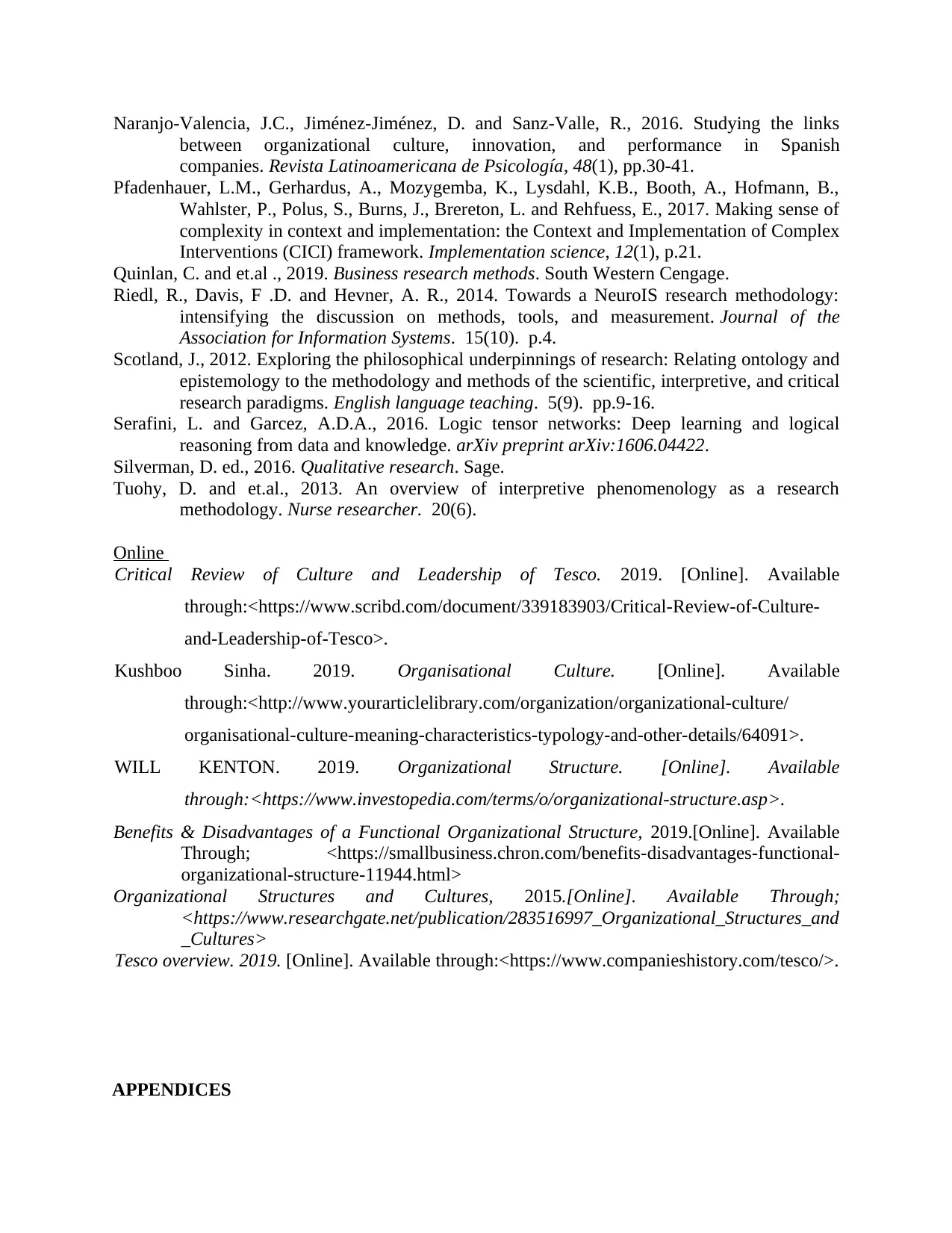
Naranjo-Valencia, J.C., Jiménez-Jiménez, D. and Sanz-Valle, R., 2016. Studying the links
between organizational culture, innovation, and performance in Spanish
companies. Revista Latinoamericana de Psicología, 48(1), pp.30-41.
Pfadenhauer, L.M., Gerhardus, A., Mozygemba, K., Lysdahl, K.B., Booth, A., Hofmann, B.,
Wahlster, P., Polus, S., Burns, J., Brereton, L. and Rehfuess, E., 2017. Making sense of
complexity in context and implementation: the Context and Implementation of Complex
Interventions (CICI) framework. Implementation science, 12(1), p.21.
Quinlan, C. and et.al ., 2019. Business research methods. South Western Cengage.
Riedl, R., Davis, F .D. and Hevner, A. R., 2014. Towards a NeuroIS research methodology:
intensifying the discussion on methods, tools, and measurement. Journal of the
Association for Information Systems. 15(10). p.4.
Scotland, J., 2012. Exploring the philosophical underpinnings of research: Relating ontology and
epistemology to the methodology and methods of the scientific, interpretive, and critical
research paradigms. English language teaching. 5(9). pp.9-16.
Serafini, L. and Garcez, A.D.A., 2016. Logic tensor networks: Deep learning and logical
reasoning from data and knowledge. arXiv preprint arXiv:1606.04422.
Silverman, D. ed., 2016. Qualitative research. Sage.
Tuohy, D. and et.al., 2013. An overview of interpretive phenomenology as a research
methodology. Nurse researcher. 20(6).
Online
Critical Review of Culture and Leadership of Tesco. 2019. [Online]. Available
through:<https://www.scribd.com/document/339183903/Critical-Review-of-Culture-
and-Leadership-of-Tesco>.
Kushboo Sinha. 2019. Organisational Culture. [Online]. Available
through:<http://www.yourarticlelibrary.com/organization/organizational-culture/
organisational-culture-meaning-characteristics-typology-and-other-details/64091>.
WILL KENTON. 2019. Organizational Structure. [Online]. Available
through:<https://www.investopedia.com/terms/o/organizational-structure.asp>.
Benefits & Disadvantages of a Functional Organizational Structure, 2019.[Online]. Available
Through; <https://smallbusiness.chron.com/benefits-disadvantages-functional-
organizational-structure-11944.html>
Organizational Structures and Cultures, 2015.[Online]. Available Through;
<https://www.researchgate.net/publication/283516997_Organizational_Structures_and
_Cultures>
Tesco overview. 2019. [Online]. Available through:<https://www.companieshistory.com/tesco/>.
APPENDICES
between organizational culture, innovation, and performance in Spanish
companies. Revista Latinoamericana de Psicología, 48(1), pp.30-41.
Pfadenhauer, L.M., Gerhardus, A., Mozygemba, K., Lysdahl, K.B., Booth, A., Hofmann, B.,
Wahlster, P., Polus, S., Burns, J., Brereton, L. and Rehfuess, E., 2017. Making sense of
complexity in context and implementation: the Context and Implementation of Complex
Interventions (CICI) framework. Implementation science, 12(1), p.21.
Quinlan, C. and et.al ., 2019. Business research methods. South Western Cengage.
Riedl, R., Davis, F .D. and Hevner, A. R., 2014. Towards a NeuroIS research methodology:
intensifying the discussion on methods, tools, and measurement. Journal of the
Association for Information Systems. 15(10). p.4.
Scotland, J., 2012. Exploring the philosophical underpinnings of research: Relating ontology and
epistemology to the methodology and methods of the scientific, interpretive, and critical
research paradigms. English language teaching. 5(9). pp.9-16.
Serafini, L. and Garcez, A.D.A., 2016. Logic tensor networks: Deep learning and logical
reasoning from data and knowledge. arXiv preprint arXiv:1606.04422.
Silverman, D. ed., 2016. Qualitative research. Sage.
Tuohy, D. and et.al., 2013. An overview of interpretive phenomenology as a research
methodology. Nurse researcher. 20(6).
Online
Critical Review of Culture and Leadership of Tesco. 2019. [Online]. Available
through:<https://www.scribd.com/document/339183903/Critical-Review-of-Culture-
and-Leadership-of-Tesco>.
Kushboo Sinha. 2019. Organisational Culture. [Online]. Available
through:<http://www.yourarticlelibrary.com/organization/organizational-culture/
organisational-culture-meaning-characteristics-typology-and-other-details/64091>.
WILL KENTON. 2019. Organizational Structure. [Online]. Available
through:<https://www.investopedia.com/terms/o/organizational-structure.asp>.
Benefits & Disadvantages of a Functional Organizational Structure, 2019.[Online]. Available
Through; <https://smallbusiness.chron.com/benefits-disadvantages-functional-
organizational-structure-11944.html>
Organizational Structures and Cultures, 2015.[Online]. Available Through;
<https://www.researchgate.net/publication/283516997_Organizational_Structures_and
_Cultures>
Tesco overview. 2019. [Online]. Available through:<https://www.companieshistory.com/tesco/>.
APPENDICES
Paraphrase This Document
Need a fresh take? Get an instant paraphrase of this document with our AI Paraphraser
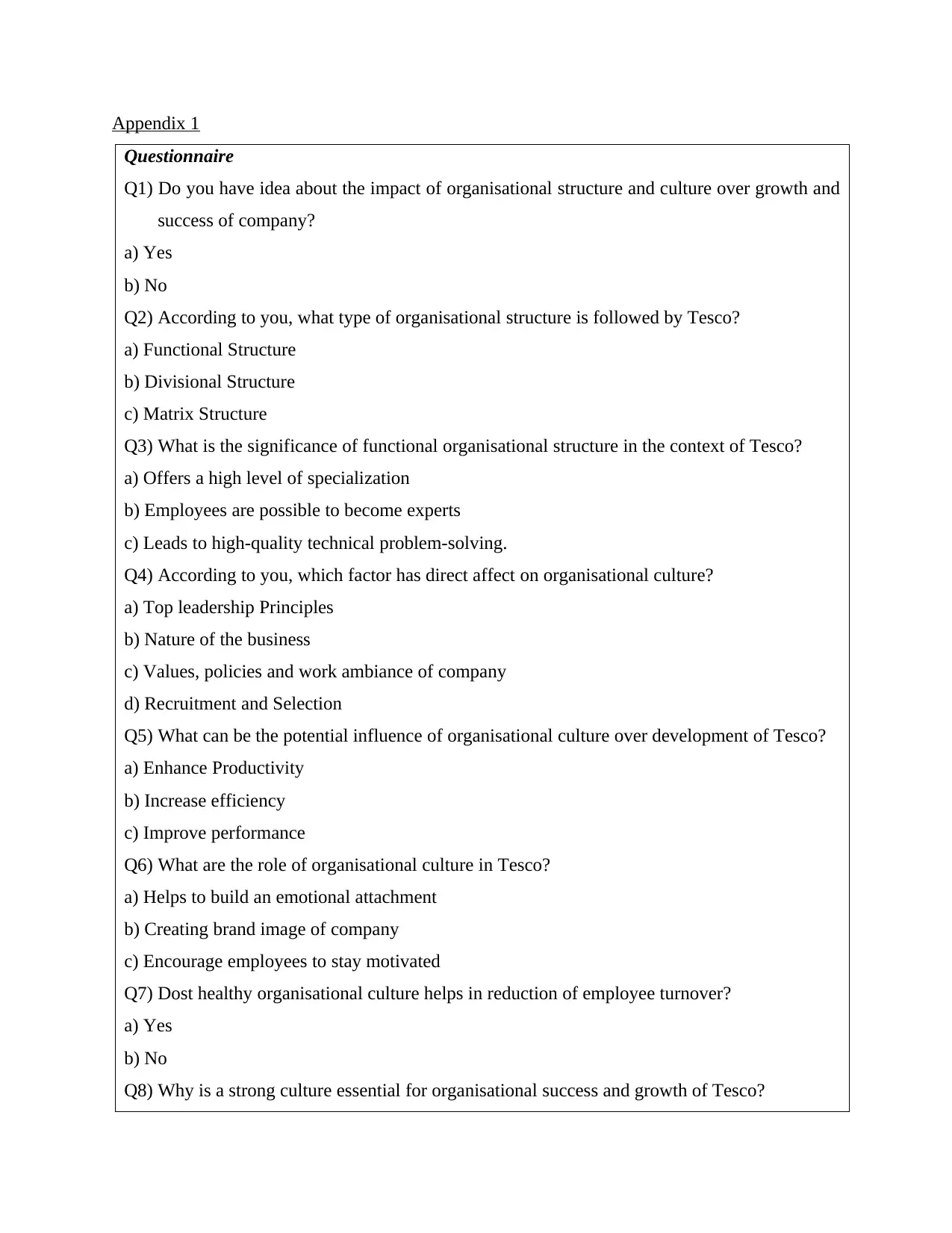
Appendix 1
Questionnaire
Q1) Do you have idea about the impact of organisational structure and culture over growth and
success of company?
a) Yes
b) No
Q2) According to you, what type of organisational structure is followed by Tesco?
a) Functional Structure
b) Divisional Structure
c) Matrix Structure
Q3) What is the significance of functional organisational structure in the context of Tesco?
a) Offers a high level of specialization
b) Employees are possible to become experts
c) Leads to high-quality technical problem-solving.
Q4) According to you, which factor has direct affect on organisational culture?
a) Top leadership Principles
b) Nature of the business
c) Values, policies and work ambiance of company
d) Recruitment and Selection
Q5) What can be the potential influence of organisational culture over development of Tesco?
a) Enhance Productivity
b) Increase efficiency
c) Improve performance
Q6) What are the role of organisational culture in Tesco?
a) Helps to build an emotional attachment
b) Creating brand image of company
c) Encourage employees to stay motivated
Q7) Dost healthy organisational culture helps in reduction of employee turnover?
a) Yes
b) No
Q8) Why is a strong culture essential for organisational success and growth of Tesco?
Questionnaire
Q1) Do you have idea about the impact of organisational structure and culture over growth and
success of company?
a) Yes
b) No
Q2) According to you, what type of organisational structure is followed by Tesco?
a) Functional Structure
b) Divisional Structure
c) Matrix Structure
Q3) What is the significance of functional organisational structure in the context of Tesco?
a) Offers a high level of specialization
b) Employees are possible to become experts
c) Leads to high-quality technical problem-solving.
Q4) According to you, which factor has direct affect on organisational culture?
a) Top leadership Principles
b) Nature of the business
c) Values, policies and work ambiance of company
d) Recruitment and Selection
Q5) What can be the potential influence of organisational culture over development of Tesco?
a) Enhance Productivity
b) Increase efficiency
c) Improve performance
Q6) What are the role of organisational culture in Tesco?
a) Helps to build an emotional attachment
b) Creating brand image of company
c) Encourage employees to stay motivated
Q7) Dost healthy organisational culture helps in reduction of employee turnover?
a) Yes
b) No
Q8) Why is a strong culture essential for organisational success and growth of Tesco?
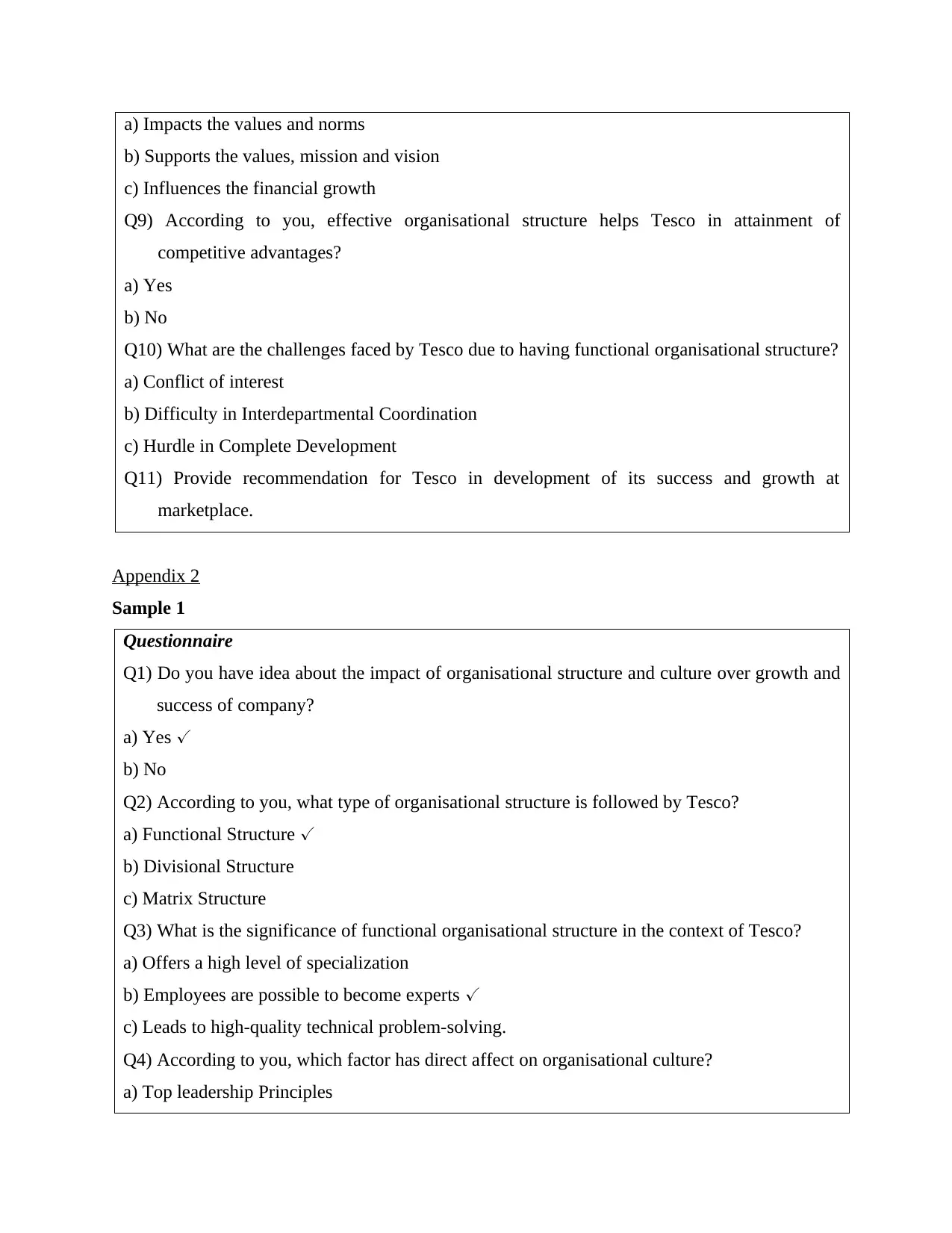
a) Impacts the values and norms
b) Supports the values, mission and vision
c) Influences the financial growth
Q9) According to you, effective organisational structure helps Tesco in attainment of
competitive advantages?
a) Yes
b) No
Q10) What are the challenges faced by Tesco due to having functional organisational structure?
a) Conflict of interest
b) Difficulty in Interdepartmental Coordination
c) Hurdle in Complete Development
Q11) Provide recommendation for Tesco in development of its success and growth at
marketplace.
Appendix 2
Sample 1
Questionnaire
Q1) Do you have idea about the impact of organisational structure and culture over growth and
success of company?
a) Yes ✓
b) No
Q2) According to you, what type of organisational structure is followed by Tesco?
a) Functional Structure ✓
b) Divisional Structure
c) Matrix Structure
Q3) What is the significance of functional organisational structure in the context of Tesco?
a) Offers a high level of specialization
b) Employees are possible to become experts ✓
c) Leads to high-quality technical problem-solving.
Q4) According to you, which factor has direct affect on organisational culture?
a) Top leadership Principles
b) Supports the values, mission and vision
c) Influences the financial growth
Q9) According to you, effective organisational structure helps Tesco in attainment of
competitive advantages?
a) Yes
b) No
Q10) What are the challenges faced by Tesco due to having functional organisational structure?
a) Conflict of interest
b) Difficulty in Interdepartmental Coordination
c) Hurdle in Complete Development
Q11) Provide recommendation for Tesco in development of its success and growth at
marketplace.
Appendix 2
Sample 1
Questionnaire
Q1) Do you have idea about the impact of organisational structure and culture over growth and
success of company?
a) Yes ✓
b) No
Q2) According to you, what type of organisational structure is followed by Tesco?
a) Functional Structure ✓
b) Divisional Structure
c) Matrix Structure
Q3) What is the significance of functional organisational structure in the context of Tesco?
a) Offers a high level of specialization
b) Employees are possible to become experts ✓
c) Leads to high-quality technical problem-solving.
Q4) According to you, which factor has direct affect on organisational culture?
a) Top leadership Principles
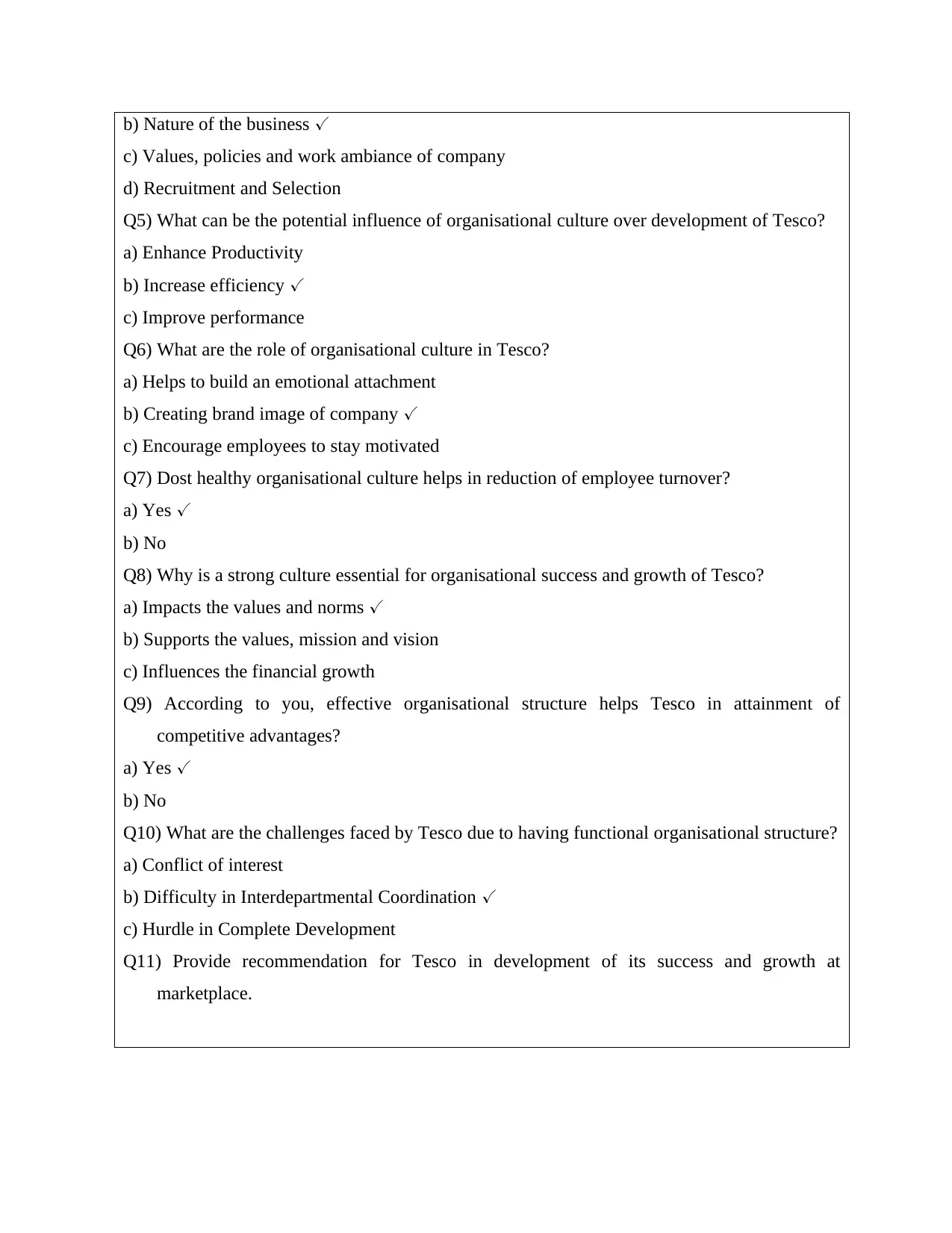
b) Nature of the business ✓
c) Values, policies and work ambiance of company
d) Recruitment and Selection
Q5) What can be the potential influence of organisational culture over development of Tesco?
a) Enhance Productivity
b) Increase efficiency ✓
c) Improve performance
Q6) What are the role of organisational culture in Tesco?
a) Helps to build an emotional attachment
b) Creating brand image of company ✓
c) Encourage employees to stay motivated
Q7) Dost healthy organisational culture helps in reduction of employee turnover?
a) Yes ✓
b) No
Q8) Why is a strong culture essential for organisational success and growth of Tesco?
a) Impacts the values and norms ✓
b) Supports the values, mission and vision
c) Influences the financial growth
Q9) According to you, effective organisational structure helps Tesco in attainment of
competitive advantages?
a) Yes ✓
b) No
Q10) What are the challenges faced by Tesco due to having functional organisational structure?
a) Conflict of interest
b) Difficulty in Interdepartmental Coordination ✓
c) Hurdle in Complete Development
Q11) Provide recommendation for Tesco in development of its success and growth at
marketplace.
c) Values, policies and work ambiance of company
d) Recruitment and Selection
Q5) What can be the potential influence of organisational culture over development of Tesco?
a) Enhance Productivity
b) Increase efficiency ✓
c) Improve performance
Q6) What are the role of organisational culture in Tesco?
a) Helps to build an emotional attachment
b) Creating brand image of company ✓
c) Encourage employees to stay motivated
Q7) Dost healthy organisational culture helps in reduction of employee turnover?
a) Yes ✓
b) No
Q8) Why is a strong culture essential for organisational success and growth of Tesco?
a) Impacts the values and norms ✓
b) Supports the values, mission and vision
c) Influences the financial growth
Q9) According to you, effective organisational structure helps Tesco in attainment of
competitive advantages?
a) Yes ✓
b) No
Q10) What are the challenges faced by Tesco due to having functional organisational structure?
a) Conflict of interest
b) Difficulty in Interdepartmental Coordination ✓
c) Hurdle in Complete Development
Q11) Provide recommendation for Tesco in development of its success and growth at
marketplace.
Secure Best Marks with AI Grader
Need help grading? Try our AI Grader for instant feedback on your assignments.

Sample 2
Questionnaire
Q1) Do you have idea about the impact of organisational structure and culture over growth and
success of company?
a) Yes ✓
b) No
Q2) According to you, what type of organisational structure is followed by Tesco?
a) Functional Structure
b) Divisional Structure ✓
c) Matrix Structure
Q3) What is the significance of functional organisational structure in the context of Tesco?
a) Offers a high level of specialization
b) Employees are possible to become experts
c) Leads to high-quality technical problem-solving. ✓
Q4) According to you, which factor has direct affect on organisational culture?
a) Top leadership Principles ✓
b) Nature of the business
c) Values, policies and work ambiance of company
d) Recruitment and Selection
Q5) What can be the potential influence of organisational culture over development of Tesco?
a) Enhance Productivity ✓
b) Increase efficiency
c) Improve performance
Q6) What are the role of organisational culture in Tesco?
a) Helps to build an emotional attachment ✓
b) Creating brand image of company
c) Encourage employees to stay motivated
Q7) Dost healthy organisational culture helps in reduction of employee turnover?
a) Yes ✓
b) No
Q8) Why is a strong culture essential for organisational success and growth of Tesco?
Questionnaire
Q1) Do you have idea about the impact of organisational structure and culture over growth and
success of company?
a) Yes ✓
b) No
Q2) According to you, what type of organisational structure is followed by Tesco?
a) Functional Structure
b) Divisional Structure ✓
c) Matrix Structure
Q3) What is the significance of functional organisational structure in the context of Tesco?
a) Offers a high level of specialization
b) Employees are possible to become experts
c) Leads to high-quality technical problem-solving. ✓
Q4) According to you, which factor has direct affect on organisational culture?
a) Top leadership Principles ✓
b) Nature of the business
c) Values, policies and work ambiance of company
d) Recruitment and Selection
Q5) What can be the potential influence of organisational culture over development of Tesco?
a) Enhance Productivity ✓
b) Increase efficiency
c) Improve performance
Q6) What are the role of organisational culture in Tesco?
a) Helps to build an emotional attachment ✓
b) Creating brand image of company
c) Encourage employees to stay motivated
Q7) Dost healthy organisational culture helps in reduction of employee turnover?
a) Yes ✓
b) No
Q8) Why is a strong culture essential for organisational success and growth of Tesco?

a) Impacts the values and norms ✓
b) Supports the values, mission and vision
c) Influences the financial growth
Q9) According to you, effective organisational structure helps Tesco in attainment of
competitive advantages?
a) Yes ✓
b) No
Q10) What are the challenges faced by Tesco due to having functional organisational structure?
a) Conflict of interest ✓
b) Difficulty in Interdepartmental Coordination
c) Hurdle in Complete Development
Q11) Provide recommendation for Tesco in development of its success and growth at
marketplace.
b) Supports the values, mission and vision
c) Influences the financial growth
Q9) According to you, effective organisational structure helps Tesco in attainment of
competitive advantages?
a) Yes ✓
b) No
Q10) What are the challenges faced by Tesco due to having functional organisational structure?
a) Conflict of interest ✓
b) Difficulty in Interdepartmental Coordination
c) Hurdle in Complete Development
Q11) Provide recommendation for Tesco in development of its success and growth at
marketplace.
1 out of 48
Related Documents
Your All-in-One AI-Powered Toolkit for Academic Success.
+13062052269
info@desklib.com
Available 24*7 on WhatsApp / Email
![[object Object]](/_next/static/media/star-bottom.7253800d.svg)
Unlock your academic potential
© 2024 | Zucol Services PVT LTD | All rights reserved.





